Holy roman emperor ferdinand ii Stock Photos and Images
(421)See holy roman emperor ferdinand ii stock video clipsQuick filters:
Holy roman emperor ferdinand ii Stock Photos and Images
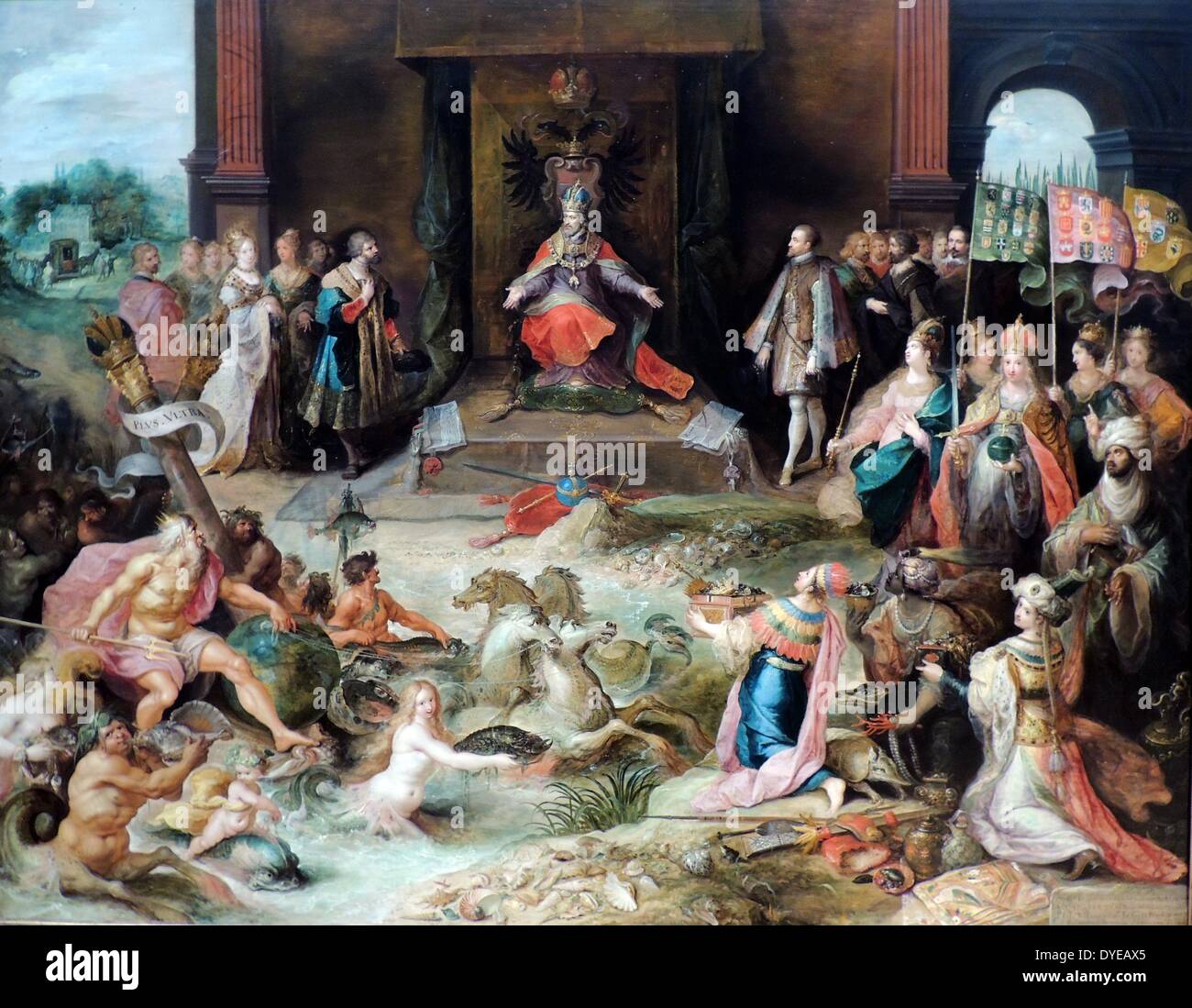 Allegory on the Abdication of Emperor Charles V in Brussels. Frans Francken II (1581-1642) oil on panel, (c 1630-1640) Charles V is enthroned at centre. Battle weary and wracked by illness, in 1555 he divided up his empire. He gave his brother Ferdinand (left of the throne) the Holy Roman Empire, while his son Phillip (at the right) became King of Spain and Lord of the Netherlands. The four figures in the right foreground personify the continents over which Charles's vast empire stretched. Neptune (left) symbolized his power at sea. Stock Photohttps://www.alamy.com/image-license-details/?v=1https://www.alamy.com/allegory-on-the-abdication-of-emperor-charles-v-in-brussels-frans-image68542717.html
Allegory on the Abdication of Emperor Charles V in Brussels. Frans Francken II (1581-1642) oil on panel, (c 1630-1640) Charles V is enthroned at centre. Battle weary and wracked by illness, in 1555 he divided up his empire. He gave his brother Ferdinand (left of the throne) the Holy Roman Empire, while his son Phillip (at the right) became King of Spain and Lord of the Netherlands. The four figures in the right foreground personify the continents over which Charles's vast empire stretched. Neptune (left) symbolized his power at sea. Stock Photohttps://www.alamy.com/image-license-details/?v=1https://www.alamy.com/allegory-on-the-abdication-of-emperor-charles-v-in-brussels-frans-image68542717.htmlRMDYEAX5–Allegory on the Abdication of Emperor Charles V in Brussels. Frans Francken II (1581-1642) oil on panel, (c 1630-1640) Charles V is enthroned at centre. Battle weary and wracked by illness, in 1555 he divided up his empire. He gave his brother Ferdinand (left of the throne) the Holy Roman Empire, while his son Phillip (at the right) became King of Spain and Lord of the Netherlands. The four figures in the right foreground personify the continents over which Charles's vast empire stretched. Neptune (left) symbolized his power at sea.
 Portrait of Holy Roman Emperor Ferdinand II, engraving, Austria 1806 Stock Photohttps://www.alamy.com/image-license-details/?v=1https://www.alamy.com/portrait-of-holy-roman-emperor-ferdinand-ii-engraving-austria-1806-image553740241.html
Portrait of Holy Roman Emperor Ferdinand II, engraving, Austria 1806 Stock Photohttps://www.alamy.com/image-license-details/?v=1https://www.alamy.com/portrait-of-holy-roman-emperor-ferdinand-ii-engraving-austria-1806-image553740241.htmlRF2R4W195–Portrait of Holy Roman Emperor Ferdinand II, engraving, Austria 1806
 Study for the 'Essequie' Conducted in San Lorenzo, Florence, in 1637 in Honour of Holy Roman Emperor Ferdinand II, 1637. Alfonso Parigi (Italian, 1606-1656). Pen and brown ink and brown wash with graphite and accents of pink, purple-grey and deep blue-black wash; sheet: 48.5 x 65.8 cm (19 1/8 x 25 7/8 in Stock Photohttps://www.alamy.com/image-license-details/?v=1https://www.alamy.com/study-for-the-essequie-conducted-in-san-lorenzo-florence-in-1637-in-honour-of-holy-roman-emperor-ferdinand-ii-1637-alfonso-parigi-italian-1606-1656-pen-and-brown-ink-and-brown-wash-with-graphite-and-accents-of-pink-purple-grey-and-deep-blue-black-wash-sheet-485-x-658-cm-19-18-x-25-78-in-image240504929.html
Study for the 'Essequie' Conducted in San Lorenzo, Florence, in 1637 in Honour of Holy Roman Emperor Ferdinand II, 1637. Alfonso Parigi (Italian, 1606-1656). Pen and brown ink and brown wash with graphite and accents of pink, purple-grey and deep blue-black wash; sheet: 48.5 x 65.8 cm (19 1/8 x 25 7/8 in Stock Photohttps://www.alamy.com/image-license-details/?v=1https://www.alamy.com/study-for-the-essequie-conducted-in-san-lorenzo-florence-in-1637-in-honour-of-holy-roman-emperor-ferdinand-ii-1637-alfonso-parigi-italian-1606-1656-pen-and-brown-ink-and-brown-wash-with-graphite-and-accents-of-pink-purple-grey-and-deep-blue-black-wash-sheet-485-x-658-cm-19-18-x-25-78-in-image240504929.htmlRMRY7XDN–Study for the 'Essequie' Conducted in San Lorenzo, Florence, in 1637 in Honour of Holy Roman Emperor Ferdinand II, 1637. Alfonso Parigi (Italian, 1606-1656). Pen and brown ink and brown wash with graphite and accents of pink, purple-grey and deep blue-black wash; sheet: 48.5 x 65.8 cm (19 1/8 x 25 7/8 in
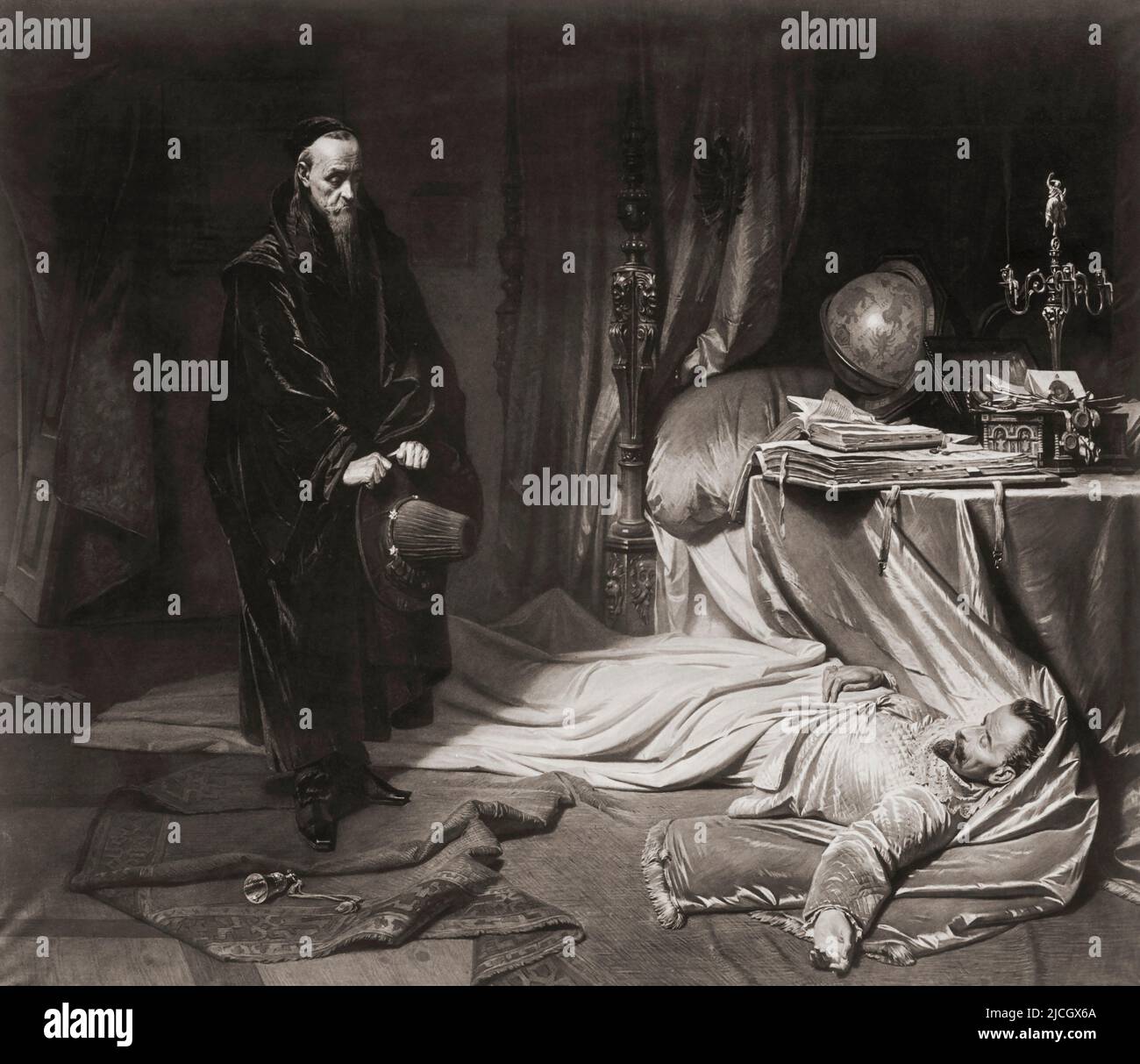 Albrecht Wenzel Eusebius von Wallenstein also von Waldstein, 1583 – 1634 found dead by the astrologer Seni. Wallenstein, Bohemian politician and military leader in the Thirty Years' War, was assassinated with the approval of Holy Roman Emperor Ferdinand II. Giovanni Battista Seni c. 1600 -1656. Italian astrologer and personal physician and astrologer of Wallenstein. After the painting by Carl Theodor von Piloty. Stock Photohttps://www.alamy.com/image-license-details/?v=1https://www.alamy.com/albrecht-wenzel-eusebius-von-wallenstein-also-von-waldstein-1583-1634-found-dead-by-the-astrologer-seni-wallenstein-bohemian-politician-and-military-leader-in-the-thirty-years-war-was-assassinated-with-the-approval-of-holy-roman-emperor-ferdinand-ii-giovanni-battista-seni-c-1600-1656-italian-astrologer-and-personal-physician-and-astrologer-of-wallenstein-after-the-painting-by-carl-theodor-von-piloty-image472427602.html
Albrecht Wenzel Eusebius von Wallenstein also von Waldstein, 1583 – 1634 found dead by the astrologer Seni. Wallenstein, Bohemian politician and military leader in the Thirty Years' War, was assassinated with the approval of Holy Roman Emperor Ferdinand II. Giovanni Battista Seni c. 1600 -1656. Italian astrologer and personal physician and astrologer of Wallenstein. After the painting by Carl Theodor von Piloty. Stock Photohttps://www.alamy.com/image-license-details/?v=1https://www.alamy.com/albrecht-wenzel-eusebius-von-wallenstein-also-von-waldstein-1583-1634-found-dead-by-the-astrologer-seni-wallenstein-bohemian-politician-and-military-leader-in-the-thirty-years-war-was-assassinated-with-the-approval-of-holy-roman-emperor-ferdinand-ii-giovanni-battista-seni-c-1600-1656-italian-astrologer-and-personal-physician-and-astrologer-of-wallenstein-after-the-painting-by-carl-theodor-von-piloty-image472427602.htmlRM2JCGX6A–Albrecht Wenzel Eusebius von Wallenstein also von Waldstein, 1583 – 1634 found dead by the astrologer Seni. Wallenstein, Bohemian politician and military leader in the Thirty Years' War, was assassinated with the approval of Holy Roman Emperor Ferdinand II. Giovanni Battista Seni c. 1600 -1656. Italian astrologer and personal physician and astrologer of Wallenstein. After the painting by Carl Theodor von Piloty.
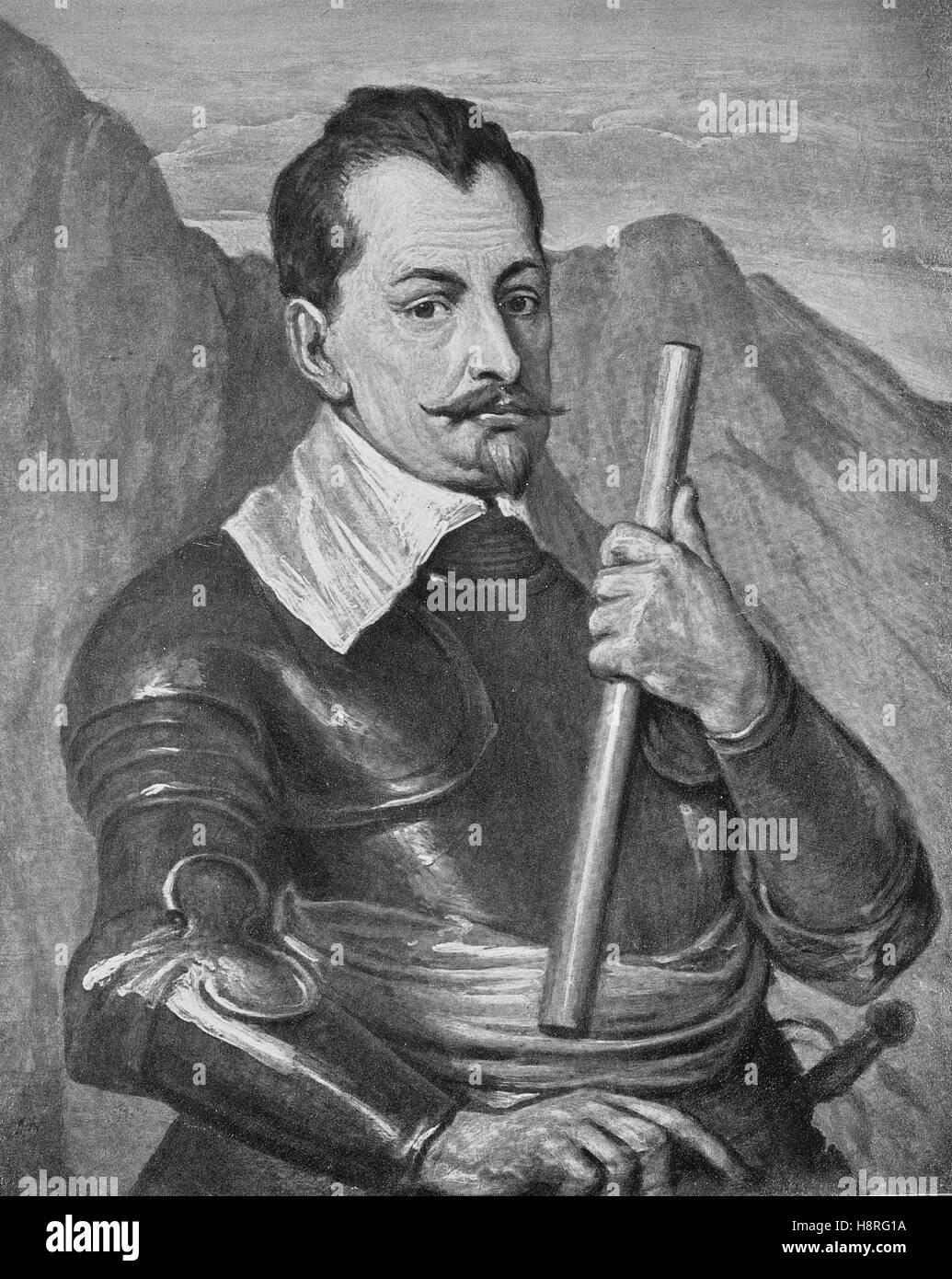 Albrecht Wenzel Eusebius von Wallenstein, also von Waldstein, was a Bohemian military leader and politician who offered his services, and an army of 30,000 to 100,000 men, during the Thirty Years' War, to the Holy Roman Emperor Ferdinand II Stock Photohttps://www.alamy.com/image-license-details/?v=1https://www.alamy.com/stock-photo-albrecht-wenzel-eusebius-von-wallenstein-also-von-waldstein-was-a-125907302.html
Albrecht Wenzel Eusebius von Wallenstein, also von Waldstein, was a Bohemian military leader and politician who offered his services, and an army of 30,000 to 100,000 men, during the Thirty Years' War, to the Holy Roman Emperor Ferdinand II Stock Photohttps://www.alamy.com/image-license-details/?v=1https://www.alamy.com/stock-photo-albrecht-wenzel-eusebius-von-wallenstein-also-von-waldstein-was-a-125907302.htmlRFH8RG1A–Albrecht Wenzel Eusebius von Wallenstein, also von Waldstein, was a Bohemian military leader and politician who offered his services, and an army of 30,000 to 100,000 men, during the Thirty Years' War, to the Holy Roman Emperor Ferdinand II
 Holy Roman Emperor Ferdinand II, 1578-1637. Ferdinandus II Austriacus, King of Bohemia, King of Hungary. Copperplate engraving from Abraham Bogaerts De Roomsche Monarchy, The Roman Monarchy, Francois Salma, Utrecht, 1697. Stock Photohttps://www.alamy.com/image-license-details/?v=1https://www.alamy.com/holy-roman-emperor-ferdinand-ii-1578-1637-ferdinandus-ii-austriacus-king-of-bohemia-king-of-hungary-copperplate-engraving-from-abraham-bogaerts-de-roomsche-monarchy-the-roman-monarchy-francois-salma-utrecht-1697-image359069046.html
Holy Roman Emperor Ferdinand II, 1578-1637. Ferdinandus II Austriacus, King of Bohemia, King of Hungary. Copperplate engraving from Abraham Bogaerts De Roomsche Monarchy, The Roman Monarchy, Francois Salma, Utrecht, 1697. Stock Photohttps://www.alamy.com/image-license-details/?v=1https://www.alamy.com/holy-roman-emperor-ferdinand-ii-1578-1637-ferdinandus-ii-austriacus-king-of-bohemia-king-of-hungary-copperplate-engraving-from-abraham-bogaerts-de-roomsche-monarchy-the-roman-monarchy-francois-salma-utrecht-1697-image359069046.htmlRM2BT506E–Holy Roman Emperor Ferdinand II, 1578-1637. Ferdinandus II Austriacus, King of Bohemia, King of Hungary. Copperplate engraving from Abraham Bogaerts De Roomsche Monarchy, The Roman Monarchy, Francois Salma, Utrecht, 1697.
 Holy Roman Emperor Ferdinand II, 1578-1637. Ferdinandus II Austriacus, King of Bohemia, King of Hungary. Copperplate engraving from Abraham Bogaert’s De Roomsche Monarchy, The Roman Monarchy, Francois Salma, Utrecht, 1697. Stock Photohttps://www.alamy.com/image-license-details/?v=1https://www.alamy.com/holy-roman-emperor-ferdinand-ii-1578-1637-ferdinandus-ii-austriacus-king-of-bohemia-king-of-hungary-copperplate-engraving-from-abraham-bogaerts-de-roomsche-monarchy-the-roman-monarchy-francois-salma-utrecht-1697-image329475092.html
Holy Roman Emperor Ferdinand II, 1578-1637. Ferdinandus II Austriacus, King of Bohemia, King of Hungary. Copperplate engraving from Abraham Bogaert’s De Roomsche Monarchy, The Roman Monarchy, Francois Salma, Utrecht, 1697. Stock Photohttps://www.alamy.com/image-license-details/?v=1https://www.alamy.com/holy-roman-emperor-ferdinand-ii-1578-1637-ferdinandus-ii-austriacus-king-of-bohemia-king-of-hungary-copperplate-engraving-from-abraham-bogaerts-de-roomsche-monarchy-the-roman-monarchy-francois-salma-utrecht-1697-image329475092.htmlRM2A40TRG–Holy Roman Emperor Ferdinand II, 1578-1637. Ferdinandus II Austriacus, King of Bohemia, King of Hungary. Copperplate engraving from Abraham Bogaert’s De Roomsche Monarchy, The Roman Monarchy, Francois Salma, Utrecht, 1697.
 Portrait of Ferdinand II, Holy Roman Emperor (1578-1637). 17th century. Ferdinand II with insignia Stock Photohttps://www.alamy.com/image-license-details/?v=1https://www.alamy.com/portrait-of-ferdinand-ii-holy-roman-emperor-1578-1637-17th-century-ferdinand-ii-with-insignia-image184868951.html
Portrait of Ferdinand II, Holy Roman Emperor (1578-1637). 17th century. Ferdinand II with insignia Stock Photohttps://www.alamy.com/image-license-details/?v=1https://www.alamy.com/portrait-of-ferdinand-ii-holy-roman-emperor-1578-1637-17th-century-ferdinand-ii-with-insignia-image184868951.htmlRMMMNE6F–Portrait of Ferdinand II, Holy Roman Emperor (1578-1637). 17th century. Ferdinand II with insignia
![Albrecht Wenzel Eusebius von Wallenstein, also von Waldstein, was a Bohemian[a] military leader and politician who offered his services, and an army of 30,000 to 100,000 men, during the Thirty Years' War, to the Holy Roman Emperor Ferdinand II Stock Photo Albrecht Wenzel Eusebius von Wallenstein, also von Waldstein, was a Bohemian[a] military leader and politician who offered his services, and an army of 30,000 to 100,000 men, during the Thirty Years' War, to the Holy Roman Emperor Ferdinand II Stock Photo](https://c8.alamy.com/comp/2MTFA63/albrecht-wenzel-eusebius-von-wallenstein-also-von-waldstein-was-a-bohemian-a-military-leader-and-politician-who-offered-his-services-and-an-army-of-30000-to-100000-men-during-the-thirty-years-war-to-the-holy-roman-emperor-ferdinand-ii-2MTFA63.jpg) Albrecht Wenzel Eusebius von Wallenstein, also von Waldstein, was a Bohemian[a] military leader and politician who offered his services, and an army of 30,000 to 100,000 men, during the Thirty Years' War, to the Holy Roman Emperor Ferdinand II Stock Photohttps://www.alamy.com/image-license-details/?v=1https://www.alamy.com/albrecht-wenzel-eusebius-von-wallenstein-also-von-waldstein-was-a-bohemian-a-military-leader-and-politician-who-offered-his-services-and-an-army-of-30000-to-100000-men-during-the-thirty-years-war-to-the-holy-roman-emperor-ferdinand-ii-image514189707.html
Albrecht Wenzel Eusebius von Wallenstein, also von Waldstein, was a Bohemian[a] military leader and politician who offered his services, and an army of 30,000 to 100,000 men, during the Thirty Years' War, to the Holy Roman Emperor Ferdinand II Stock Photohttps://www.alamy.com/image-license-details/?v=1https://www.alamy.com/albrecht-wenzel-eusebius-von-wallenstein-also-von-waldstein-was-a-bohemian-a-military-leader-and-politician-who-offered-his-services-and-an-army-of-30000-to-100000-men-during-the-thirty-years-war-to-the-holy-roman-emperor-ferdinand-ii-image514189707.htmlRF2MTFA63–Albrecht Wenzel Eusebius von Wallenstein, also von Waldstein, was a Bohemian[a] military leader and politician who offered his services, and an army of 30,000 to 100,000 men, during the Thirty Years' War, to the Holy Roman Emperor Ferdinand II
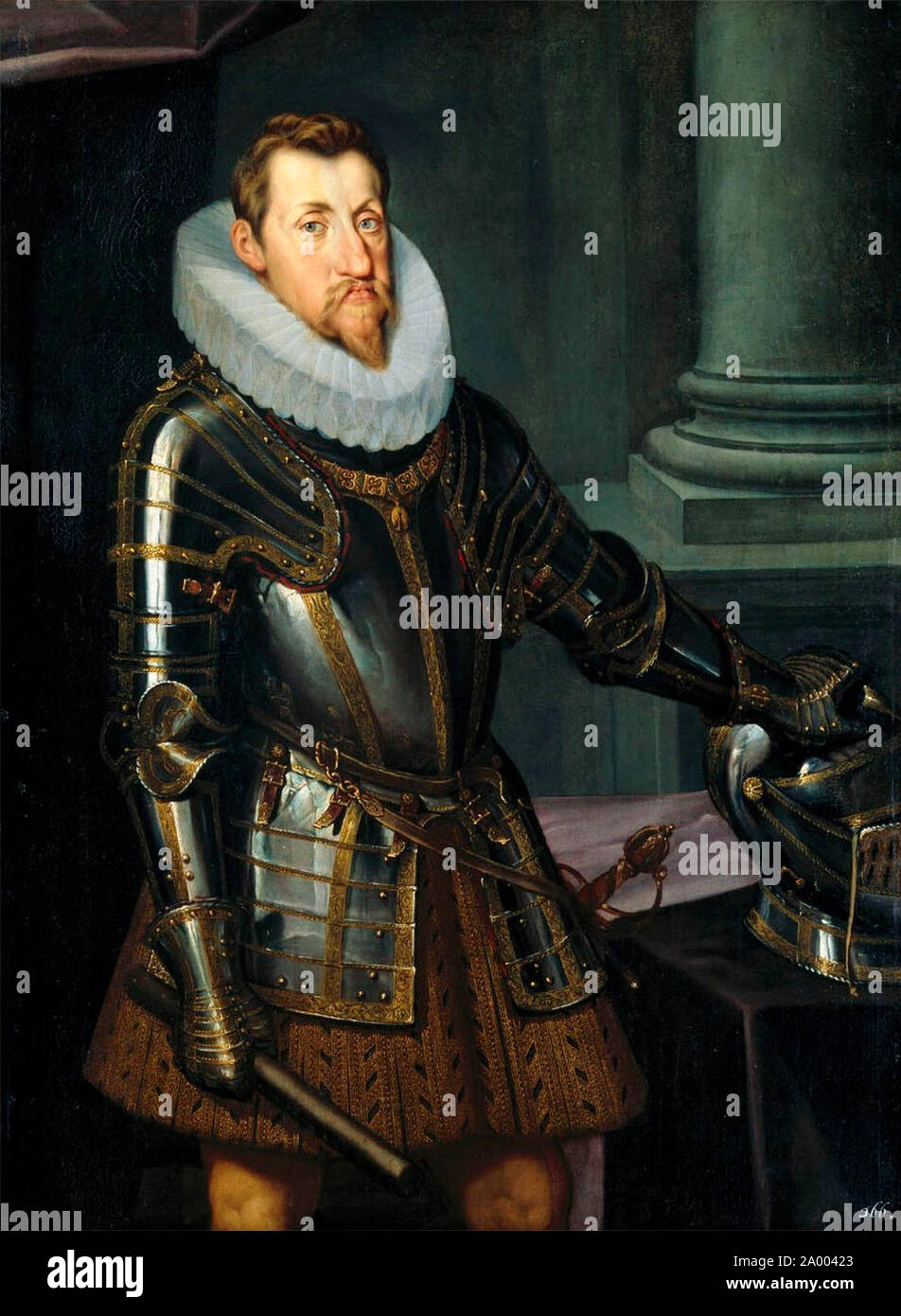 Portrait of Ferdinand II, Holy Roman Emperor (1578-1637), circa 1614 Stock Photohttps://www.alamy.com/image-license-details/?v=1https://www.alamy.com/portrait-of-ferdinand-ii-holy-roman-emperor-1578-1637-circa-1614-image327000187.html
Portrait of Ferdinand II, Holy Roman Emperor (1578-1637), circa 1614 Stock Photohttps://www.alamy.com/image-license-details/?v=1https://www.alamy.com/portrait-of-ferdinand-ii-holy-roman-emperor-1578-1637-circa-1614-image327000187.htmlRM2A00423–Portrait of Ferdinand II, Holy Roman Emperor (1578-1637), circa 1614
 Study for the Essequie Conducted in San Lorenzo, Florence, in 1637 in Honour of Holy Roman Emperor Ferdinand II, 1637. Alfonso Parigi was the official court architect for the Medici, taking over after the death of his father, the great engineer, architect, and designer Giulio Parigi. Testifying to the Medici's interest in cultivating a culture of the macabre, this sheet is an elaborate study for the essequie (funerary rites) for the Holy Roman Emperor Ferdinand II. Skulls and skeletons comingle with angels and garlands, and black draperies would have been hung to transform the church into a st Stock Photohttps://www.alamy.com/image-license-details/?v=1https://www.alamy.com/study-for-the-essequie-conducted-in-san-lorenzo-florence-in-1637-in-honour-of-holy-roman-emperor-ferdinand-ii-1637-alfonso-parigi-was-the-official-court-architect-for-the-medici-taking-over-after-the-death-of-his-father-the-great-engineer-architect-and-designer-giulio-parigi-testifying-to-the-medicis-interest-in-cultivating-a-culture-of-the-macabre-this-sheet-is-an-elaborate-study-for-the-essequie-funerary-rites-for-the-holy-roman-emperor-ferdinand-ii-skulls-and-skeletons-comingle-with-angels-and-garlands-and-black-draperies-would-have-been-hung-to-transform-the-church-into-a-st-image330122359.html
Study for the Essequie Conducted in San Lorenzo, Florence, in 1637 in Honour of Holy Roman Emperor Ferdinand II, 1637. Alfonso Parigi was the official court architect for the Medici, taking over after the death of his father, the great engineer, architect, and designer Giulio Parigi. Testifying to the Medici's interest in cultivating a culture of the macabre, this sheet is an elaborate study for the essequie (funerary rites) for the Holy Roman Emperor Ferdinand II. Skulls and skeletons comingle with angels and garlands, and black draperies would have been hung to transform the church into a st Stock Photohttps://www.alamy.com/image-license-details/?v=1https://www.alamy.com/study-for-the-essequie-conducted-in-san-lorenzo-florence-in-1637-in-honour-of-holy-roman-emperor-ferdinand-ii-1637-alfonso-parigi-was-the-official-court-architect-for-the-medici-taking-over-after-the-death-of-his-father-the-great-engineer-architect-and-designer-giulio-parigi-testifying-to-the-medicis-interest-in-cultivating-a-culture-of-the-macabre-this-sheet-is-an-elaborate-study-for-the-essequie-funerary-rites-for-the-holy-roman-emperor-ferdinand-ii-skulls-and-skeletons-comingle-with-angels-and-garlands-and-black-draperies-would-have-been-hung-to-transform-the-church-into-a-st-image330122359.htmlRM2A52AC7–Study for the Essequie Conducted in San Lorenzo, Florence, in 1637 in Honour of Holy Roman Emperor Ferdinand II, 1637. Alfonso Parigi was the official court architect for the Medici, taking over after the death of his father, the great engineer, architect, and designer Giulio Parigi. Testifying to the Medici's interest in cultivating a culture of the macabre, this sheet is an elaborate study for the essequie (funerary rites) for the Holy Roman Emperor Ferdinand II. Skulls and skeletons comingle with angels and garlands, and black draperies would have been hung to transform the church into a st
![Portrait of Maria Anna of Spain Ferdinandus II [us] and III [us] Imperatorum Domus Austriacae (series title), Portrait of Maria Anna of Spain, wife of the emperor of the Holy Roman Empire Ferdinand III, Maria Anna of Austria (German Empress), Jacob Louys (mentioned on object), Haarlem, 1644 - 1650, paper, etching, h 411 mm × w 278 mm Stock Photo Portrait of Maria Anna of Spain Ferdinandus II [us] and III [us] Imperatorum Domus Austriacae (series title), Portrait of Maria Anna of Spain, wife of the emperor of the Holy Roman Empire Ferdinand III, Maria Anna of Austria (German Empress), Jacob Louys (mentioned on object), Haarlem, 1644 - 1650, paper, etching, h 411 mm × w 278 mm Stock Photo](https://c8.alamy.com/comp/W57YR6/portrait-of-maria-anna-of-spain-ferdinandus-ii-us-and-iii-us-imperatorum-domus-austriacae-series-title-portrait-of-maria-anna-of-spain-wife-of-the-emperor-of-the-holy-roman-empire-ferdinand-iii-maria-anna-of-austria-german-empress-jacob-louys-mentioned-on-object-haarlem-1644-1650-paper-etching-h-411-mm-w-278-mm-W57YR6.jpg) Portrait of Maria Anna of Spain Ferdinandus II [us] and III [us] Imperatorum Domus Austriacae (series title), Portrait of Maria Anna of Spain, wife of the emperor of the Holy Roman Empire Ferdinand III, Maria Anna of Austria (German Empress), Jacob Louys (mentioned on object), Haarlem, 1644 - 1650, paper, etching, h 411 mm × w 278 mm Stock Photohttps://www.alamy.com/image-license-details/?v=1https://www.alamy.com/portrait-of-maria-anna-of-spain-ferdinandus-ii-us-and-iii-us-imperatorum-domus-austriacae-series-title-portrait-of-maria-anna-of-spain-wife-of-the-emperor-of-the-holy-roman-empire-ferdinand-iii-maria-anna-of-austria-german-empress-jacob-louys-mentioned-on-object-haarlem-1644-1650-paper-etching-h-411-mm-w-278-mm-image261404282.html
Portrait of Maria Anna of Spain Ferdinandus II [us] and III [us] Imperatorum Domus Austriacae (series title), Portrait of Maria Anna of Spain, wife of the emperor of the Holy Roman Empire Ferdinand III, Maria Anna of Austria (German Empress), Jacob Louys (mentioned on object), Haarlem, 1644 - 1650, paper, etching, h 411 mm × w 278 mm Stock Photohttps://www.alamy.com/image-license-details/?v=1https://www.alamy.com/portrait-of-maria-anna-of-spain-ferdinandus-ii-us-and-iii-us-imperatorum-domus-austriacae-series-title-portrait-of-maria-anna-of-spain-wife-of-the-emperor-of-the-holy-roman-empire-ferdinand-iii-maria-anna-of-austria-german-empress-jacob-louys-mentioned-on-object-haarlem-1644-1650-paper-etching-h-411-mm-w-278-mm-image261404282.htmlRMW57YR6–Portrait of Maria Anna of Spain Ferdinandus II [us] and III [us] Imperatorum Domus Austriacae (series title), Portrait of Maria Anna of Spain, wife of the emperor of the Holy Roman Empire Ferdinand III, Maria Anna of Austria (German Empress), Jacob Louys (mentioned on object), Haarlem, 1644 - 1650, paper, etching, h 411 mm × w 278 mm
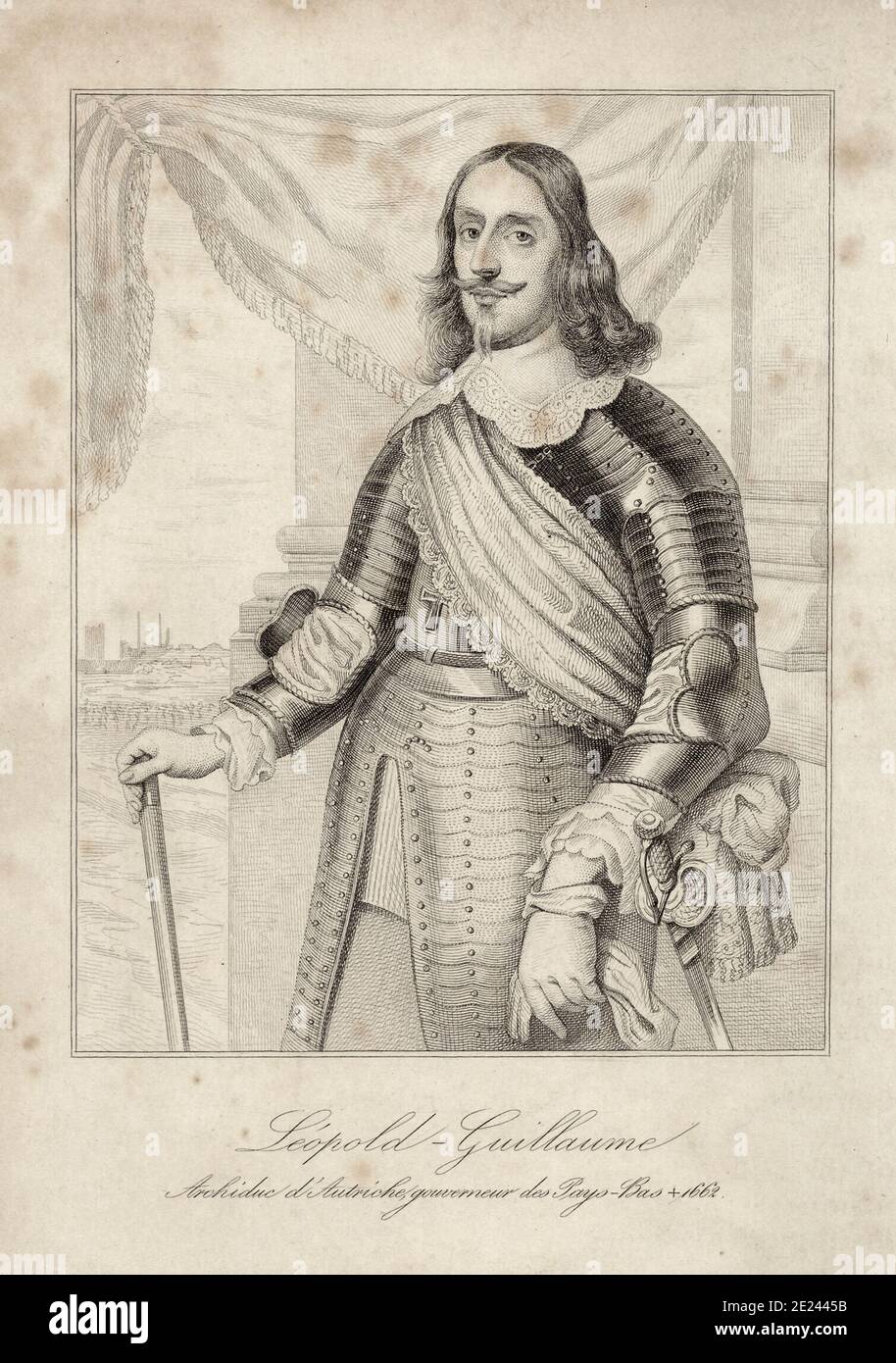 Engraving of Archduke Leopold Wilhelm of Austria (1614 – 1662) was an Austrian military commander, Governor of the Spanish Netherlands from 1647 to 16 Stock Photohttps://www.alamy.com/image-license-details/?v=1https://www.alamy.com/engraving-of-archduke-leopold-wilhelm-of-austria-1614-1662-was-an-austrian-military-commander-governor-of-the-spanish-netherlands-from-1647-to-16-image397158871.html
Engraving of Archduke Leopold Wilhelm of Austria (1614 – 1662) was an Austrian military commander, Governor of the Spanish Netherlands from 1647 to 16 Stock Photohttps://www.alamy.com/image-license-details/?v=1https://www.alamy.com/engraving-of-archduke-leopold-wilhelm-of-austria-1614-1662-was-an-austrian-military-commander-governor-of-the-spanish-netherlands-from-1647-to-16-image397158871.htmlRM2E2445B–Engraving of Archduke Leopold Wilhelm of Austria (1614 – 1662) was an Austrian military commander, Governor of the Spanish Netherlands from 1647 to 16
 Engraver: Pieter Van Sompel, Flemish, 1600–after 1644, After: Pieter Claesz. Soutman, Dutch, ca. 1580–1657, Eleanora, wife of Holy Roman Emperor Ferdinand II, Etching and engraving, platemark: 41.2 × 28.2 cm (16 1/4 × 11 1/8in.), Made in Flanders, Flemish, 17th century, Works on Paper - Prints Stock Photohttps://www.alamy.com/image-license-details/?v=1https://www.alamy.com/engraver-pieter-van-sompel-flemish-1600after-1644-after-pieter-claesz-soutman-dutch-ca-15801657-eleanora-wife-of-holy-roman-emperor-ferdinand-ii-etching-and-engraving-platemark-412-282-cm-16-14-1118in-made-in-flanders-flemish-17thcentury-works-on-paper-prints-image393089191.html
Engraver: Pieter Van Sompel, Flemish, 1600–after 1644, After: Pieter Claesz. Soutman, Dutch, ca. 1580–1657, Eleanora, wife of Holy Roman Emperor Ferdinand II, Etching and engraving, platemark: 41.2 × 28.2 cm (16 1/4 × 11 1/8in.), Made in Flanders, Flemish, 17th century, Works on Paper - Prints Stock Photohttps://www.alamy.com/image-license-details/?v=1https://www.alamy.com/engraver-pieter-van-sompel-flemish-1600after-1644-after-pieter-claesz-soutman-dutch-ca-15801657-eleanora-wife-of-holy-roman-emperor-ferdinand-ii-etching-and-engraving-platemark-412-282-cm-16-14-1118in-made-in-flanders-flemish-17thcentury-works-on-paper-prints-image393089191.htmlRM2DREN7K–Engraver: Pieter Van Sompel, Flemish, 1600–after 1644, After: Pieter Claesz. Soutman, Dutch, ca. 1580–1657, Eleanora, wife of Holy Roman Emperor Ferdinand II, Etching and engraving, platemark: 41.2 × 28.2 cm (16 1/4 × 11 1/8in.), Made in Flanders, Flemish, 17th century, Works on Paper - Prints
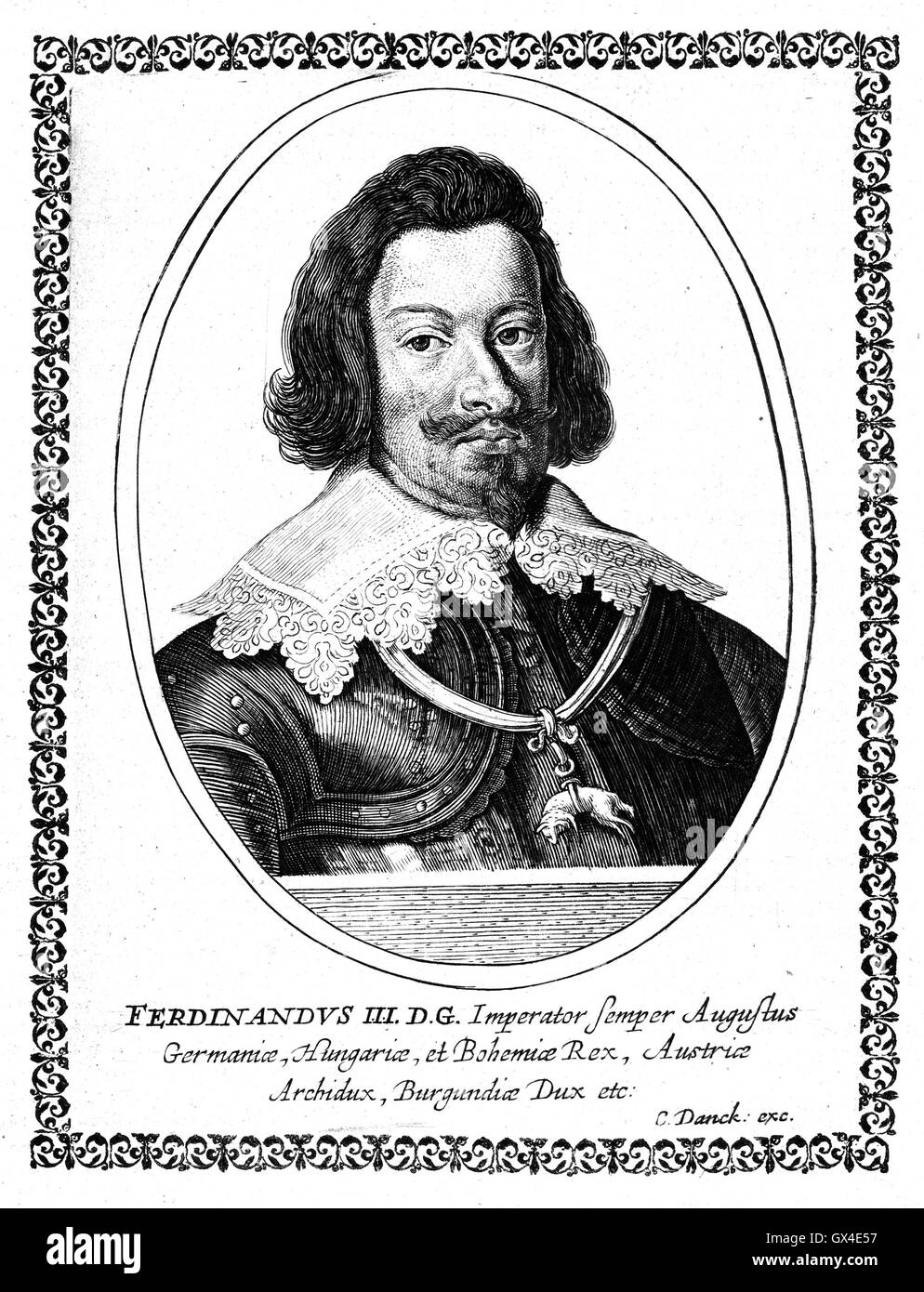 FERDINAND II, Holy Roman Emperor (1578-1637) Stock Photohttps://www.alamy.com/image-license-details/?v=1https://www.alamy.com/stock-photo-ferdinand-ii-holy-roman-emperor-1578-1637-119342195.html
FERDINAND II, Holy Roman Emperor (1578-1637) Stock Photohttps://www.alamy.com/image-license-details/?v=1https://www.alamy.com/stock-photo-ferdinand-ii-holy-roman-emperor-1578-1637-119342195.htmlRMGX4E57–FERDINAND II, Holy Roman Emperor (1578-1637)
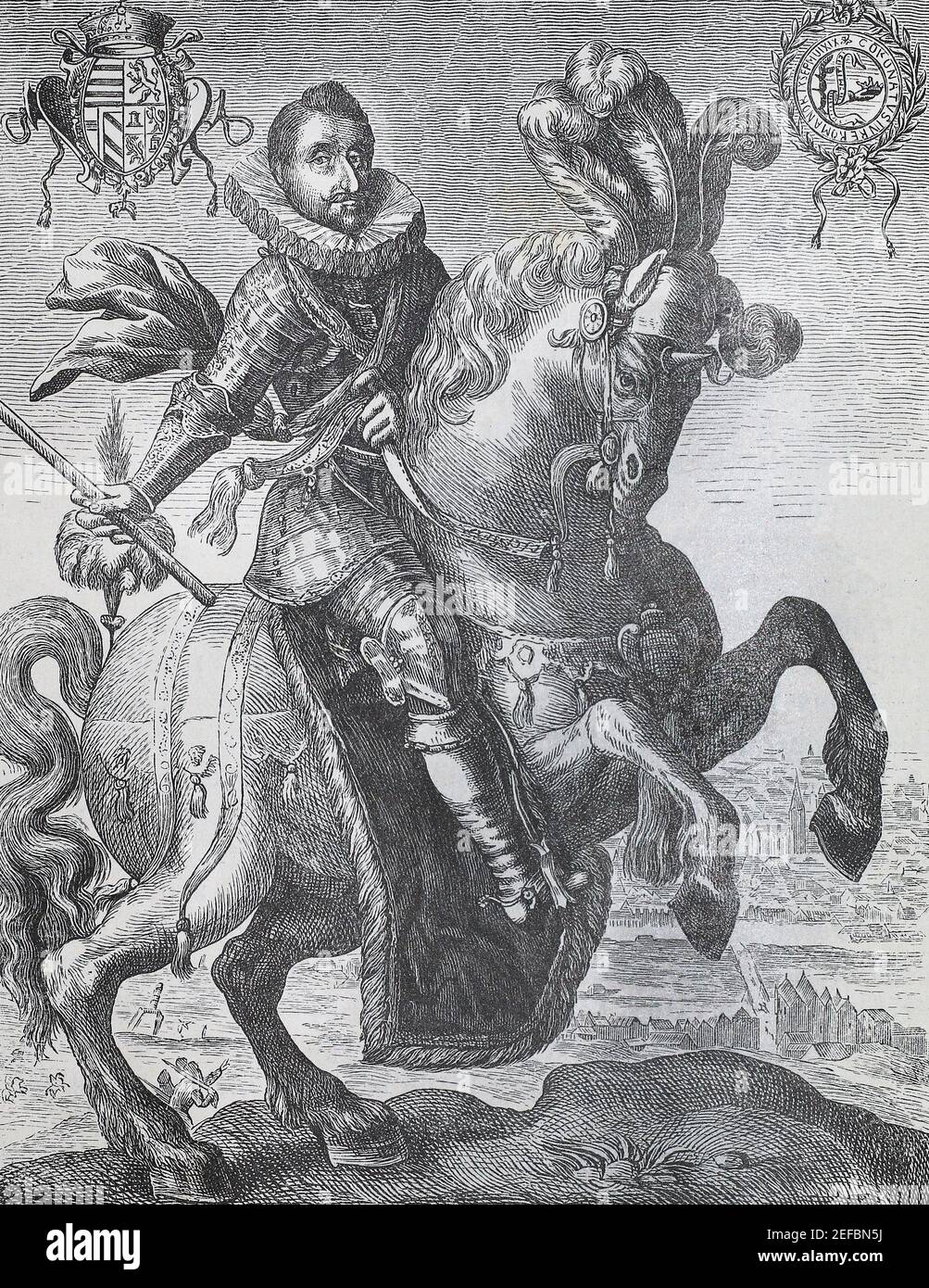 Emperor Ferdinand II. Engraving of 1619. Stock Photohttps://www.alamy.com/image-license-details/?v=1https://www.alamy.com/emperor-ferdinand-ii-engraving-of-1619-image405316398.html
Emperor Ferdinand II. Engraving of 1619. Stock Photohttps://www.alamy.com/image-license-details/?v=1https://www.alamy.com/emperor-ferdinand-ii-engraving-of-1619-image405316398.htmlRM2EFBN5J–Emperor Ferdinand II. Engraving of 1619.
 FERDINAND II, Holy Roman Emperor (1578-1637) as King of Hungary in an early 19th century engraving Stock Photohttps://www.alamy.com/image-license-details/?v=1https://www.alamy.com/stock-photo-ferdinand-ii-holy-roman-emperor-1578-1637-as-king-of-hungary-in-an-119497159.html
FERDINAND II, Holy Roman Emperor (1578-1637) as King of Hungary in an early 19th century engraving Stock Photohttps://www.alamy.com/image-license-details/?v=1https://www.alamy.com/stock-photo-ferdinand-ii-holy-roman-emperor-1578-1637-as-king-of-hungary-in-an-119497159.htmlRMGXBFRK–FERDINAND II, Holy Roman Emperor (1578-1637) as King of Hungary in an early 19th century engraving
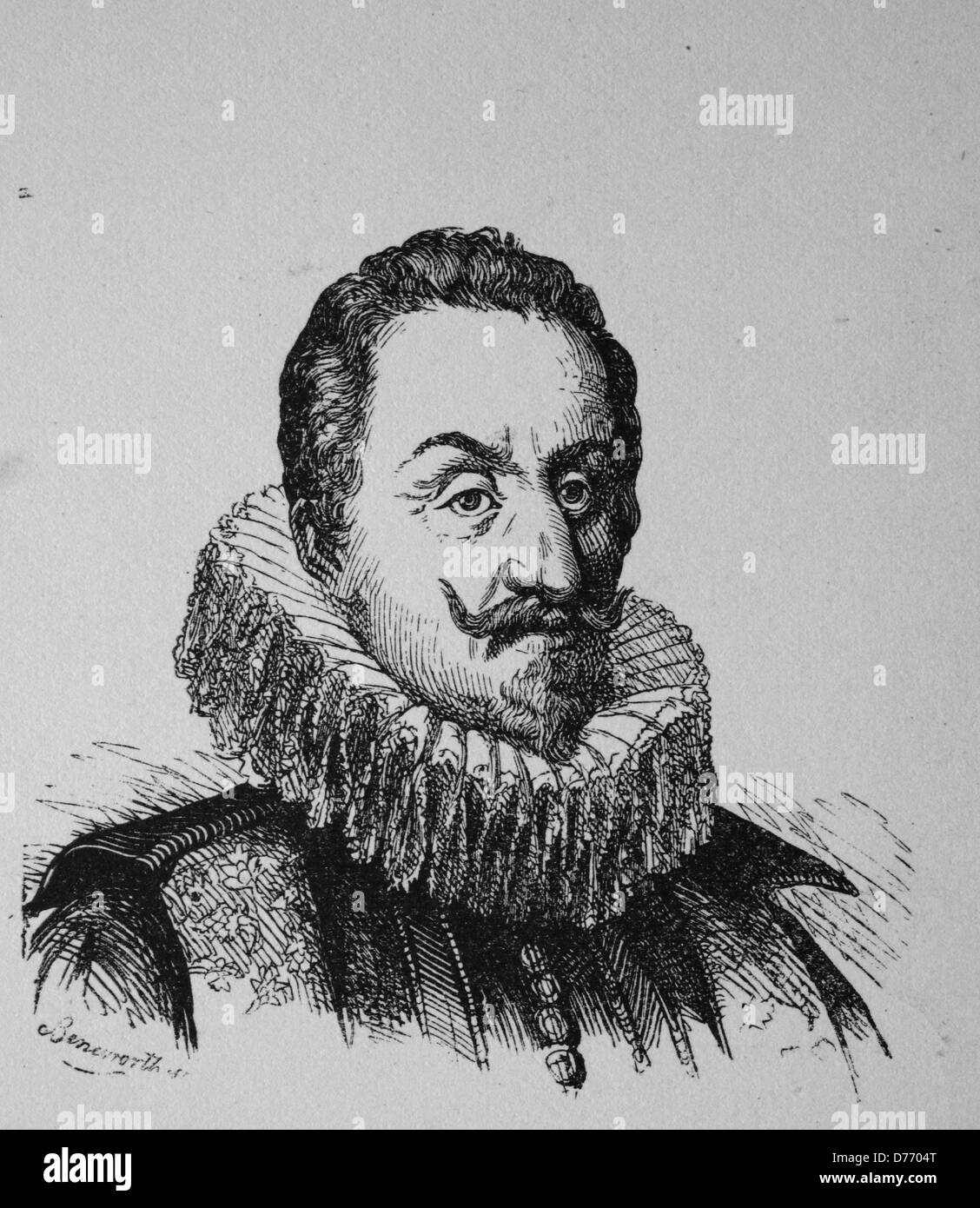 Ferdinand II, 1578 - 1637, King of Bohemia, Hungary, Croatia, Emperor of the Holy Roman Empire, historical woodcut, circa 1880 Stock Photohttps://www.alamy.com/image-license-details/?v=1https://www.alamy.com/stock-photo-ferdinand-ii-1578-1637-king-of-bohemia-hungary-croatia-emperor-of-56087496.html
Ferdinand II, 1578 - 1637, King of Bohemia, Hungary, Croatia, Emperor of the Holy Roman Empire, historical woodcut, circa 1880 Stock Photohttps://www.alamy.com/image-license-details/?v=1https://www.alamy.com/stock-photo-ferdinand-ii-1578-1637-king-of-bohemia-hungary-croatia-emperor-of-56087496.htmlRFD7704T–Ferdinand II, 1578 - 1637, King of Bohemia, Hungary, Croatia, Emperor of the Holy Roman Empire, historical woodcut, circa 1880
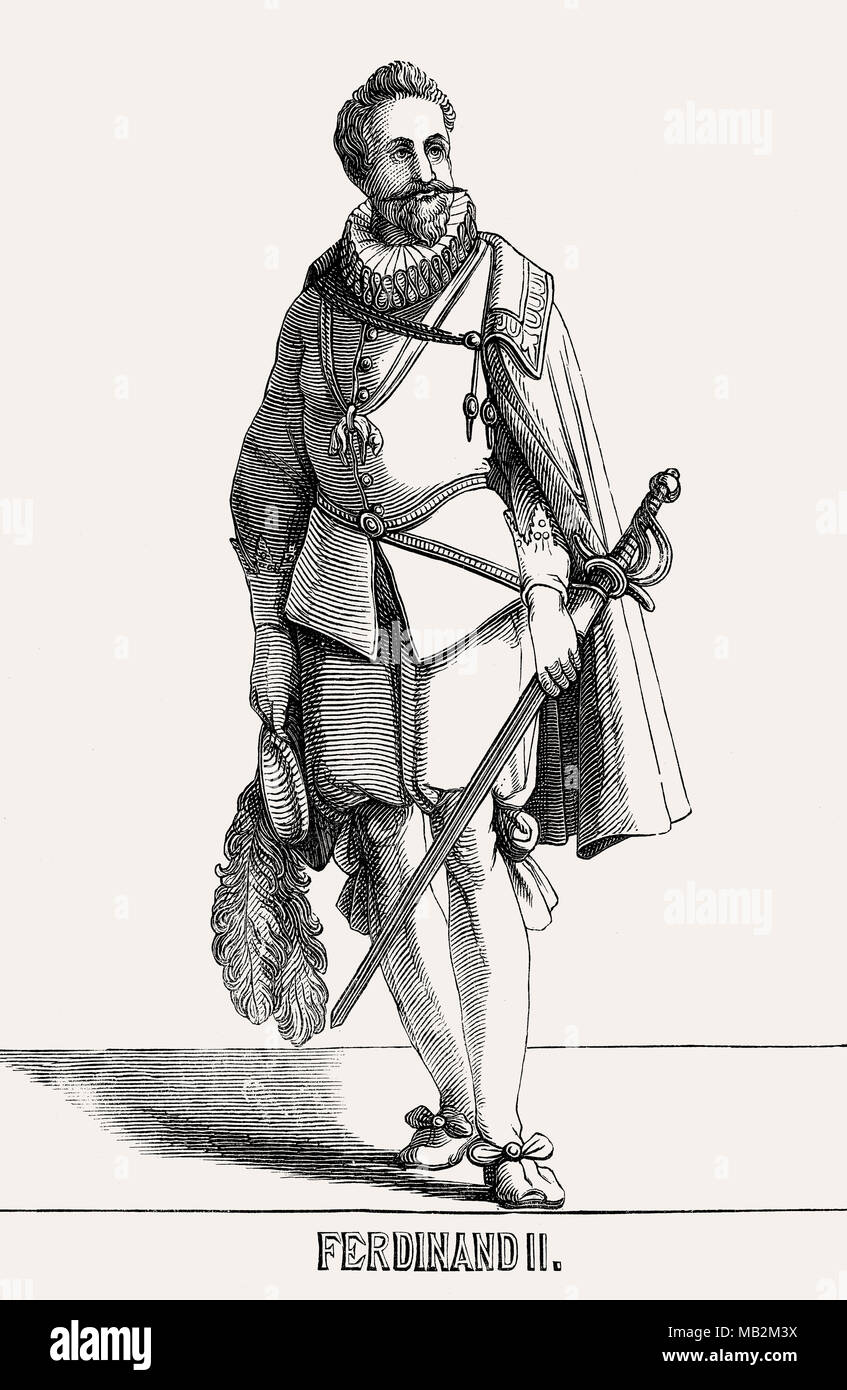 Ferdinand II, Holy Roman Emperor from 1619 to 1637 Stock Photohttps://www.alamy.com/image-license-details/?v=1https://www.alamy.com/ferdinand-ii-holy-roman-emperor-from-1619-to-1637-image178924590.html
Ferdinand II, Holy Roman Emperor from 1619 to 1637 Stock Photohttps://www.alamy.com/image-license-details/?v=1https://www.alamy.com/ferdinand-ii-holy-roman-emperor-from-1619-to-1637-image178924590.htmlRMMB2M3X–Ferdinand II, Holy Roman Emperor from 1619 to 1637
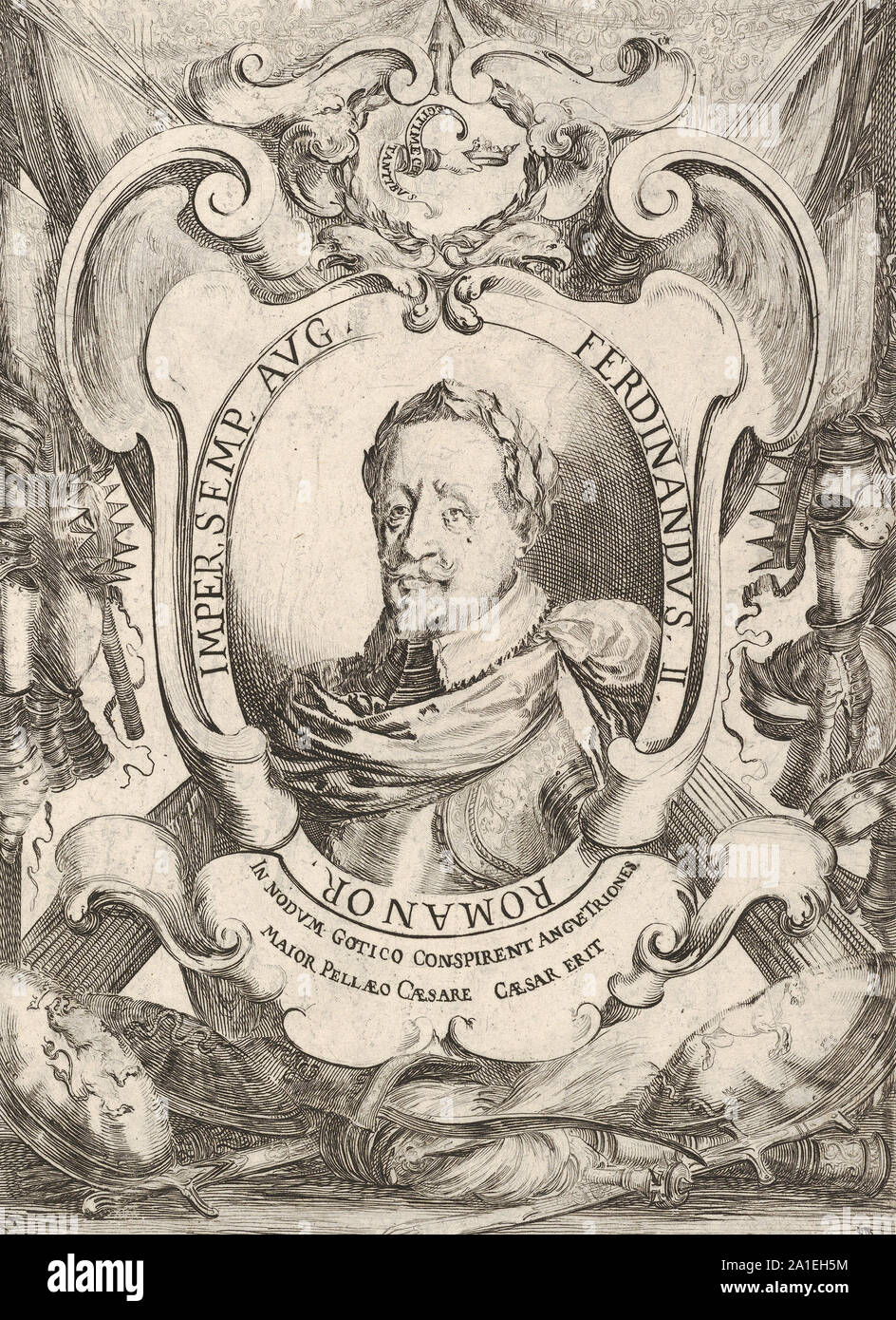 Emperor Ferdinand II. Medieval engraving. Ferdinand II (9 July 1578 – 15 February 1637), a member of the House of Habsburg, was Holy Roman Emperor (1619–1637), King of Bohemia (1617–1619, 1620–1637), and King of Hungary (1618–1637). He was the son of Archduke Charles II of Inner Austria, and Maria of Bavaria. Stock Photohttps://www.alamy.com/image-license-details/?v=1https://www.alamy.com/emperor-ferdinand-ii-medieval-engraving-ferdinand-ii-9-july-1578-15-february-1637-a-member-of-the-house-of-habsburg-was-holy-roman-emperor-16191637-king-of-bohemia-16171619-16201637-and-king-of-hungary-16181637-he-was-the-son-of-archduke-charles-ii-of-inner-austria-and-maria-of-bavaria-image327932464.html
Emperor Ferdinand II. Medieval engraving. Ferdinand II (9 July 1578 – 15 February 1637), a member of the House of Habsburg, was Holy Roman Emperor (1619–1637), King of Bohemia (1617–1619, 1620–1637), and King of Hungary (1618–1637). He was the son of Archduke Charles II of Inner Austria, and Maria of Bavaria. Stock Photohttps://www.alamy.com/image-license-details/?v=1https://www.alamy.com/emperor-ferdinand-ii-medieval-engraving-ferdinand-ii-9-july-1578-15-february-1637-a-member-of-the-house-of-habsburg-was-holy-roman-emperor-16191637-king-of-bohemia-16171619-16201637-and-king-of-hungary-16181637-he-was-the-son-of-archduke-charles-ii-of-inner-austria-and-maria-of-bavaria-image327932464.htmlRM2A1EH5M–Emperor Ferdinand II. Medieval engraving. Ferdinand II (9 July 1578 – 15 February 1637), a member of the House of Habsburg, was Holy Roman Emperor (1619–1637), King of Bohemia (1617–1619, 1620–1637), and King of Hungary (1618–1637). He was the son of Archduke Charles II of Inner Austria, and Maria of Bavaria.
 Portrait in an oval frame of Ferdinand III, Archduke of Austria and Emperor of the Holy Roman Empire Bust to right Ferdinand wears the laurel wreath on his head In his hands the imperial apple and the imperial sword The print has a Latin caption with the name of the person portrayed, Portrait of Ferdinand III Portraits of Statesmen , print maker: Frederik Bouttats (I), (mentioned on object), publisher: Theodor van Merlen (II), (mentioned on object), Antwerp, 1637 - 1676, paper, engraving, h 89 mm × w 57 mm Stock Photohttps://www.alamy.com/image-license-details/?v=1https://www.alamy.com/portrait-in-an-oval-frame-of-ferdinand-iii-archduke-of-austria-and-emperor-of-the-holy-roman-empire-bust-to-right-ferdinand-wears-the-laurel-wreath-on-his-head-in-his-hands-the-imperial-apple-and-the-imperial-sword-the-print-has-a-latin-caption-with-the-name-of-the-person-portrayed-portrait-of-ferdinand-iii-portraits-of-statesmen-print-maker-frederik-bouttats-i-mentioned-on-object-publisher-theodor-van-merlen-ii-mentioned-on-object-antwerp-1637-1676-paper-engraving-h-89-mm-w-57-mm-image472289151.html
Portrait in an oval frame of Ferdinand III, Archduke of Austria and Emperor of the Holy Roman Empire Bust to right Ferdinand wears the laurel wreath on his head In his hands the imperial apple and the imperial sword The print has a Latin caption with the name of the person portrayed, Portrait of Ferdinand III Portraits of Statesmen , print maker: Frederik Bouttats (I), (mentioned on object), publisher: Theodor van Merlen (II), (mentioned on object), Antwerp, 1637 - 1676, paper, engraving, h 89 mm × w 57 mm Stock Photohttps://www.alamy.com/image-license-details/?v=1https://www.alamy.com/portrait-in-an-oval-frame-of-ferdinand-iii-archduke-of-austria-and-emperor-of-the-holy-roman-empire-bust-to-right-ferdinand-wears-the-laurel-wreath-on-his-head-in-his-hands-the-imperial-apple-and-the-imperial-sword-the-print-has-a-latin-caption-with-the-name-of-the-person-portrayed-portrait-of-ferdinand-iii-portraits-of-statesmen-print-maker-frederik-bouttats-i-mentioned-on-object-publisher-theodor-van-merlen-ii-mentioned-on-object-antwerp-1637-1676-paper-engraving-h-89-mm-w-57-mm-image472289151.htmlRM2JCAHHK–Portrait in an oval frame of Ferdinand III, Archduke of Austria and Emperor of the Holy Roman Empire Bust to right Ferdinand wears the laurel wreath on his head In his hands the imperial apple and the imperial sword The print has a Latin caption with the name of the person portrayed, Portrait of Ferdinand III Portraits of Statesmen , print maker: Frederik Bouttats (I), (mentioned on object), publisher: Theodor van Merlen (II), (mentioned on object), Antwerp, 1637 - 1676, paper, engraving, h 89 mm × w 57 mm
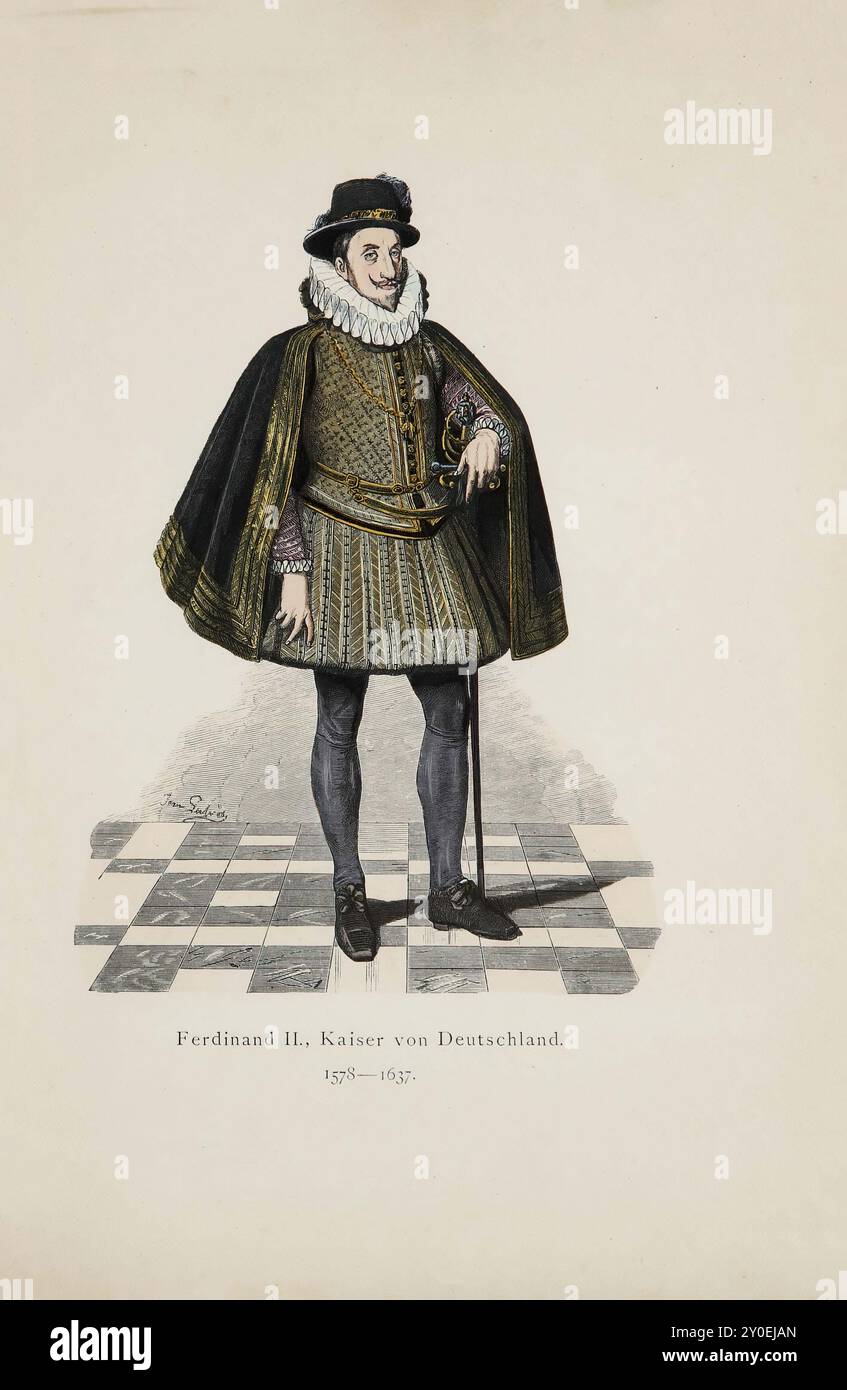 Historical and folk costumes of Europe. Ferdinand II, Holy Roman Emperor 1578-1637 Ferdinand II, a son of Duke Charles of Styria, born on 9 July 1578 in Graz, was appointed King of Bohemia and Hungary during the lifetime of the childless Emperor Matthias, in 1617 and 1618. One year after the outbreak of the Thirty Years' War, in 1619, he became emperor, and in the midst of the turmoil of the same, on 15 February 1637, he died. The heavily starched collar and cuffs are still of the size that was usual during the time of Henry IV of France (1593-1610). The tabard is close-fitting to the body and Stock Photohttps://www.alamy.com/image-license-details/?v=1https://www.alamy.com/historical-and-folk-costumes-of-europe-ferdinand-ii-holy-roman-emperor-1578-1637-ferdinand-ii-a-son-of-duke-charles-of-styria-born-on-9-july-1578-in-graz-was-appointed-king-of-bohemia-and-hungary-during-the-lifetime-of-the-childless-emperor-matthias-in-1617-and-1618-one-year-after-the-outbreak-of-the-thirty-years-war-in-1619-he-became-emperor-and-in-the-midst-of-the-turmoil-of-the-same-on-15-february-1637-he-died-the-heavily-starched-collar-and-cuffs-are-still-of-the-size-that-was-usual-during-the-time-of-henry-iv-of-france-1593-1610-the-tabard-is-close-fitting-to-the-body-and-image619894989.html
Historical and folk costumes of Europe. Ferdinand II, Holy Roman Emperor 1578-1637 Ferdinand II, a son of Duke Charles of Styria, born on 9 July 1578 in Graz, was appointed King of Bohemia and Hungary during the lifetime of the childless Emperor Matthias, in 1617 and 1618. One year after the outbreak of the Thirty Years' War, in 1619, he became emperor, and in the midst of the turmoil of the same, on 15 February 1637, he died. The heavily starched collar and cuffs are still of the size that was usual during the time of Henry IV of France (1593-1610). The tabard is close-fitting to the body and Stock Photohttps://www.alamy.com/image-license-details/?v=1https://www.alamy.com/historical-and-folk-costumes-of-europe-ferdinand-ii-holy-roman-emperor-1578-1637-ferdinand-ii-a-son-of-duke-charles-of-styria-born-on-9-july-1578-in-graz-was-appointed-king-of-bohemia-and-hungary-during-the-lifetime-of-the-childless-emperor-matthias-in-1617-and-1618-one-year-after-the-outbreak-of-the-thirty-years-war-in-1619-he-became-emperor-and-in-the-midst-of-the-turmoil-of-the-same-on-15-february-1637-he-died-the-heavily-starched-collar-and-cuffs-are-still-of-the-size-that-was-usual-during-the-time-of-henry-iv-of-france-1593-1610-the-tabard-is-close-fitting-to-the-body-and-image619894989.htmlRM2Y0EJAN–Historical and folk costumes of Europe. Ferdinand II, Holy Roman Emperor 1578-1637 Ferdinand II, a son of Duke Charles of Styria, born on 9 July 1578 in Graz, was appointed King of Bohemia and Hungary during the lifetime of the childless Emperor Matthias, in 1617 and 1618. One year after the outbreak of the Thirty Years' War, in 1619, he became emperor, and in the midst of the turmoil of the same, on 15 February 1637, he died. The heavily starched collar and cuffs are still of the size that was usual during the time of Henry IV of France (1593-1610). The tabard is close-fitting to the body and
 Ferdinand II. Portrait of the Kaiser (Holy Roman Emperor). 9 July 1578 – 15 February 1637 Stock Photohttps://www.alamy.com/image-license-details/?v=1https://www.alamy.com/stock-photo-ferdinand-ii-portrait-of-the-kaiser-holy-roman-emperor-9-july-1578-83366613.html
Ferdinand II. Portrait of the Kaiser (Holy Roman Emperor). 9 July 1578 – 15 February 1637 Stock Photohttps://www.alamy.com/image-license-details/?v=1https://www.alamy.com/stock-photo-ferdinand-ii-portrait-of-the-kaiser-holy-roman-emperor-9-july-1578-83366613.htmlRMERHJY1–Ferdinand II. Portrait of the Kaiser (Holy Roman Emperor). 9 July 1578 – 15 February 1637
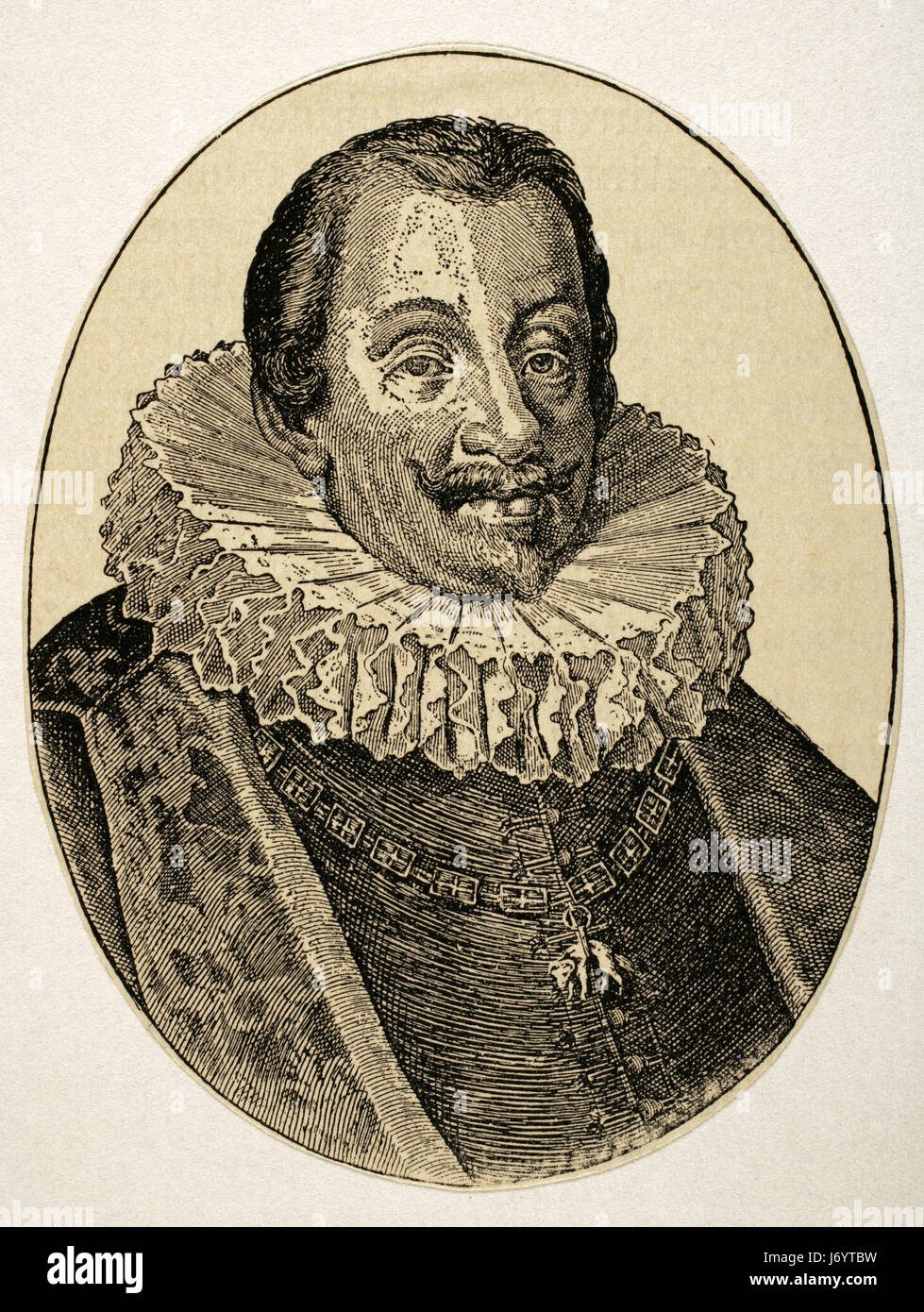 Ferdinand II of Habsburg (1578-1637). Holy Roman Emperor (1619-1637), King of Bohemia (1617-1619, 1620-1637), and King of Hungary (1618-1625). Portrait. Engraving by C. Dank. 'Historia Universal', 1881. Stock Photohttps://www.alamy.com/image-license-details/?v=1https://www.alamy.com/stock-photo-ferdinand-ii-of-habsburg-1578-1637-holy-roman-emperor-1619-1637-king-141982733.html
Ferdinand II of Habsburg (1578-1637). Holy Roman Emperor (1619-1637), King of Bohemia (1617-1619, 1620-1637), and King of Hungary (1618-1625). Portrait. Engraving by C. Dank. 'Historia Universal', 1881. Stock Photohttps://www.alamy.com/image-license-details/?v=1https://www.alamy.com/stock-photo-ferdinand-ii-of-habsburg-1578-1637-holy-roman-emperor-1619-1637-king-141982733.htmlRMJ6YTBW–Ferdinand II of Habsburg (1578-1637). Holy Roman Emperor (1619-1637), King of Bohemia (1617-1619, 1620-1637), and King of Hungary (1618-1625). Portrait. Engraving by C. Dank. 'Historia Universal', 1881.
 Eleonora, Wife of Ferdinand II, from the series Ferdinandus II et III Imperatorum Domus Austriacae... ca. 1625 Pieter Van Sompel Dutch Eleonora of Gonzaga became Holy Roman Empress, German Queen, and Queen Consort of Hungary and Bohemia upon her marriage to the widowed Holy Roman Emperor Ferdinand II. Raised at the ducal court in Mantua, a center of culture and science, she was exposed to and educated in foreign languages, history, music, and painting.. Eleonora, Wife of Ferdinand II, from the series Ferdinandus II et III Imperatorum Domus Austriacae.... Ferdinandus II et III Imperatorum Domus Stock Photohttps://www.alamy.com/image-license-details/?v=1https://www.alamy.com/eleonora-wife-of-ferdinand-ii-from-the-series-ferdinandus-ii-et-iii-imperatorum-domus-austriacae-ca-1625-pieter-van-sompel-dutch-eleonora-of-gonzaga-became-holy-roman-empress-german-queen-and-queen-consort-of-hungary-and-bohemia-upon-her-marriage-to-the-widowed-holy-roman-emperor-ferdinand-ii-raised-at-the-ducal-court-in-mantua-a-center-of-culture-and-science-she-was-exposed-to-and-educated-in-foreign-languages-history-music-and-painting-eleonora-wife-of-ferdinand-ii-from-the-series-ferdinandus-ii-et-iii-imperatorum-domus-austriacae-ferdinandus-ii-et-iii-imperatorum-domus-image457909510.html
Eleonora, Wife of Ferdinand II, from the series Ferdinandus II et III Imperatorum Domus Austriacae... ca. 1625 Pieter Van Sompel Dutch Eleonora of Gonzaga became Holy Roman Empress, German Queen, and Queen Consort of Hungary and Bohemia upon her marriage to the widowed Holy Roman Emperor Ferdinand II. Raised at the ducal court in Mantua, a center of culture and science, she was exposed to and educated in foreign languages, history, music, and painting.. Eleonora, Wife of Ferdinand II, from the series Ferdinandus II et III Imperatorum Domus Austriacae.... Ferdinandus II et III Imperatorum Domus Stock Photohttps://www.alamy.com/image-license-details/?v=1https://www.alamy.com/eleonora-wife-of-ferdinand-ii-from-the-series-ferdinandus-ii-et-iii-imperatorum-domus-austriacae-ca-1625-pieter-van-sompel-dutch-eleonora-of-gonzaga-became-holy-roman-empress-german-queen-and-queen-consort-of-hungary-and-bohemia-upon-her-marriage-to-the-widowed-holy-roman-emperor-ferdinand-ii-raised-at-the-ducal-court-in-mantua-a-center-of-culture-and-science-she-was-exposed-to-and-educated-in-foreign-languages-history-music-and-painting-eleonora-wife-of-ferdinand-ii-from-the-series-ferdinandus-ii-et-iii-imperatorum-domus-austriacae-ferdinandus-ii-et-iii-imperatorum-domus-image457909510.htmlRM2HGYG72–Eleonora, Wife of Ferdinand II, from the series Ferdinandus II et III Imperatorum Domus Austriacae... ca. 1625 Pieter Van Sompel Dutch Eleonora of Gonzaga became Holy Roman Empress, German Queen, and Queen Consort of Hungary and Bohemia upon her marriage to the widowed Holy Roman Emperor Ferdinand II. Raised at the ducal court in Mantua, a center of culture and science, she was exposed to and educated in foreign languages, history, music, and painting.. Eleonora, Wife of Ferdinand II, from the series Ferdinandus II et III Imperatorum Domus Austriacae.... Ferdinandus II et III Imperatorum Domus
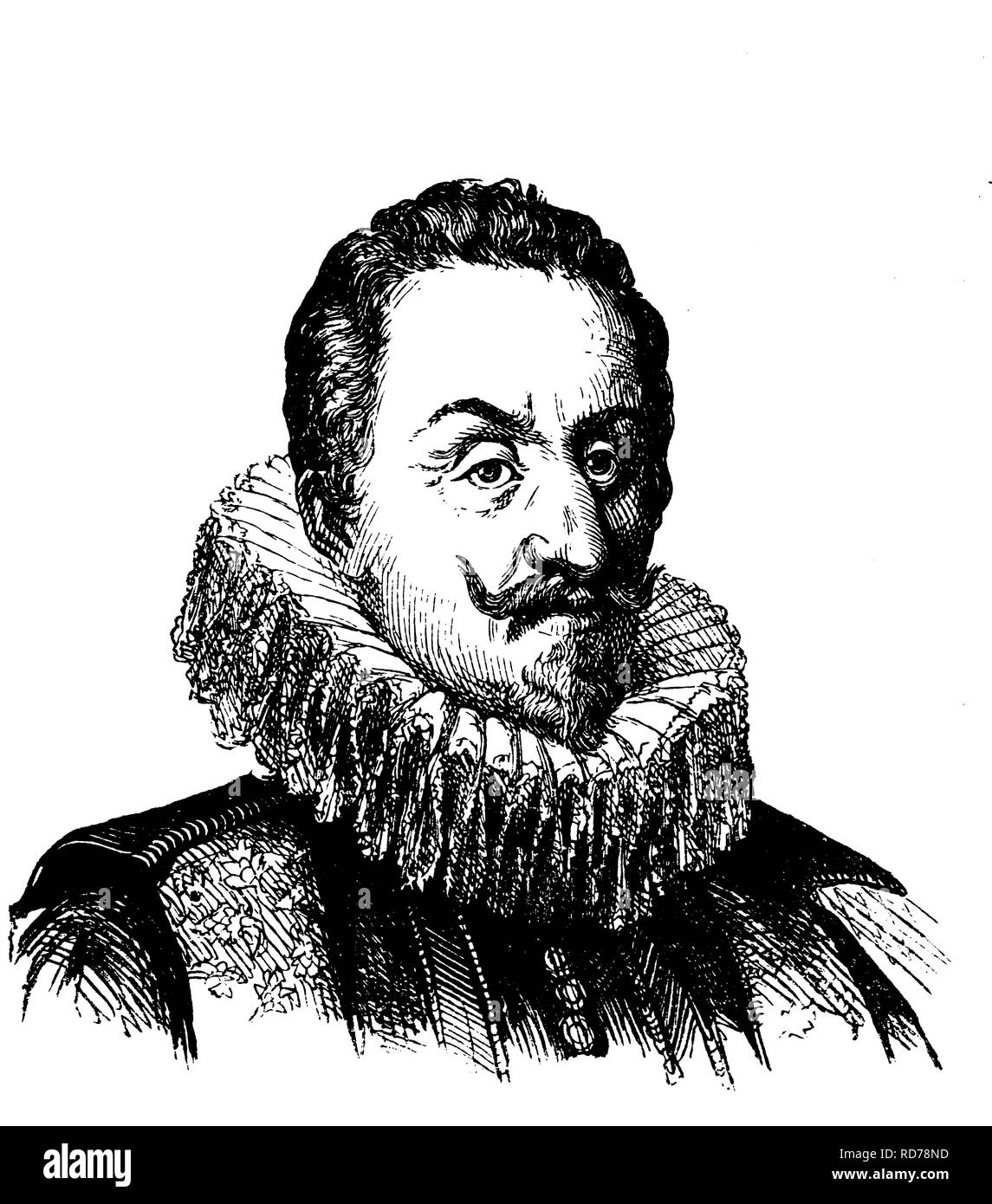 Ferdinand II, 1578 - 1637, King of Bohemia, Hungary, Croatia, Emperor of the Holy Roman Empire, historical woodcut, circa 1880 Stock Photohttps://www.alamy.com/image-license-details/?v=1https://www.alamy.com/ferdinand-ii-1578-1637-king-of-bohemia-hungary-croatia-emperor-of-the-holy-roman-empire-historical-woodcut-circa-1880-image231885849.html
Ferdinand II, 1578 - 1637, King of Bohemia, Hungary, Croatia, Emperor of the Holy Roman Empire, historical woodcut, circa 1880 Stock Photohttps://www.alamy.com/image-license-details/?v=1https://www.alamy.com/ferdinand-ii-1578-1637-king-of-bohemia-hungary-croatia-emperor-of-the-holy-roman-empire-historical-woodcut-circa-1880-image231885849.htmlRMRD78ND–Ferdinand II, 1578 - 1637, King of Bohemia, Hungary, Croatia, Emperor of the Holy Roman Empire, historical woodcut, circa 1880
![Portrait of Ferdinand II, Holy Roman Emperor (1578-1637) [detail] 17th century. 753 Justus Sustermans 028 Stock Photo Portrait of Ferdinand II, Holy Roman Emperor (1578-1637) [detail] 17th century. 753 Justus Sustermans 028 Stock Photo](https://c8.alamy.com/comp/MP8M6M/portrait-of-ferdinand-ii-holy-roman-emperor-1578-1637-detail-17th-century-753-justus-sustermans-028-MP8M6M.jpg) Portrait of Ferdinand II, Holy Roman Emperor (1578-1637) [detail] 17th century. 753 Justus Sustermans 028 Stock Photohttps://www.alamy.com/image-license-details/?v=1https://www.alamy.com/portrait-of-ferdinand-ii-holy-roman-emperor-1578-1637-detail-17th-century-753-justus-sustermans-028-image185817596.html
Portrait of Ferdinand II, Holy Roman Emperor (1578-1637) [detail] 17th century. 753 Justus Sustermans 028 Stock Photohttps://www.alamy.com/image-license-details/?v=1https://www.alamy.com/portrait-of-ferdinand-ii-holy-roman-emperor-1578-1637-detail-17th-century-753-justus-sustermans-028-image185817596.htmlRMMP8M6M–Portrait of Ferdinand II, Holy Roman Emperor (1578-1637) [detail] 17th century. 753 Justus Sustermans 028
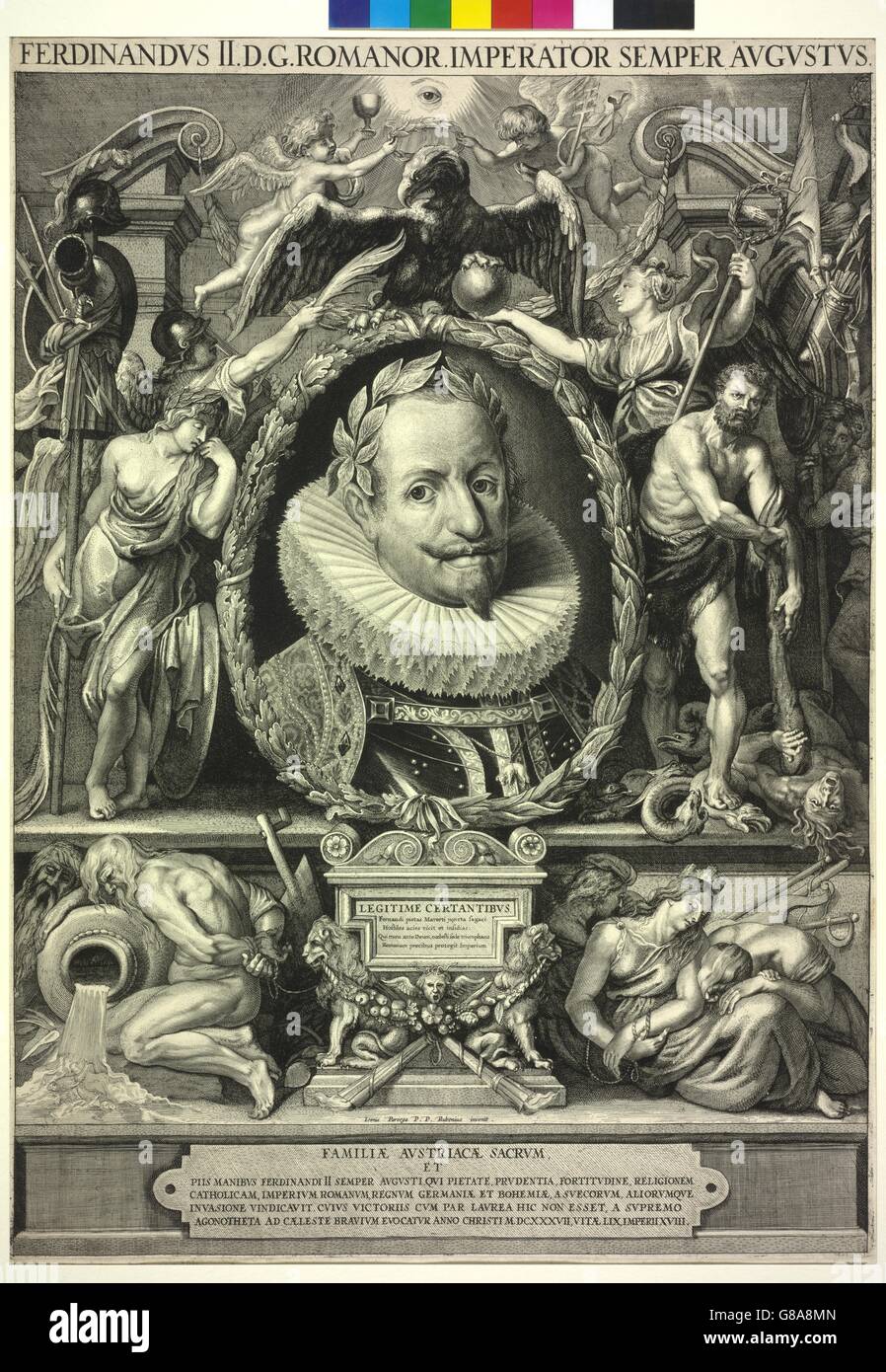 Ferdinand II., römisch-deutscher Kaiser Stock Photohttps://www.alamy.com/image-license-details/?v=1https://www.alamy.com/stock-photo-ferdinand-ii-rmisch-deutscher-kaiser-108405829.html
Ferdinand II., römisch-deutscher Kaiser Stock Photohttps://www.alamy.com/image-license-details/?v=1https://www.alamy.com/stock-photo-ferdinand-ii-rmisch-deutscher-kaiser-108405829.htmlRMG8A8MN–Ferdinand II., römisch-deutscher Kaiser
 Ferdinand I, Holy Roman Emperor 1503 – 1564. Central European monarch from the House of Habsburg. Archduke of Ruled the Austrian Hapsburg possessions as Archduke of Austria. After the death of his brother-in-law Louis II, Ferdinand ruled as King of Bohemia and Hungary (1526–1564). When Charles voluntarily retired in 1556, Ferdinand became his successor as Holy Roman Emperor. engraving by Martin Rota Kolunic c. 1540-1583 Stock Photohttps://www.alamy.com/image-license-details/?v=1https://www.alamy.com/stock-photo-ferdinand-i-holy-roman-emperor-1503-1564-central-european-monarch-57366197.html
Ferdinand I, Holy Roman Emperor 1503 – 1564. Central European monarch from the House of Habsburg. Archduke of Ruled the Austrian Hapsburg possessions as Archduke of Austria. After the death of his brother-in-law Louis II, Ferdinand ruled as King of Bohemia and Hungary (1526–1564). When Charles voluntarily retired in 1556, Ferdinand became his successor as Holy Roman Emperor. engraving by Martin Rota Kolunic c. 1540-1583 Stock Photohttps://www.alamy.com/image-license-details/?v=1https://www.alamy.com/stock-photo-ferdinand-i-holy-roman-emperor-1503-1564-central-european-monarch-57366197.htmlRMD9974N–Ferdinand I, Holy Roman Emperor 1503 – 1564. Central European monarch from the House of Habsburg. Archduke of Ruled the Austrian Hapsburg possessions as Archduke of Austria. After the death of his brother-in-law Louis II, Ferdinand ruled as King of Bohemia and Hungary (1526–1564). When Charles voluntarily retired in 1556, Ferdinand became his successor as Holy Roman Emperor. engraving by Martin Rota Kolunic c. 1540-1583
 VIENNA, AUSTIRA - JULI 5, 2021: The carved polychrome baroque satue of roman emperor Ferdinand II in the church Kapuzinerkirche from 17. cent.. Stock Photohttps://www.alamy.com/image-license-details/?v=1https://www.alamy.com/vienna-austira-juli-5-2021-the-carved-polychrome-baroque-satue-of-roman-emperor-ferdinand-ii-in-the-church-kapuzinerkirche-from-17-cent-image460273027.html
VIENNA, AUSTIRA - JULI 5, 2021: The carved polychrome baroque satue of roman emperor Ferdinand II in the church Kapuzinerkirche from 17. cent.. Stock Photohttps://www.alamy.com/image-license-details/?v=1https://www.alamy.com/vienna-austira-juli-5-2021-the-carved-polychrome-baroque-satue-of-roman-emperor-ferdinand-ii-in-the-church-kapuzinerkirche-from-17-cent-image460273027.htmlRF2HMR6XB–VIENNA, AUSTIRA - JULI 5, 2021: The carved polychrome baroque satue of roman emperor Ferdinand II in the church Kapuzinerkirche from 17. cent..
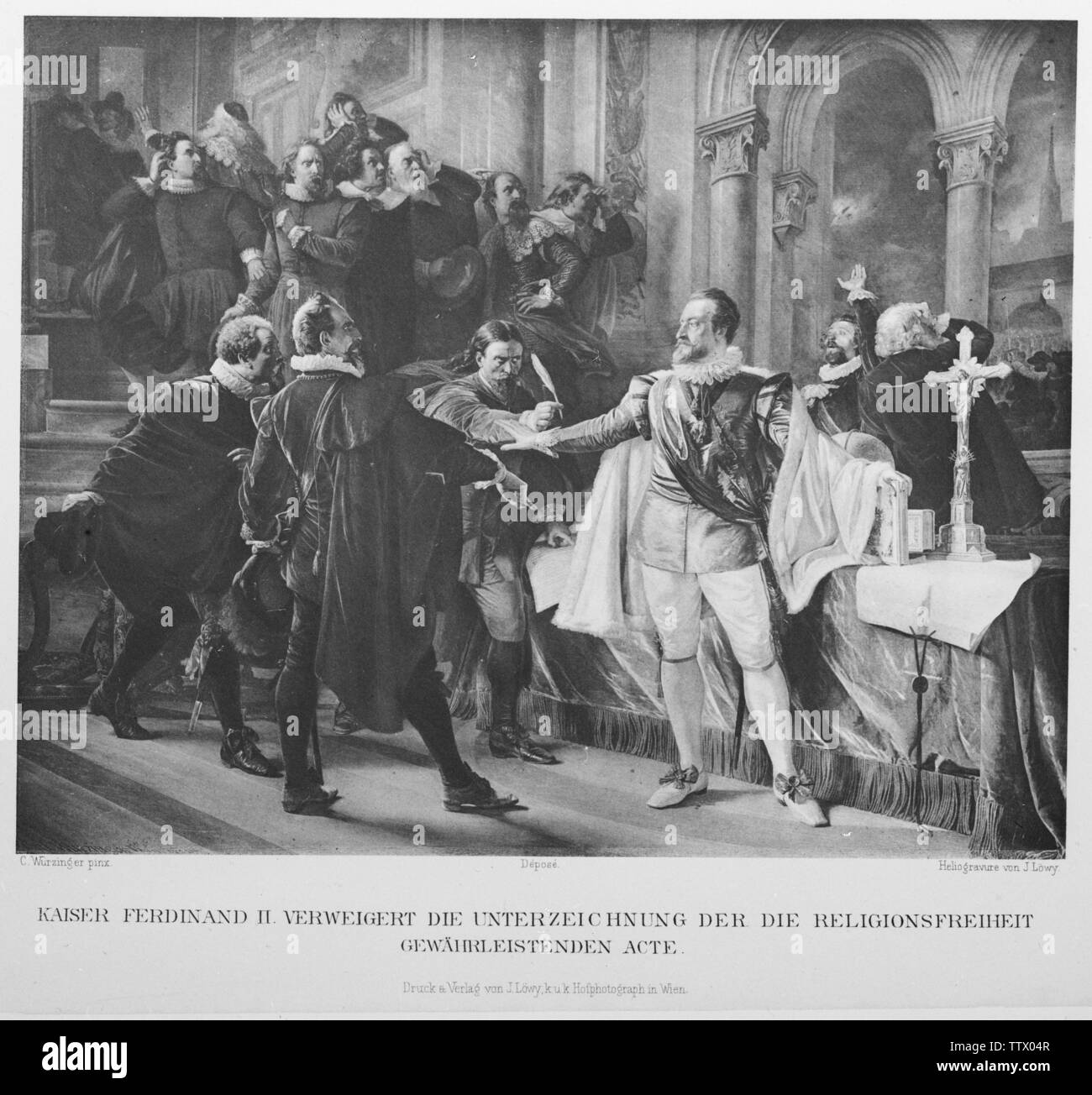 Ferdinand II, Holy Roman Emperor, refusing the signing of the religious liberty warrant dossier, painting by Karl Wurzinger, portrayed in a photoengraving, Additional-Rights-Clearance-Info-Not-Available Stock Photohttps://www.alamy.com/image-license-details/?v=1https://www.alamy.com/ferdinand-ii-holy-roman-emperor-refusing-the-signing-of-the-religious-liberty-warrant-dossier-painting-by-karl-wurzinger-portrayed-in-a-photoengraving-additional-rights-clearance-info-not-available-image256267783.html
Ferdinand II, Holy Roman Emperor, refusing the signing of the religious liberty warrant dossier, painting by Karl Wurzinger, portrayed in a photoengraving, Additional-Rights-Clearance-Info-Not-Available Stock Photohttps://www.alamy.com/image-license-details/?v=1https://www.alamy.com/ferdinand-ii-holy-roman-emperor-refusing-the-signing-of-the-religious-liberty-warrant-dossier-painting-by-karl-wurzinger-portrayed-in-a-photoengraving-additional-rights-clearance-info-not-available-image256267783.htmlRMTTX04R–Ferdinand II, Holy Roman Emperor, refusing the signing of the religious liberty warrant dossier, painting by Karl Wurzinger, portrayed in a photoengraving, Additional-Rights-Clearance-Info-Not-Available
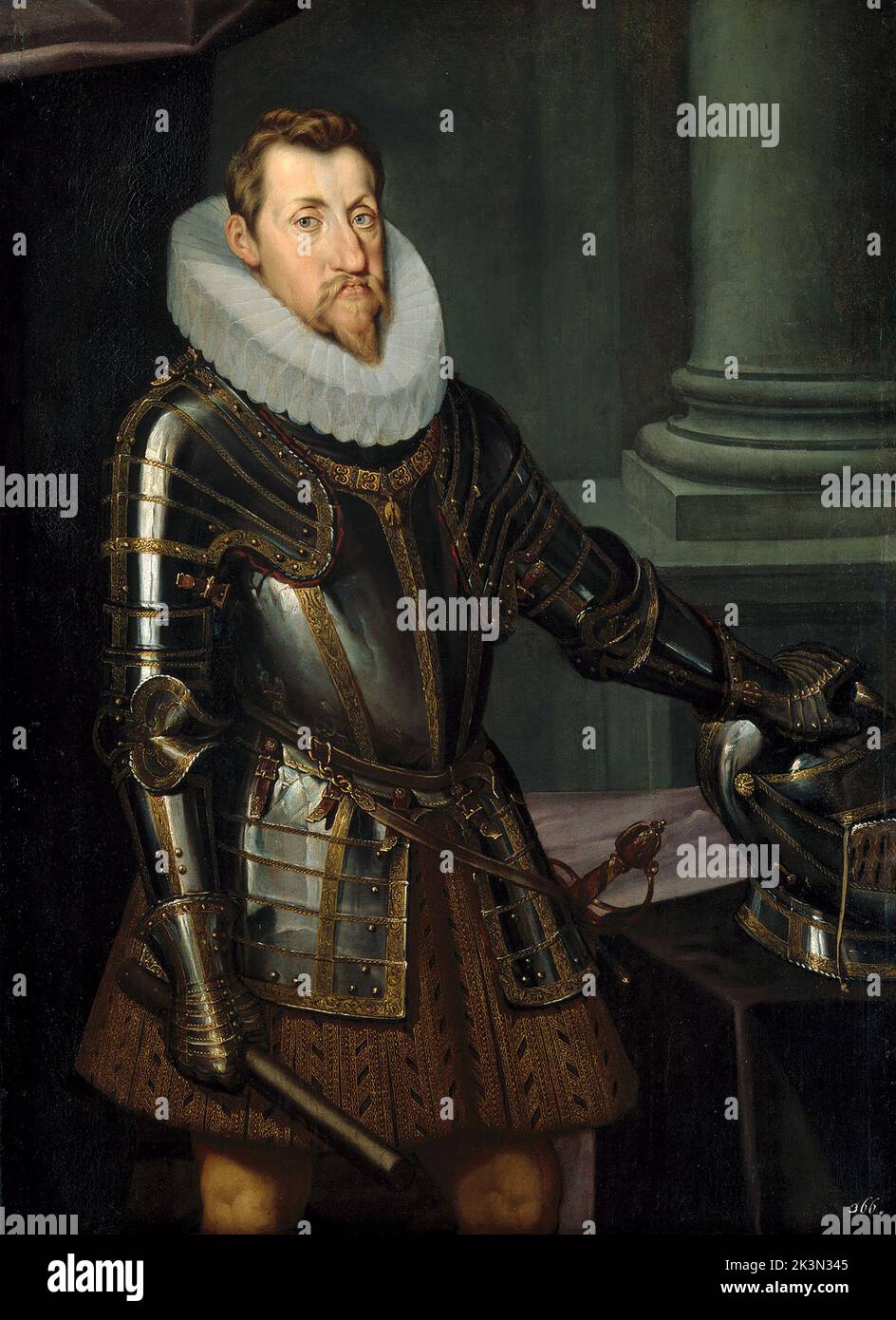 Ferdinand II (1578 – 1637) Holy Roman Emperor, King of Bohemia, Hungary, and Croatia from 1619 until his death in 1637. Stock Photohttps://www.alamy.com/image-license-details/?v=1https://www.alamy.com/ferdinand-ii-1578-1637-holy-roman-emperor-king-of-bohemia-hungary-and-croatia-from-1619-until-his-death-in-1637-image484197733.html
Ferdinand II (1578 – 1637) Holy Roman Emperor, King of Bohemia, Hungary, and Croatia from 1619 until his death in 1637. Stock Photohttps://www.alamy.com/image-license-details/?v=1https://www.alamy.com/ferdinand-ii-1578-1637-holy-roman-emperor-king-of-bohemia-hungary-and-croatia-from-1619-until-his-death-in-1637-image484197733.htmlRM2K3N345–Ferdinand II (1578 – 1637) Holy Roman Emperor, King of Bohemia, Hungary, and Croatia from 1619 until his death in 1637.
 Eleanora, wife of Holy Roman Emperor Ferdinand II. Engraver: Pieter Van Sompel, Flemish, 1600–after 1644After: Pieter Claesz. Soutman, Dutch, ca. 1580–1657 Stock Photohttps://www.alamy.com/image-license-details/?v=1https://www.alamy.com/eleanora-wife-of-holy-roman-emperor-ferdinand-ii-engraver-pieter-van-sompel-flemish-1600after-1644after-pieter-claesz-soutman-dutch-ca-15801657-image463152514.html
Eleanora, wife of Holy Roman Emperor Ferdinand II. Engraver: Pieter Van Sompel, Flemish, 1600–after 1644After: Pieter Claesz. Soutman, Dutch, ca. 1580–1657 Stock Photohttps://www.alamy.com/image-license-details/?v=1https://www.alamy.com/eleanora-wife-of-holy-roman-emperor-ferdinand-ii-engraver-pieter-van-sompel-flemish-1600after-1644after-pieter-claesz-soutman-dutch-ca-15801657-image463152514.htmlRM2HWEBN6–Eleanora, wife of Holy Roman Emperor Ferdinand II. Engraver: Pieter Van Sompel, Flemish, 1600–after 1644After: Pieter Claesz. Soutman, Dutch, ca. 1580–1657
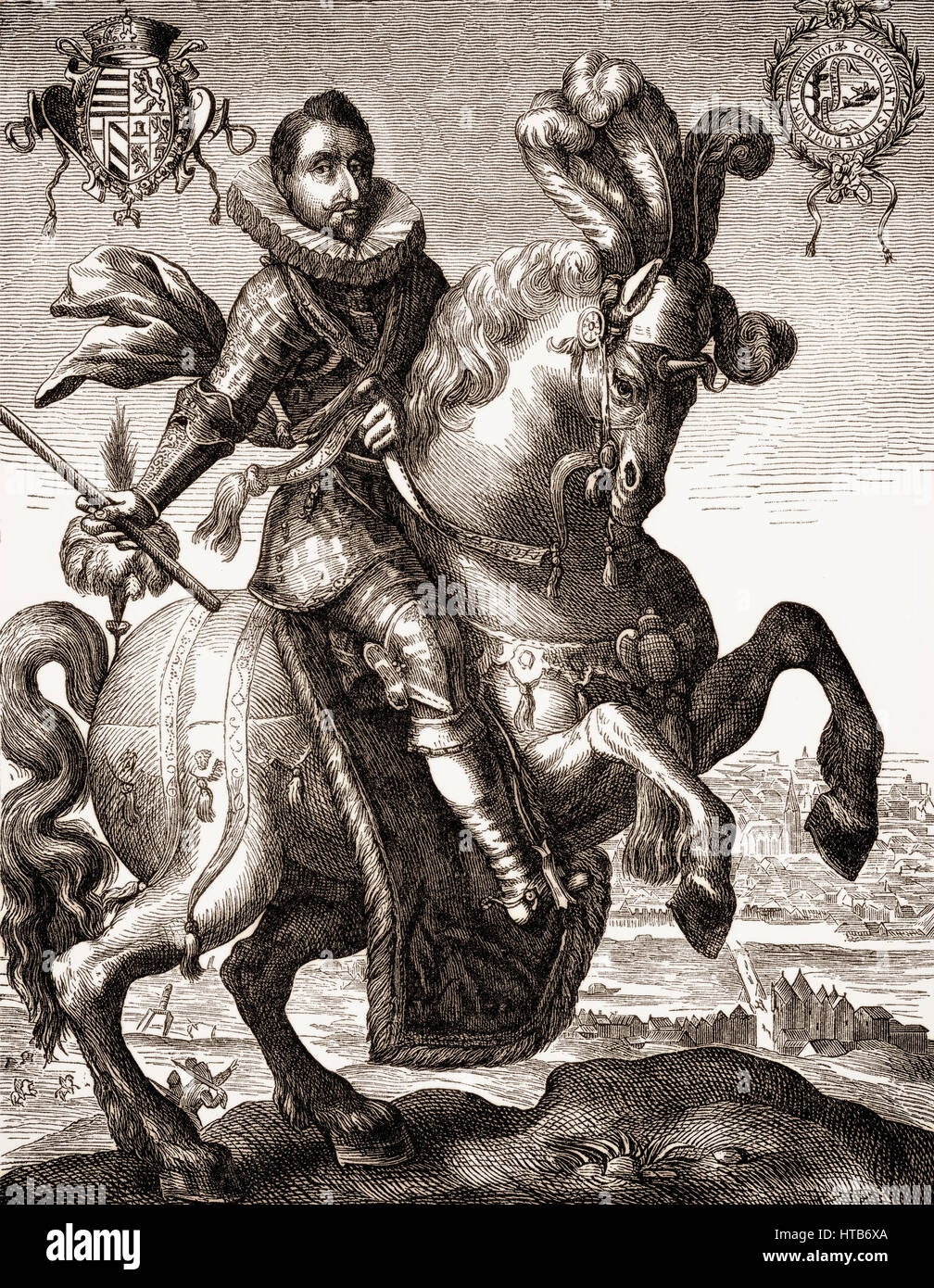 Ferdinand II, 1578-1637, Holy Roman Emperor Stock Photohttps://www.alamy.com/image-license-details/?v=1https://www.alamy.com/stock-photo-ferdinand-ii-1578-1637-holy-roman-emperor-135471234.html
Ferdinand II, 1578-1637, Holy Roman Emperor Stock Photohttps://www.alamy.com/image-license-details/?v=1https://www.alamy.com/stock-photo-ferdinand-ii-1578-1637-holy-roman-emperor-135471234.htmlRMHTB6XA–Ferdinand II, 1578-1637, Holy Roman Emperor
 Study for the 'Essequie' Conducted in San Lorenzo, Florence, in 1637 in Honour of Holy Roman Emperor Ferdinand II, 1637. Alfonso Parigi (Italian, 1606-1656). Pen and brown ink and brown wash with graphite and accents of pink, purple-grey and deep blue-black wash; sheet: 48.5 x 65.8 cm (19 1/8 x 25 7/8 in.). Stock Photohttps://www.alamy.com/image-license-details/?v=1https://www.alamy.com/study-for-the-essequie-conducted-in-san-lorenzo-florence-in-1637-in-honour-of-holy-roman-emperor-ferdinand-ii-1637-alfonso-parigi-italian-1606-1656-pen-and-brown-ink-and-brown-wash-with-graphite-and-accents-of-pink-purple-grey-and-deep-blue-black-wash-sheet-485-x-658-cm-19-18-x-25-78-in-image448109009.html
Study for the 'Essequie' Conducted in San Lorenzo, Florence, in 1637 in Honour of Holy Roman Emperor Ferdinand II, 1637. Alfonso Parigi (Italian, 1606-1656). Pen and brown ink and brown wash with graphite and accents of pink, purple-grey and deep blue-black wash; sheet: 48.5 x 65.8 cm (19 1/8 x 25 7/8 in.). Stock Photohttps://www.alamy.com/image-license-details/?v=1https://www.alamy.com/study-for-the-essequie-conducted-in-san-lorenzo-florence-in-1637-in-honour-of-holy-roman-emperor-ferdinand-ii-1637-alfonso-parigi-italian-1606-1656-pen-and-brown-ink-and-brown-wash-with-graphite-and-accents-of-pink-purple-grey-and-deep-blue-black-wash-sheet-485-x-658-cm-19-18-x-25-78-in-image448109009.htmlRM2H113H5–Study for the 'Essequie' Conducted in San Lorenzo, Florence, in 1637 in Honour of Holy Roman Emperor Ferdinand II, 1637. Alfonso Parigi (Italian, 1606-1656). Pen and brown ink and brown wash with graphite and accents of pink, purple-grey and deep blue-black wash; sheet: 48.5 x 65.8 cm (19 1/8 x 25 7/8 in.).
 Ferdinand III, 1608 - 1657. From 1621 Archduke of Austria, from 1625 King of Hungary, from 1627 King of Croatia and Bohemia and Holy Roman Emperor from 1637 until his death. After a 17th century work by Cornelis Bloemaert II. Stock Photohttps://www.alamy.com/image-license-details/?v=1https://www.alamy.com/ferdinand-iii-1608-1657-from-1621-archduke-of-austria-from-1625-king-of-hungary-from-1627-king-of-croatia-and-bohemia-and-holy-roman-emperor-from-1637-until-his-death-after-a-17th-century-work-by-cornelis-bloemaert-ii-image440578051.html
Ferdinand III, 1608 - 1657. From 1621 Archduke of Austria, from 1625 King of Hungary, from 1627 King of Croatia and Bohemia and Holy Roman Emperor from 1637 until his death. After a 17th century work by Cornelis Bloemaert II. Stock Photohttps://www.alamy.com/image-license-details/?v=1https://www.alamy.com/ferdinand-iii-1608-1657-from-1621-archduke-of-austria-from-1625-king-of-hungary-from-1627-king-of-croatia-and-bohemia-and-holy-roman-emperor-from-1637-until-his-death-after-a-17th-century-work-by-cornelis-bloemaert-ii-image440578051.htmlRM2GGP1PB–Ferdinand III, 1608 - 1657. From 1621 Archduke of Austria, from 1625 King of Hungary, from 1627 King of Croatia and Bohemia and Holy Roman Emperor from 1637 until his death. After a 17th century work by Cornelis Bloemaert II.
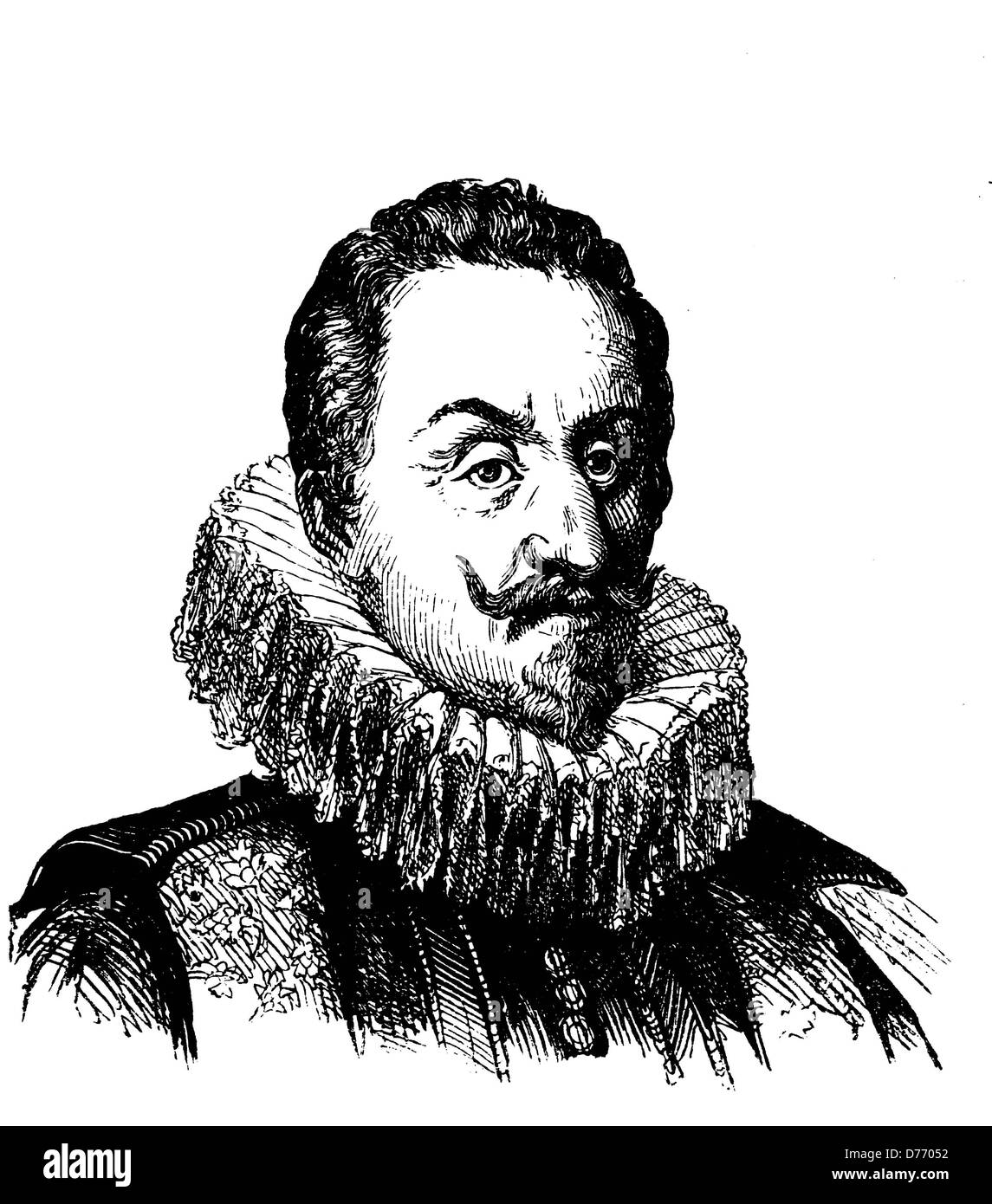 Ferdinand II, 1578 - 1637, King of Bohemia, Hungary, Croatia, Emperor of the Holy Roman Empire, historical woodcut, circa 1880 Stock Photohttps://www.alamy.com/image-license-details/?v=1https://www.alamy.com/stock-photo-ferdinand-ii-1578-1637-king-of-bohemia-hungary-croatia-emperor-of-56087502.html
Ferdinand II, 1578 - 1637, King of Bohemia, Hungary, Croatia, Emperor of the Holy Roman Empire, historical woodcut, circa 1880 Stock Photohttps://www.alamy.com/image-license-details/?v=1https://www.alamy.com/stock-photo-ferdinand-ii-1578-1637-king-of-bohemia-hungary-croatia-emperor-of-56087502.htmlRFD77052–Ferdinand II, 1578 - 1637, King of Bohemia, Hungary, Croatia, Emperor of the Holy Roman Empire, historical woodcut, circa 1880
 Glaive of the Bodyguard of Archduke Ferdinand of Austria, later Emperor Ferdinand II (1578–1637) 1590–1617 Austrian The long, sharply pointed knife-like blade has a convex cutting edge and has a short back edge near the point. The rectangular socket was formerly mounted with two side straps (now cut off). Each side of the blade is etched with a shield bearing the arms of Archduke Ferdinand of Austria (1578–1637), later Holy Roman Emperor Ferdinand II, surrounded by a collar of the Order of the Golden Fleece and surmounted by an archducal bonnet, above which is the monogram F. The back and base Stock Photohttps://www.alamy.com/image-license-details/?v=1https://www.alamy.com/glaive-of-the-bodyguard-of-archduke-ferdinand-of-austria-later-emperor-ferdinand-ii-15781637-15901617-austrian-the-long-sharply-pointed-knife-like-blade-has-a-convex-cutting-edge-and-has-a-short-back-edge-near-the-point-the-rectangular-socket-was-formerly-mounted-with-two-side-straps-now-cut-off-each-side-of-the-blade-is-etched-with-a-shield-bearing-the-arms-of-archduke-ferdinand-of-austria-15781637-later-holy-roman-emperor-ferdinand-ii-surrounded-by-a-collar-of-the-order-of-the-golden-fleece-and-surmounted-by-an-archducal-bonnet-above-which-is-the-monogram-f-the-back-and-base-image458508665.html
Glaive of the Bodyguard of Archduke Ferdinand of Austria, later Emperor Ferdinand II (1578–1637) 1590–1617 Austrian The long, sharply pointed knife-like blade has a convex cutting edge and has a short back edge near the point. The rectangular socket was formerly mounted with two side straps (now cut off). Each side of the blade is etched with a shield bearing the arms of Archduke Ferdinand of Austria (1578–1637), later Holy Roman Emperor Ferdinand II, surrounded by a collar of the Order of the Golden Fleece and surmounted by an archducal bonnet, above which is the monogram F. The back and base Stock Photohttps://www.alamy.com/image-license-details/?v=1https://www.alamy.com/glaive-of-the-bodyguard-of-archduke-ferdinand-of-austria-later-emperor-ferdinand-ii-15781637-15901617-austrian-the-long-sharply-pointed-knife-like-blade-has-a-convex-cutting-edge-and-has-a-short-back-edge-near-the-point-the-rectangular-socket-was-formerly-mounted-with-two-side-straps-now-cut-off-each-side-of-the-blade-is-etched-with-a-shield-bearing-the-arms-of-archduke-ferdinand-of-austria-15781637-later-holy-roman-emperor-ferdinand-ii-surrounded-by-a-collar-of-the-order-of-the-golden-fleece-and-surmounted-by-an-archducal-bonnet-above-which-is-the-monogram-f-the-back-and-base-image458508665.htmlRM2HHXTDD–Glaive of the Bodyguard of Archduke Ferdinand of Austria, later Emperor Ferdinand II (1578–1637) 1590–1617 Austrian The long, sharply pointed knife-like blade has a convex cutting edge and has a short back edge near the point. The rectangular socket was formerly mounted with two side straps (now cut off). Each side of the blade is etched with a shield bearing the arms of Archduke Ferdinand of Austria (1578–1637), later Holy Roman Emperor Ferdinand II, surrounded by a collar of the Order of the Golden Fleece and surmounted by an archducal bonnet, above which is the monogram F. The back and base
 Antique 19th century germany numismatic illustrated catalogue with interesting printing technics / Antiker numismatischer illustrierter Katalog aus dem 19. Jahrhundert mit interessanter Drucktechnik : Thaler von Kaiser Ferdinand II. ( 1619- 1637 ) Holy Roman Emperor / Thaler of Emperor Ferdinand II. / 1578–1637, ruled 1619–37 / Mint: Augsburg Stock Photohttps://www.alamy.com/image-license-details/?v=1https://www.alamy.com/antique-19th-century-germany-numismatic-illustrated-catalogue-with-interesting-printing-technics-antiker-numismatischer-illustrierter-katalog-aus-dem-19-jahrhundert-mit-interessanter-drucktechnik-thaler-von-kaiser-ferdinand-ii-1619-1637-holy-roman-emperor-thaler-of-emperor-ferdinand-ii-15781637-ruled-161937-mint-augsburg-image488622981.html
Antique 19th century germany numismatic illustrated catalogue with interesting printing technics / Antiker numismatischer illustrierter Katalog aus dem 19. Jahrhundert mit interessanter Drucktechnik : Thaler von Kaiser Ferdinand II. ( 1619- 1637 ) Holy Roman Emperor / Thaler of Emperor Ferdinand II. / 1578–1637, ruled 1619–37 / Mint: Augsburg Stock Photohttps://www.alamy.com/image-license-details/?v=1https://www.alamy.com/antique-19th-century-germany-numismatic-illustrated-catalogue-with-interesting-printing-technics-antiker-numismatischer-illustrierter-katalog-aus-dem-19-jahrhundert-mit-interessanter-drucktechnik-thaler-von-kaiser-ferdinand-ii-1619-1637-holy-roman-emperor-thaler-of-emperor-ferdinand-ii-15781637-ruled-161937-mint-augsburg-image488622981.htmlRM2KAXKGN–Antique 19th century germany numismatic illustrated catalogue with interesting printing technics / Antiker numismatischer illustrierter Katalog aus dem 19. Jahrhundert mit interessanter Drucktechnik : Thaler von Kaiser Ferdinand II. ( 1619- 1637 ) Holy Roman Emperor / Thaler of Emperor Ferdinand II. / 1578–1637, ruled 1619–37 / Mint: Augsburg
 Portrait of Ferdinand Francis Ferdinand IV, King of Hungary, Bohemia and the Holy Roman Empire, eldest son of Emperor Ferdinand III He holds his left hand at his side and with his right hand he points to the frame below In the background a crown The portrait is framed in an oval in a cartouche with eagles and a crown In the frame, a three-line caption in Latin, Portrait of Ferdinand IV, King of Hungary, Bohemia and the Holy Roman Empire Theater of Bishops, Emperors, Kings, Dukes, Princes, etc Theatrum pontificum, imperatorum, regum, ducum, principum, etc , publisher: Pieter de Jode (II), ( Stock Photohttps://www.alamy.com/image-license-details/?v=1https://www.alamy.com/portrait-of-ferdinand-francis-ferdinand-iv-king-of-hungary-bohemia-and-the-holy-roman-empire-eldest-son-of-emperor-ferdinand-iii-he-holds-his-left-hand-at-his-side-and-with-his-right-hand-he-points-to-the-frame-below-in-the-background-a-crown-the-portrait-is-framed-in-an-oval-in-a-cartouche-with-eagles-and-a-crown-in-the-frame-a-three-line-caption-in-latin-portrait-of-ferdinand-iv-king-of-hungary-bohemia-and-the-holy-roman-empire-theater-of-bishops-emperors-kings-dukes-princes-etc-theatrum-pontificum-imperatorum-regum-ducum-principum-etc-publisher-pieter-de-jode-ii-image472304150.html
Portrait of Ferdinand Francis Ferdinand IV, King of Hungary, Bohemia and the Holy Roman Empire, eldest son of Emperor Ferdinand III He holds his left hand at his side and with his right hand he points to the frame below In the background a crown The portrait is framed in an oval in a cartouche with eagles and a crown In the frame, a three-line caption in Latin, Portrait of Ferdinand IV, King of Hungary, Bohemia and the Holy Roman Empire Theater of Bishops, Emperors, Kings, Dukes, Princes, etc Theatrum pontificum, imperatorum, regum, ducum, principum, etc , publisher: Pieter de Jode (II), ( Stock Photohttps://www.alamy.com/image-license-details/?v=1https://www.alamy.com/portrait-of-ferdinand-francis-ferdinand-iv-king-of-hungary-bohemia-and-the-holy-roman-empire-eldest-son-of-emperor-ferdinand-iii-he-holds-his-left-hand-at-his-side-and-with-his-right-hand-he-points-to-the-frame-below-in-the-background-a-crown-the-portrait-is-framed-in-an-oval-in-a-cartouche-with-eagles-and-a-crown-in-the-frame-a-three-line-caption-in-latin-portrait-of-ferdinand-iv-king-of-hungary-bohemia-and-the-holy-roman-empire-theater-of-bishops-emperors-kings-dukes-princes-etc-theatrum-pontificum-imperatorum-regum-ducum-principum-etc-publisher-pieter-de-jode-ii-image472304150.htmlRM2JCB8NA–Portrait of Ferdinand Francis Ferdinand IV, King of Hungary, Bohemia and the Holy Roman Empire, eldest son of Emperor Ferdinand III He holds his left hand at his side and with his right hand he points to the frame below In the background a crown The portrait is framed in an oval in a cartouche with eagles and a crown In the frame, a three-line caption in Latin, Portrait of Ferdinand IV, King of Hungary, Bohemia and the Holy Roman Empire Theater of Bishops, Emperors, Kings, Dukes, Princes, etc Theatrum pontificum, imperatorum, regum, ducum, principum, etc , publisher: Pieter de Jode (II), (
 Kaiser Franz I. u. a. Stock Photohttps://www.alamy.com/image-license-details/?v=1https://www.alamy.com/stock-photo-kaiser-franz-i-u-a-108404930.html
Kaiser Franz I. u. a. Stock Photohttps://www.alamy.com/image-license-details/?v=1https://www.alamy.com/stock-photo-kaiser-franz-i-u-a-108404930.htmlRMG8A7GJ–Kaiser Franz I. u. a.
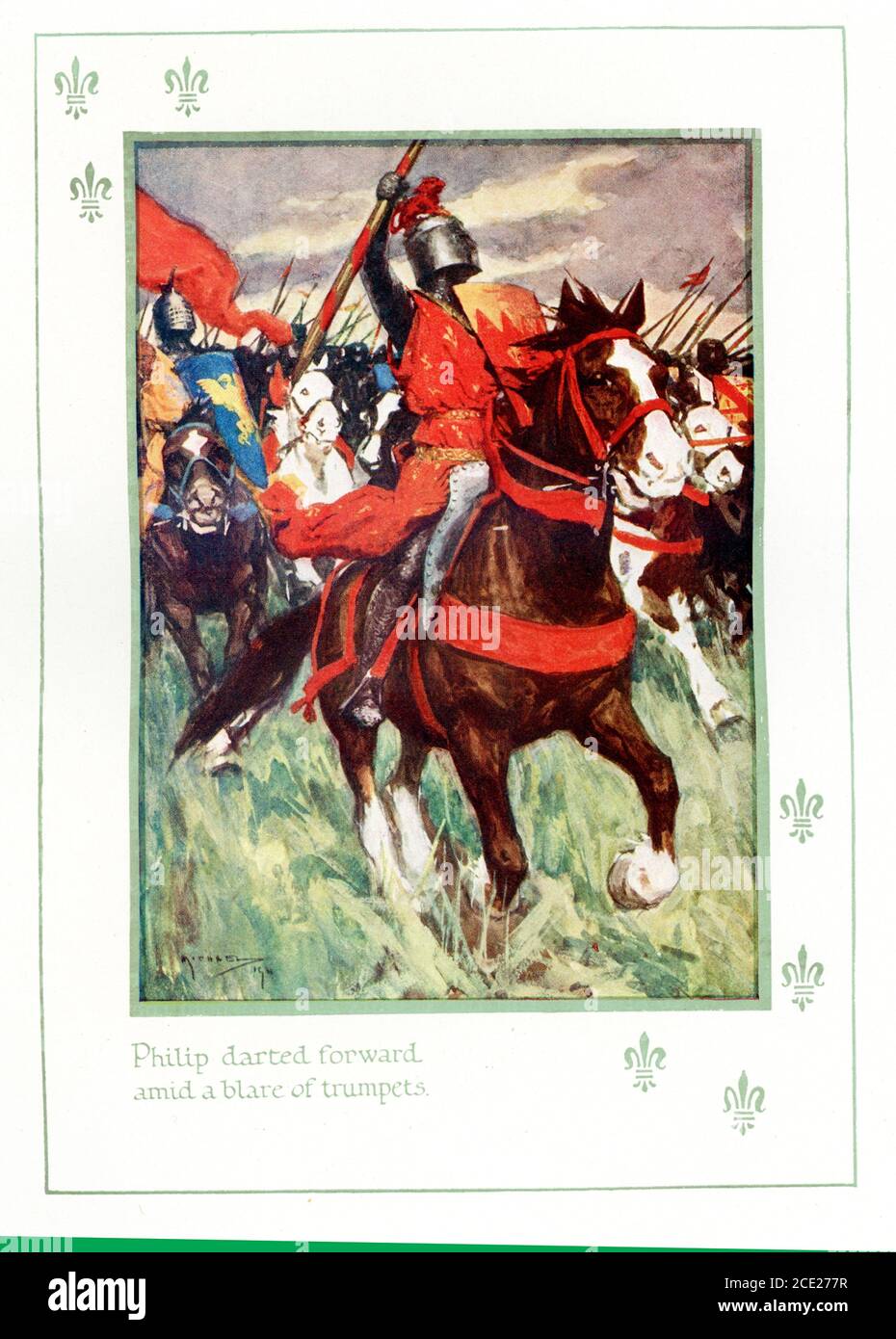 The caption reads: Philip darted forward amid blare of trumpets Philip Augustus and Louis VIII at Battle of Bouvines. The Battle of Bouvines (July 27, 1214) gave a decisive victory to the French king Philip II Augustus over an international coalition of the Holy Roman emperor Otto IV, King John of England, and the French vassals-Ferdinand (Ferrand) of Portugal, count of Flanders, and Renaud (Raynald) of Dammartin, count of Boulogne. The victory enhanced the power and the prestige of the French monarchy in France and in the rest of Europe Stock Photohttps://www.alamy.com/image-license-details/?v=1https://www.alamy.com/the-caption-reads-philip-darted-forward-amid-blare-of-trumpets-philip-augustus-and-louis-viii-at-battle-of-bouvines-the-battle-of-bouvines-july-27-1214-gave-a-decisive-victory-to-the-french-kingphilip-iiaugustus-over-an-international-coalition-of-the-holy-roman-emperorotto-iv-kingjohnofengland-and-the-french-vassals-ferdinand-ferrand-of-portugal-count-offlanders-andrenaudraynald-of-dammartin-count-ofboulogne-the-victoryenhancedthe-power-and-theprestigeof-the-french-monarchy-infranceand-in-the-rest-of-europe-image370072523.html
The caption reads: Philip darted forward amid blare of trumpets Philip Augustus and Louis VIII at Battle of Bouvines. The Battle of Bouvines (July 27, 1214) gave a decisive victory to the French king Philip II Augustus over an international coalition of the Holy Roman emperor Otto IV, King John of England, and the French vassals-Ferdinand (Ferrand) of Portugal, count of Flanders, and Renaud (Raynald) of Dammartin, count of Boulogne. The victory enhanced the power and the prestige of the French monarchy in France and in the rest of Europe Stock Photohttps://www.alamy.com/image-license-details/?v=1https://www.alamy.com/the-caption-reads-philip-darted-forward-amid-blare-of-trumpets-philip-augustus-and-louis-viii-at-battle-of-bouvines-the-battle-of-bouvines-july-27-1214-gave-a-decisive-victory-to-the-french-kingphilip-iiaugustus-over-an-international-coalition-of-the-holy-roman-emperorotto-iv-kingjohnofengland-and-the-french-vassals-ferdinand-ferrand-of-portugal-count-offlanders-andrenaudraynald-of-dammartin-count-ofboulogne-the-victoryenhancedthe-power-and-theprestigeof-the-french-monarchy-infranceand-in-the-rest-of-europe-image370072523.htmlRF2CE277R–The caption reads: Philip darted forward amid blare of trumpets Philip Augustus and Louis VIII at Battle of Bouvines. The Battle of Bouvines (July 27, 1214) gave a decisive victory to the French king Philip II Augustus over an international coalition of the Holy Roman emperor Otto IV, King John of England, and the French vassals-Ferdinand (Ferrand) of Portugal, count of Flanders, and Renaud (Raynald) of Dammartin, count of Boulogne. The victory enhanced the power and the prestige of the French monarchy in France and in the rest of Europe
 Gold medals of Holy Roman Emperor Joseph II by Johann Nepomuk Wirt, Pope Pius VI, and King Ferdinand IV and Maria Carolina Naples and Sicily by Martin Krafft, given to Thomas Martyn. Aurea Numismata. Copperplate engraving from Thomas Martyn’s The English Entomologist, Exhibiting all the Coleopterous Insects found in England, Academy for Illustrating and Painting Natural History, London, 1792. Stock Photohttps://www.alamy.com/image-license-details/?v=1https://www.alamy.com/gold-medals-of-holy-roman-emperor-joseph-ii-by-johann-nepomuk-wirt-pope-pius-vi-and-king-ferdinand-iv-and-maria-carolina-naples-and-sicily-by-martin-krafft-given-to-thomas-martyn-aurea-numismata-copperplate-engraving-from-thomas-martyns-the-english-entomologist-exhibiting-all-the-coleopterous-insects-found-in-england-academy-for-illustrating-and-painting-natural-history-london-1792-image518642855.html
Gold medals of Holy Roman Emperor Joseph II by Johann Nepomuk Wirt, Pope Pius VI, and King Ferdinand IV and Maria Carolina Naples and Sicily by Martin Krafft, given to Thomas Martyn. Aurea Numismata. Copperplate engraving from Thomas Martyn’s The English Entomologist, Exhibiting all the Coleopterous Insects found in England, Academy for Illustrating and Painting Natural History, London, 1792. Stock Photohttps://www.alamy.com/image-license-details/?v=1https://www.alamy.com/gold-medals-of-holy-roman-emperor-joseph-ii-by-johann-nepomuk-wirt-pope-pius-vi-and-king-ferdinand-iv-and-maria-carolina-naples-and-sicily-by-martin-krafft-given-to-thomas-martyn-aurea-numismata-copperplate-engraving-from-thomas-martyns-the-english-entomologist-exhibiting-all-the-coleopterous-insects-found-in-england-academy-for-illustrating-and-painting-natural-history-london-1792-image518642855.htmlRM2N3P673–Gold medals of Holy Roman Emperor Joseph II by Johann Nepomuk Wirt, Pope Pius VI, and King Ferdinand IV and Maria Carolina Naples and Sicily by Martin Krafft, given to Thomas Martyn. Aurea Numismata. Copperplate engraving from Thomas Martyn’s The English Entomologist, Exhibiting all the Coleopterous Insects found in England, Academy for Illustrating and Painting Natural History, London, 1792.
 Maximilian II (1527 – 1576), a member of the Austrian House of Habsburg, Holy Roman Emperor, King of Bohemia in Prague on 14 May 1562 and elected King of Germany (King of the Romans) on 24 November 1562. On 8 September 1563 he was crowned King of Hungary and Croatia, he succeeded his father Ferdinand I as ruler of the Holy Roman Empire Stock Photohttps://www.alamy.com/image-license-details/?v=1https://www.alamy.com/maximilian-ii-1527-1576-a-member-of-the-austrian-house-of-habsburg-holy-roman-emperor-king-of-bohemia-in-prague-on-14-may-1562-and-elected-king-of-germany-king-of-the-romans-on-24-november-1562-on-8-september-1563-he-was-crowned-king-of-hungary-and-croatia-he-succeeded-his-father-ferdinand-i-as-ruler-of-the-holy-roman-empire-image230637206.html
Maximilian II (1527 – 1576), a member of the Austrian House of Habsburg, Holy Roman Emperor, King of Bohemia in Prague on 14 May 1562 and elected King of Germany (King of the Romans) on 24 November 1562. On 8 September 1563 he was crowned King of Hungary and Croatia, he succeeded his father Ferdinand I as ruler of the Holy Roman Empire Stock Photohttps://www.alamy.com/image-license-details/?v=1https://www.alamy.com/maximilian-ii-1527-1576-a-member-of-the-austrian-house-of-habsburg-holy-roman-emperor-king-of-bohemia-in-prague-on-14-may-1562-and-elected-king-of-germany-king-of-the-romans-on-24-november-1562-on-8-september-1563-he-was-crowned-king-of-hungary-and-croatia-he-succeeded-his-father-ferdinand-i-as-ruler-of-the-holy-roman-empire-image230637206.htmlRMRB6C32–Maximilian II (1527 – 1576), a member of the Austrian House of Habsburg, Holy Roman Emperor, King of Bohemia in Prague on 14 May 1562 and elected King of Germany (King of the Romans) on 24 November 1562. On 8 September 1563 he was crowned King of Hungary and Croatia, he succeeded his father Ferdinand I as ruler of the Holy Roman Empire
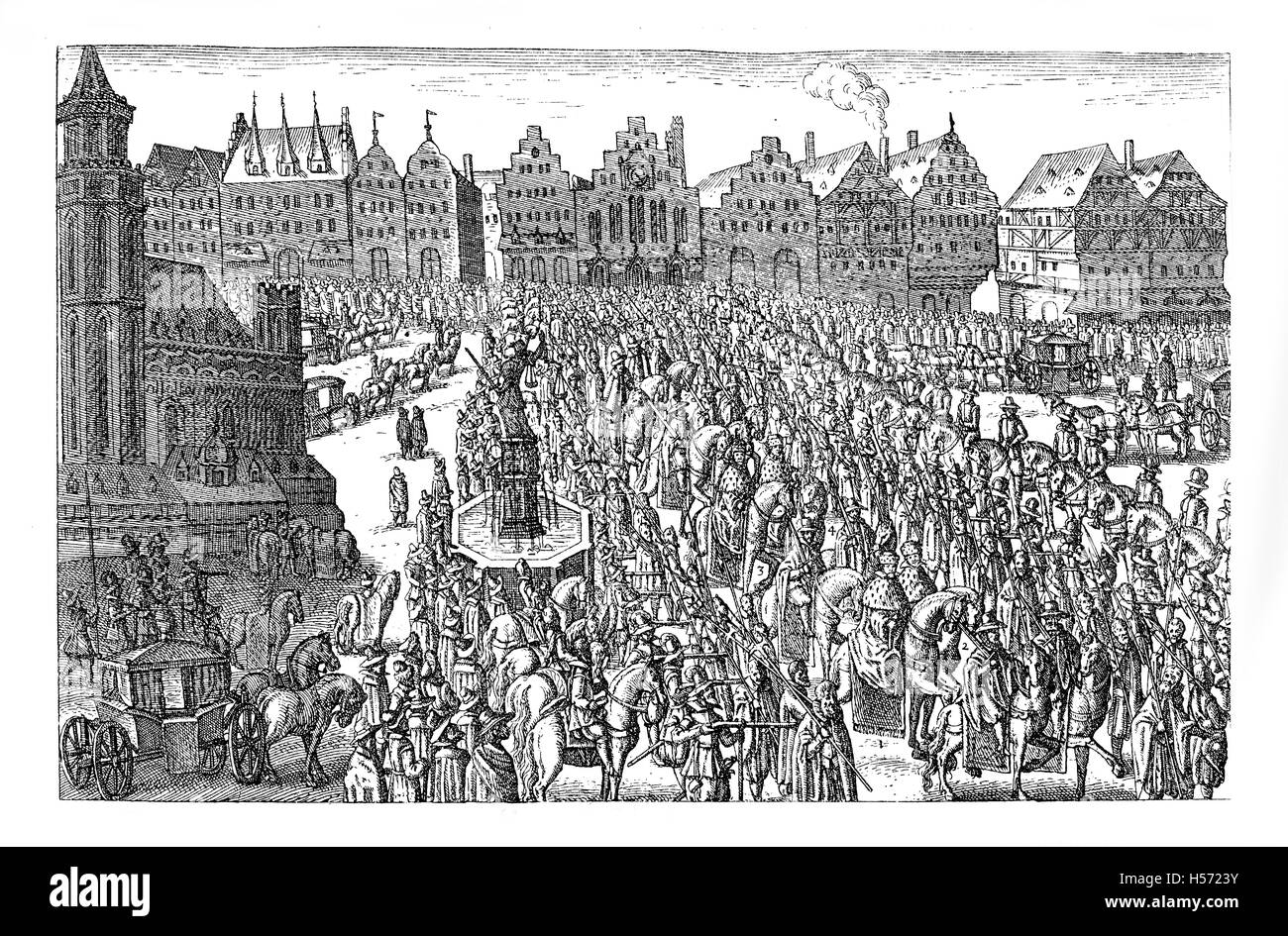 Ferdinand II of Habsburg crowning as Holy Roman Emperor in Frankfurt, year 1619 Stock Photohttps://www.alamy.com/image-license-details/?v=1https://www.alamy.com/stock-photo-ferdinand-ii-of-habsburg-crowning-as-holy-roman-emperor-in-frankfurt-123701199.html
Ferdinand II of Habsburg crowning as Holy Roman Emperor in Frankfurt, year 1619 Stock Photohttps://www.alamy.com/image-license-details/?v=1https://www.alamy.com/stock-photo-ferdinand-ii-of-habsburg-crowning-as-holy-roman-emperor-in-frankfurt-123701199.htmlRFH5723Y–Ferdinand II of Habsburg crowning as Holy Roman Emperor in Frankfurt, year 1619
![. Deutsch: Albrecht Wenzel Eusebius von Waldstein, genannt „Wallenstein“]], böhmischer General im Dienste Ferdinand II. English: Albrecht von Wallenstein (24 September 1583 – 25 February 1634), was a Bohemian military leader and politician, who offered his services and an army of 30,000 to 100,000 men during the Thirty Years' War (1618–48), to the Holy Roman Emperor Ferdinand II. He became the supreme commander of the armies of the Habsburg Monarchy and a major figure of the Thirty Years' War. . circa 1700. Unknown Albrecht Wallenstein Stock Photo . Deutsch: Albrecht Wenzel Eusebius von Waldstein, genannt „Wallenstein“]], böhmischer General im Dienste Ferdinand II. English: Albrecht von Wallenstein (24 September 1583 – 25 February 1634), was a Bohemian military leader and politician, who offered his services and an army of 30,000 to 100,000 men during the Thirty Years' War (1618–48), to the Holy Roman Emperor Ferdinand II. He became the supreme commander of the armies of the Habsburg Monarchy and a major figure of the Thirty Years' War. . circa 1700. Unknown Albrecht Wallenstein Stock Photo](https://c8.alamy.com/comp/MMP6DM/deutsch-albrecht-wenzel-eusebius-von-waldstein-genannt-wallenstein-bhmischer-general-im-dienste-ferdinand-ii-english-albrecht-von-wallenstein-24-september-1583-25-february-1634-was-a-bohemian-military-leader-and-politician-who-offered-his-services-and-an-army-of-30000-to-100000-men-during-the-thirty-years-war-161848-to-the-holy-roman-emperor-ferdinand-ii-he-became-the-supreme-commander-of-the-armies-of-the-habsburg-monarchy-and-a-major-figure-of-the-thirty-years-war-circa-1700-unknown-albrecht-wallenstein-MMP6DM.jpg) . Deutsch: Albrecht Wenzel Eusebius von Waldstein, genannt „Wallenstein“]], böhmischer General im Dienste Ferdinand II. English: Albrecht von Wallenstein (24 September 1583 – 25 February 1634), was a Bohemian military leader and politician, who offered his services and an army of 30,000 to 100,000 men during the Thirty Years' War (1618–48), to the Holy Roman Emperor Ferdinand II. He became the supreme commander of the armies of the Habsburg Monarchy and a major figure of the Thirty Years' War. . circa 1700. Unknown Albrecht Wallenstein Stock Photohttps://www.alamy.com/image-license-details/?v=1https://www.alamy.com/deutsch-albrecht-wenzel-eusebius-von-waldstein-genannt-wallenstein-bhmischer-general-im-dienste-ferdinand-ii-english-albrecht-von-wallenstein-24-september-1583-25-february-1634-was-a-bohemian-military-leader-and-politician-who-offered-his-services-and-an-army-of-30000-to-100000-men-during-the-thirty-years-war-161848-to-the-holy-roman-emperor-ferdinand-ii-he-became-the-supreme-commander-of-the-armies-of-the-habsburg-monarchy-and-a-major-figure-of-the-thirty-years-war-circa-1700-unknown-albrecht-wallenstein-image184884832.html
. Deutsch: Albrecht Wenzel Eusebius von Waldstein, genannt „Wallenstein“]], böhmischer General im Dienste Ferdinand II. English: Albrecht von Wallenstein (24 September 1583 – 25 February 1634), was a Bohemian military leader and politician, who offered his services and an army of 30,000 to 100,000 men during the Thirty Years' War (1618–48), to the Holy Roman Emperor Ferdinand II. He became the supreme commander of the armies of the Habsburg Monarchy and a major figure of the Thirty Years' War. . circa 1700. Unknown Albrecht Wallenstein Stock Photohttps://www.alamy.com/image-license-details/?v=1https://www.alamy.com/deutsch-albrecht-wenzel-eusebius-von-waldstein-genannt-wallenstein-bhmischer-general-im-dienste-ferdinand-ii-english-albrecht-von-wallenstein-24-september-1583-25-february-1634-was-a-bohemian-military-leader-and-politician-who-offered-his-services-and-an-army-of-30000-to-100000-men-during-the-thirty-years-war-161848-to-the-holy-roman-emperor-ferdinand-ii-he-became-the-supreme-commander-of-the-armies-of-the-habsburg-monarchy-and-a-major-figure-of-the-thirty-years-war-circa-1700-unknown-albrecht-wallenstein-image184884832.htmlRMMMP6DM–. Deutsch: Albrecht Wenzel Eusebius von Waldstein, genannt „Wallenstein“]], böhmischer General im Dienste Ferdinand II. English: Albrecht von Wallenstein (24 September 1583 – 25 February 1634), was a Bohemian military leader and politician, who offered his services and an army of 30,000 to 100,000 men during the Thirty Years' War (1618–48), to the Holy Roman Emperor Ferdinand II. He became the supreme commander of the armies of the Habsburg Monarchy and a major figure of the Thirty Years' War. . circa 1700. Unknown Albrecht Wallenstein
 Equestrian statue of Holy Roman Emperor Francis II later reigned as Emperor Francis I of Austria on display in the Lapidarium of the National Museum (Lapidárium Národního muzea) in Prague, Czech Republic. The bronze statue designed by Czech Neoclassical sculptor Josef Max (1845-1850) once was a part of the Kranner Fountain (Krannerova kašna) on the embankment of the Vltava River in Prague. The statue was removed in 1918 shortly after the independence of Czechoslovakia was proclaimed. The copy of the statue was installed on the original place in 2003, while the original is still on display in t Stock Photohttps://www.alamy.com/image-license-details/?v=1https://www.alamy.com/equestrian-statue-of-holy-roman-emperor-francis-ii-later-reigned-as-emperor-francis-i-of-austria-on-display-in-the-lapidarium-of-the-national-museum-lapidrium-nrodnho-muzea-in-prague-czech-republic-the-bronze-statue-designed-by-czech-neoclassical-sculptor-josef-max-1845-1850-once-was-a-part-of-the-kranner-fountain-krannerova-kana-on-the-embankment-of-the-vltava-river-in-prague-the-statue-was-removed-in-1918-shortly-after-the-independence-of-czechoslovakia-was-proclaimed-the-copy-of-the-statue-was-installed-on-the-original-place-in-2003-while-the-original-is-still-on-display-in-t-image379946025.html
Equestrian statue of Holy Roman Emperor Francis II later reigned as Emperor Francis I of Austria on display in the Lapidarium of the National Museum (Lapidárium Národního muzea) in Prague, Czech Republic. The bronze statue designed by Czech Neoclassical sculptor Josef Max (1845-1850) once was a part of the Kranner Fountain (Krannerova kašna) on the embankment of the Vltava River in Prague. The statue was removed in 1918 shortly after the independence of Czechoslovakia was proclaimed. The copy of the statue was installed on the original place in 2003, while the original is still on display in t Stock Photohttps://www.alamy.com/image-license-details/?v=1https://www.alamy.com/equestrian-statue-of-holy-roman-emperor-francis-ii-later-reigned-as-emperor-francis-i-of-austria-on-display-in-the-lapidarium-of-the-national-museum-lapidrium-nrodnho-muzea-in-prague-czech-republic-the-bronze-statue-designed-by-czech-neoclassical-sculptor-josef-max-1845-1850-once-was-a-part-of-the-kranner-fountain-krannerova-kana-on-the-embankment-of-the-vltava-river-in-prague-the-statue-was-removed-in-1918-shortly-after-the-independence-of-czechoslovakia-was-proclaimed-the-copy-of-the-statue-was-installed-on-the-original-place-in-2003-while-the-original-is-still-on-display-in-t-image379946025.htmlRM2D2410W–Equestrian statue of Holy Roman Emperor Francis II later reigned as Emperor Francis I of Austria on display in the Lapidarium of the National Museum (Lapidárium Národního muzea) in Prague, Czech Republic. The bronze statue designed by Czech Neoclassical sculptor Josef Max (1845-1850) once was a part of the Kranner Fountain (Krannerova kašna) on the embankment of the Vltava River in Prague. The statue was removed in 1918 shortly after the independence of Czechoslovakia was proclaimed. The copy of the statue was installed on the original place in 2003, while the original is still on display in t
 Ferdinand I (19 April 1793 – 29 June 1875) was Emperor of Austria, President of the German Confederation, King of Hungary and Bohemia (as Ferdinand V), as well as associated dominions from the death of his father, Francis II, Holy Roman Emperor, until his abdication after the Revolutions of 1848. Stock Photohttps://www.alamy.com/image-license-details/?v=1https://www.alamy.com/stock-photo-ferdinand-i-19-april-1793-29-june-1875-was-emperor-of-austria-president-57352748.html
Ferdinand I (19 April 1793 – 29 June 1875) was Emperor of Austria, President of the German Confederation, King of Hungary and Bohemia (as Ferdinand V), as well as associated dominions from the death of his father, Francis II, Holy Roman Emperor, until his abdication after the Revolutions of 1848. Stock Photohttps://www.alamy.com/image-license-details/?v=1https://www.alamy.com/stock-photo-ferdinand-i-19-april-1793-29-june-1875-was-emperor-of-austria-president-57352748.htmlRMD98J0C–Ferdinand I (19 April 1793 – 29 June 1875) was Emperor of Austria, President of the German Confederation, King of Hungary and Bohemia (as Ferdinand V), as well as associated dominions from the death of his father, Francis II, Holy Roman Emperor, until his abdication after the Revolutions of 1848.
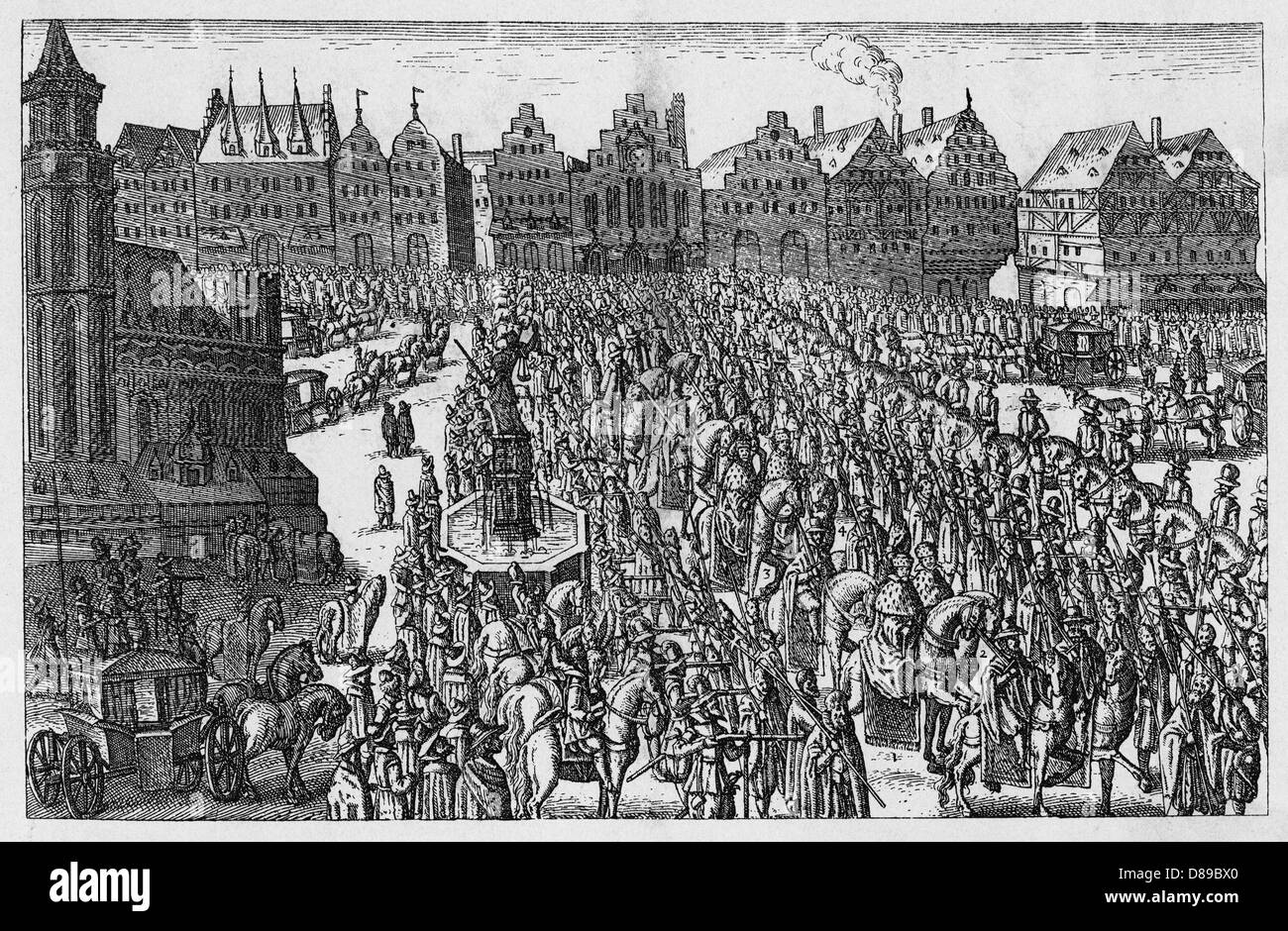 FERDINAND II CROWNED Stock Photohttps://www.alamy.com/image-license-details/?v=1https://www.alamy.com/stock-photo-ferdinand-ii-crowned-56755272.html
FERDINAND II CROWNED Stock Photohttps://www.alamy.com/image-license-details/?v=1https://www.alamy.com/stock-photo-ferdinand-ii-crowned-56755272.htmlRMD89BX0–FERDINAND II CROWNED
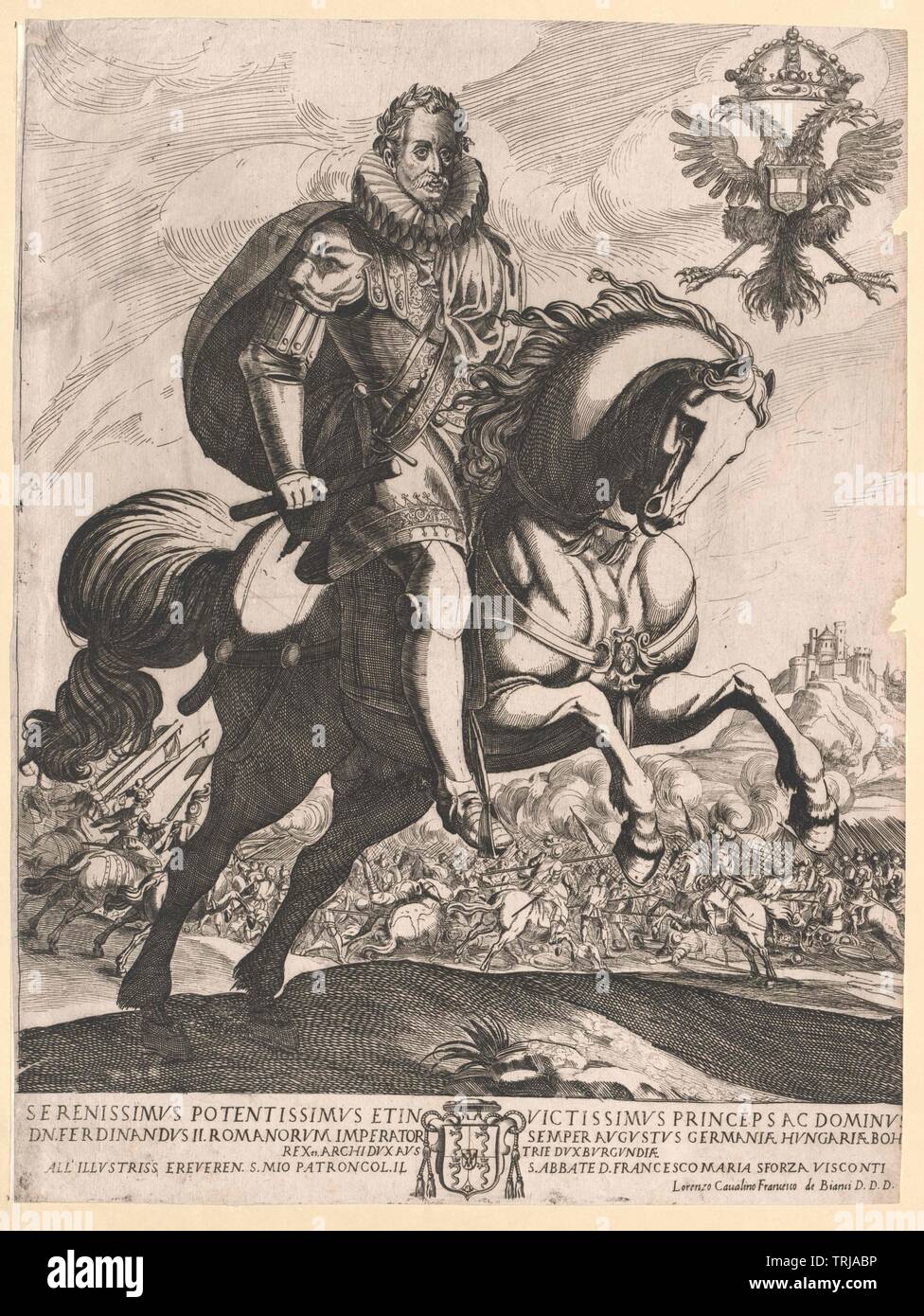 Ferdinand II, Holy Roman Emperor, Additional-Rights-Clearance-Info-Not-Available Stock Photohttps://www.alamy.com/image-license-details/?v=1https://www.alamy.com/ferdinand-ii-holy-roman-emperor-additional-rights-clearance-info-not-available-image255485546.html
Ferdinand II, Holy Roman Emperor, Additional-Rights-Clearance-Info-Not-Available Stock Photohttps://www.alamy.com/image-license-details/?v=1https://www.alamy.com/ferdinand-ii-holy-roman-emperor-additional-rights-clearance-info-not-available-image255485546.htmlRMTRJABP–Ferdinand II, Holy Roman Emperor, Additional-Rights-Clearance-Info-Not-Available
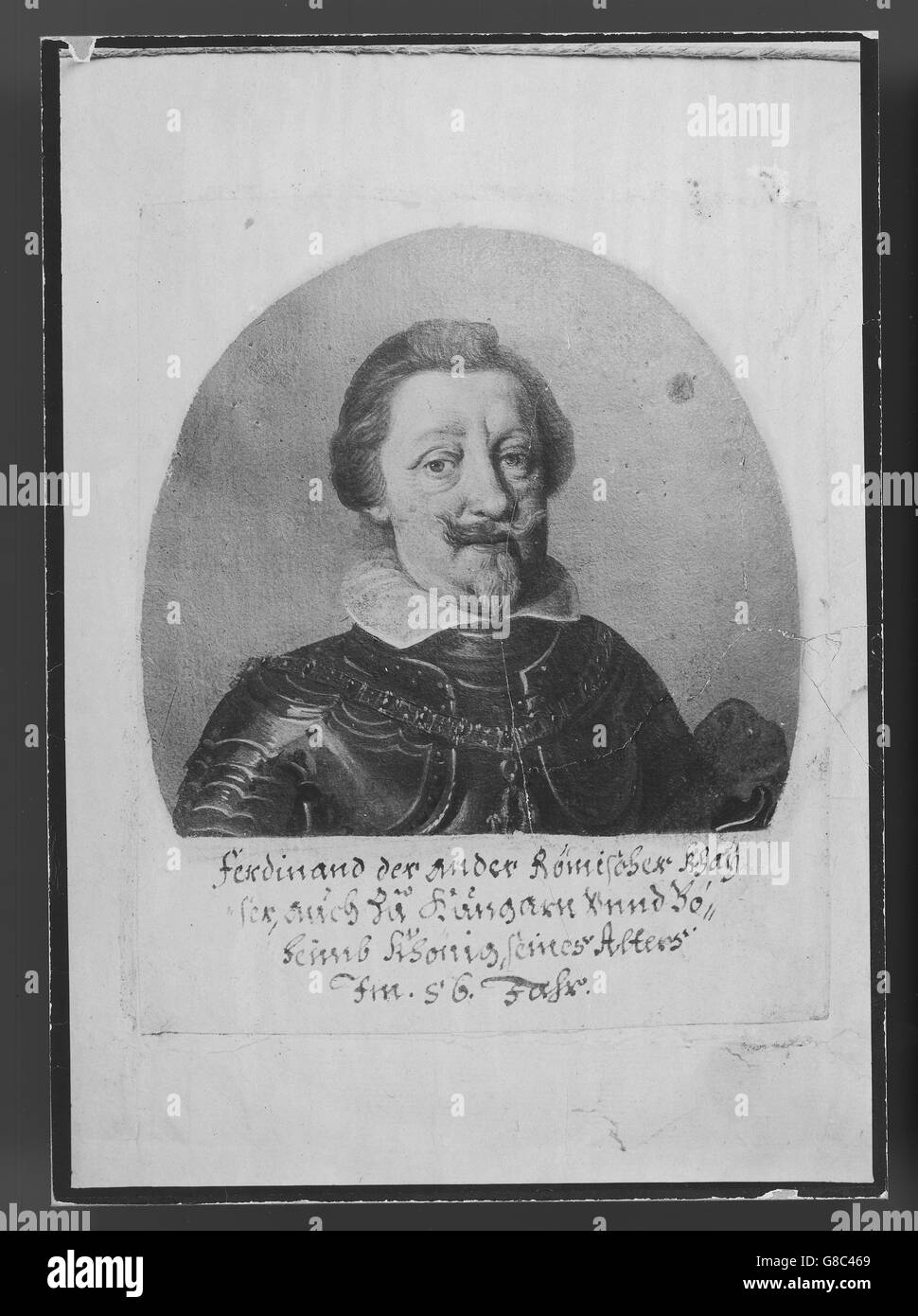 Mattsee Stock Photohttps://www.alamy.com/image-license-details/?v=1https://www.alamy.com/stock-photo-mattsee-108446193.html
Mattsee Stock Photohttps://www.alamy.com/image-license-details/?v=1https://www.alamy.com/stock-photo-mattsee-108446193.htmlRMG8C469–Mattsee
 Frans Francken the Younger (1581-1642). Flemish painter. Allegory of the Abdication of Charles V in Brussels, c.1630-1640. Stock Photohttps://www.alamy.com/image-license-details/?v=1https://www.alamy.com/frans-francken-the-younger-1581-1642-flemish-painter-allegory-of-the-image67002286.html
Frans Francken the Younger (1581-1642). Flemish painter. Allegory of the Abdication of Charles V in Brussels, c.1630-1640. Stock Photohttps://www.alamy.com/image-license-details/?v=1https://www.alamy.com/frans-francken-the-younger-1581-1642-flemish-painter-allegory-of-the-image67002286.htmlRMDW062P–Frans Francken the Younger (1581-1642). Flemish painter. Allegory of the Abdication of Charles V in Brussels, c.1630-1640.
 Ferdinand II, Holy Roman Emperor. Artist: Unknown Stock Photohttps://www.alamy.com/image-license-details/?v=1https://www.alamy.com/ferdinand-ii-holy-roman-emperor-artist-unknown-image262746647.html
Ferdinand II, Holy Roman Emperor. Artist: Unknown Stock Photohttps://www.alamy.com/image-license-details/?v=1https://www.alamy.com/ferdinand-ii-holy-roman-emperor-artist-unknown-image262746647.htmlRMW7D40R–Ferdinand II, Holy Roman Emperor. Artist: Unknown
 Allegory on the Abdication of Holy Roman Emperor Charles V in Brussels, 25th October 1555, painting by Frans Francken II, circa 1630-1640 Stock Photohttps://www.alamy.com/image-license-details/?v=1https://www.alamy.com/allegory-on-the-abdication-of-holy-roman-emperor-charles-v-in-brussels-25th-october-1555-painting-by-frans-francken-ii-circa-1630-1640-image368906293.html
Allegory on the Abdication of Holy Roman Emperor Charles V in Brussels, 25th October 1555, painting by Frans Francken II, circa 1630-1640 Stock Photohttps://www.alamy.com/image-license-details/?v=1https://www.alamy.com/allegory-on-the-abdication-of-holy-roman-emperor-charles-v-in-brussels-25th-october-1555-painting-by-frans-francken-ii-circa-1630-1640-image368906293.htmlRM2CC53MN–Allegory on the Abdication of Holy Roman Emperor Charles V in Brussels, 25th October 1555, painting by Frans Francken II, circa 1630-1640
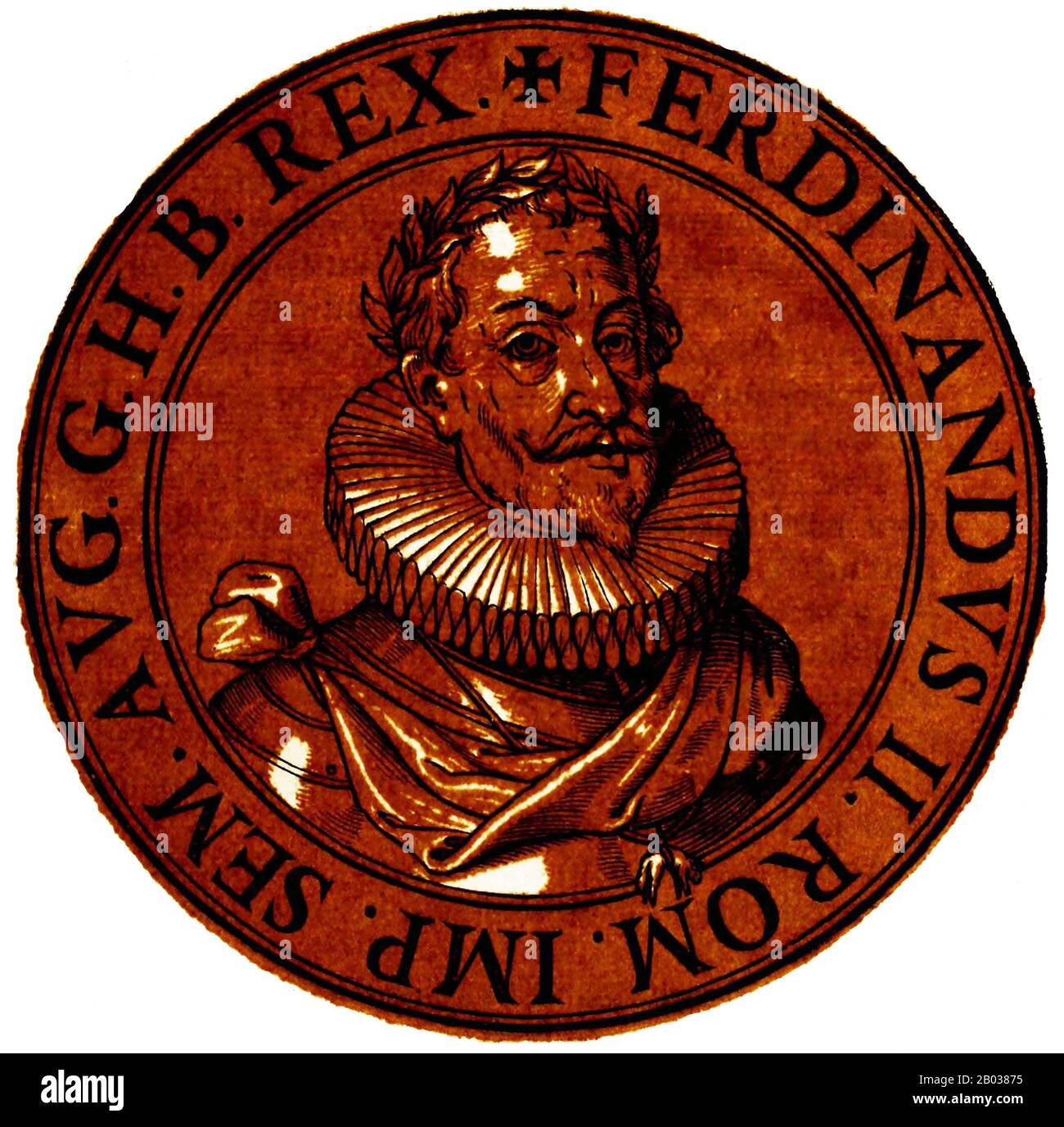 Ferdinand II (1578-1637) was the son of Charles II, Archduke of Austria, and grandson of Emperor Ferdinand I. Ferdinand was part of a Catholic faction opposed to his cousin, Emperor Matthias, who was more tolerant to Protestantism. He became King of Bohemia in 1617, King of Hungary in 1618, and ascended to Holy Roman Emperor in 1619 after his cousin's death. Ferdinand was a zealous Catholic and immediately worked to restore Catholicism as the only religion in the Holy Roman Empire, suppressing Protestantism wherever he could, leading to conflict with his non-Catholic subjects. He discarded t Stock Photohttps://www.alamy.com/image-license-details/?v=1https://www.alamy.com/ferdinand-ii-1578-1637-was-the-son-of-charles-ii-archduke-of-austria-and-grandson-of-emperor-ferdinand-i-ferdinand-was-part-of-a-catholic-faction-opposed-to-his-cousin-emperor-matthias-who-was-more-tolerant-to-protestantism-he-became-king-of-bohemia-in-1617-king-of-hungary-in-1618-and-ascended-to-holy-roman-emperor-in-1619-after-his-cousins-death-ferdinand-was-a-zealous-catholic-and-immediately-worked-to-restore-catholicism-as-the-only-religion-in-the-holy-roman-empire-suppressing-protestantism-wherever-he-could-leading-to-conflict-with-his-non-catholic-subjects-he-discarded-t-image344279689.html
Ferdinand II (1578-1637) was the son of Charles II, Archduke of Austria, and grandson of Emperor Ferdinand I. Ferdinand was part of a Catholic faction opposed to his cousin, Emperor Matthias, who was more tolerant to Protestantism. He became King of Bohemia in 1617, King of Hungary in 1618, and ascended to Holy Roman Emperor in 1619 after his cousin's death. Ferdinand was a zealous Catholic and immediately worked to restore Catholicism as the only religion in the Holy Roman Empire, suppressing Protestantism wherever he could, leading to conflict with his non-Catholic subjects. He discarded t Stock Photohttps://www.alamy.com/image-license-details/?v=1https://www.alamy.com/ferdinand-ii-1578-1637-was-the-son-of-charles-ii-archduke-of-austria-and-grandson-of-emperor-ferdinand-i-ferdinand-was-part-of-a-catholic-faction-opposed-to-his-cousin-emperor-matthias-who-was-more-tolerant-to-protestantism-he-became-king-of-bohemia-in-1617-king-of-hungary-in-1618-and-ascended-to-holy-roman-emperor-in-1619-after-his-cousins-death-ferdinand-was-a-zealous-catholic-and-immediately-worked-to-restore-catholicism-as-the-only-religion-in-the-holy-roman-empire-suppressing-protestantism-wherever-he-could-leading-to-conflict-with-his-non-catholic-subjects-he-discarded-t-image344279689.htmlRM2B03875–Ferdinand II (1578-1637) was the son of Charles II, Archduke of Austria, and grandson of Emperor Ferdinand I. Ferdinand was part of a Catholic faction opposed to his cousin, Emperor Matthias, who was more tolerant to Protestantism. He became King of Bohemia in 1617, King of Hungary in 1618, and ascended to Holy Roman Emperor in 1619 after his cousin's death. Ferdinand was a zealous Catholic and immediately worked to restore Catholicism as the only religion in the Holy Roman Empire, suppressing Protestantism wherever he could, leading to conflict with his non-Catholic subjects. He discarded t
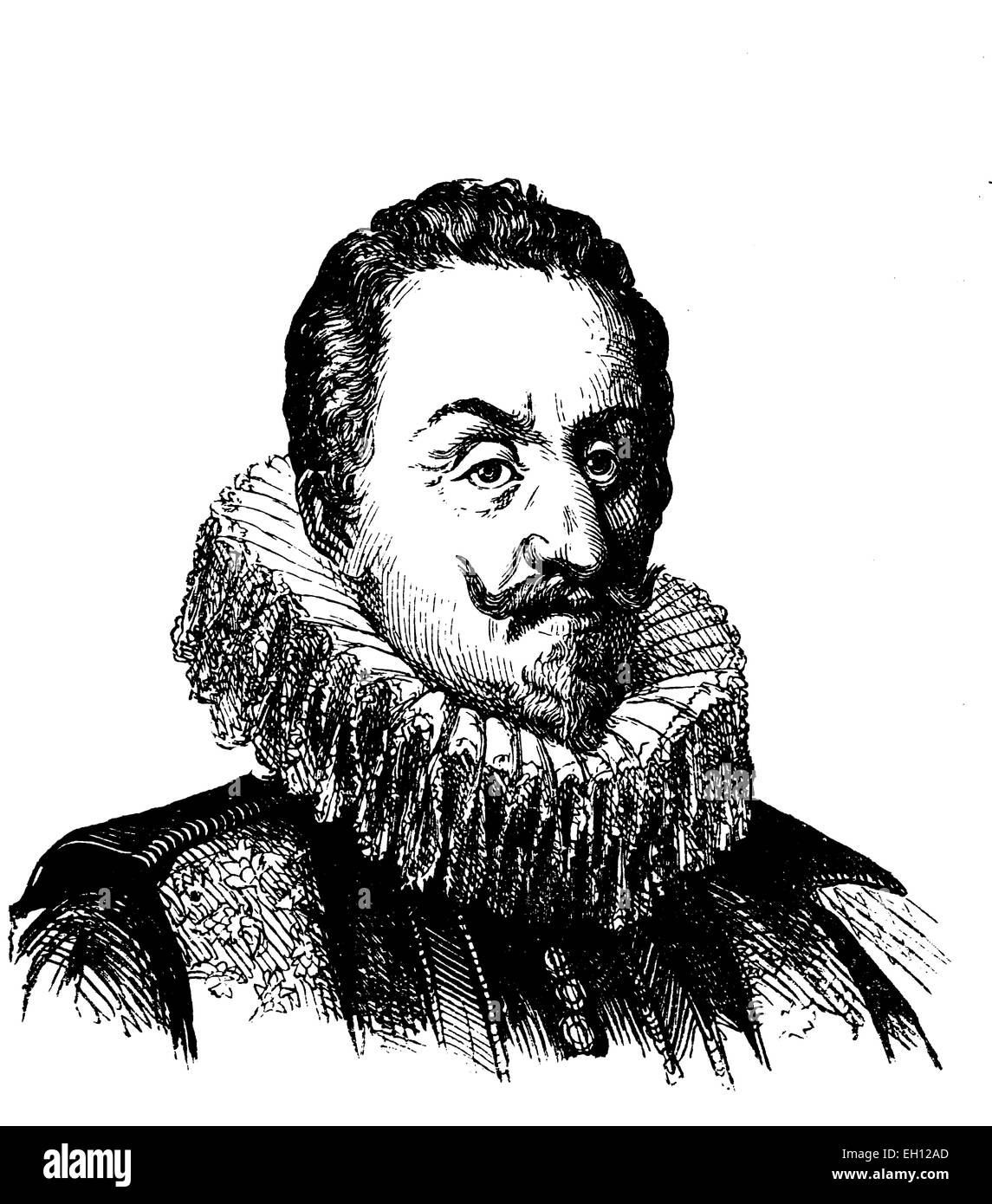 Ferdinand II, 1578 - 1637, King of Bohemia, Hungary, Croatia, Emperor of the Holy Roman Empire, historical woodcut, circa 1880 Stock Photohttps://www.alamy.com/image-license-details/?v=1https://www.alamy.com/stock-photo-ferdinand-ii-1578-1637-king-of-bohemia-hungary-croatia-emperor-of-79314437.html
Ferdinand II, 1578 - 1637, King of Bohemia, Hungary, Croatia, Emperor of the Holy Roman Empire, historical woodcut, circa 1880 Stock Photohttps://www.alamy.com/image-license-details/?v=1https://www.alamy.com/stock-photo-ferdinand-ii-1578-1637-king-of-bohemia-hungary-croatia-emperor-of-79314437.htmlRFEH12AD–Ferdinand II, 1578 - 1637, King of Bohemia, Hungary, Croatia, Emperor of the Holy Roman Empire, historical woodcut, circa 1880
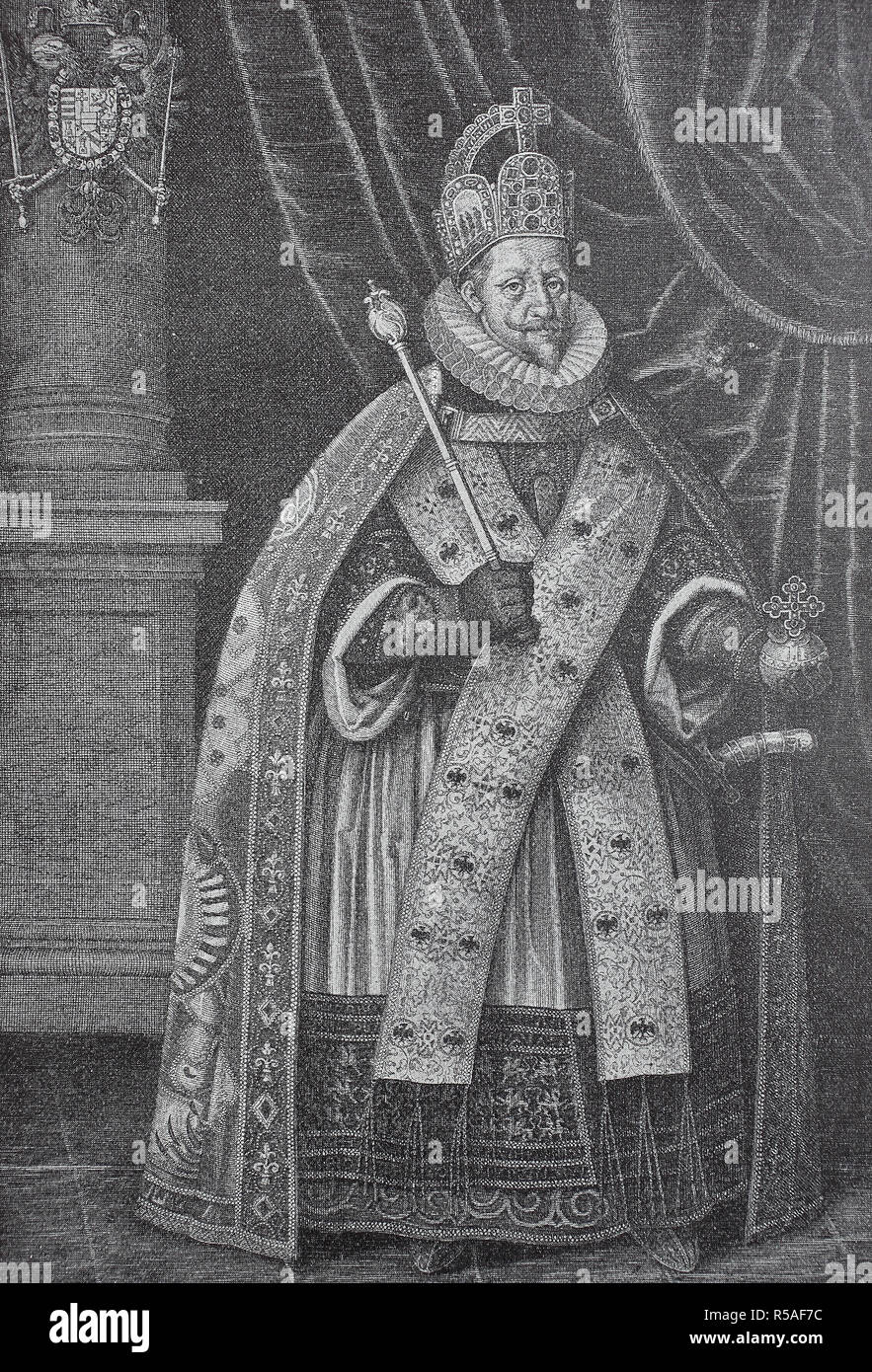 Ferdinand II wears the coronation robe, 9 July 1578, 15 February 1637, Holy Roman Emperor 1619-1637, King of Bohemia and King of Stock Photohttps://www.alamy.com/image-license-details/?v=1https://www.alamy.com/ferdinand-ii-wears-the-coronation-robe-9-july-1578-15-february-1637-holy-roman-emperor-1619-1637-king-of-bohemia-and-king-of-image227039552.html
Ferdinand II wears the coronation robe, 9 July 1578, 15 February 1637, Holy Roman Emperor 1619-1637, King of Bohemia and King of Stock Photohttps://www.alamy.com/image-license-details/?v=1https://www.alamy.com/ferdinand-ii-wears-the-coronation-robe-9-july-1578-15-february-1637-holy-roman-emperor-1619-1637-king-of-bohemia-and-king-of-image227039552.htmlRMR5AF7C–Ferdinand II wears the coronation robe, 9 July 1578, 15 February 1637, Holy Roman Emperor 1619-1637, King of Bohemia and King of
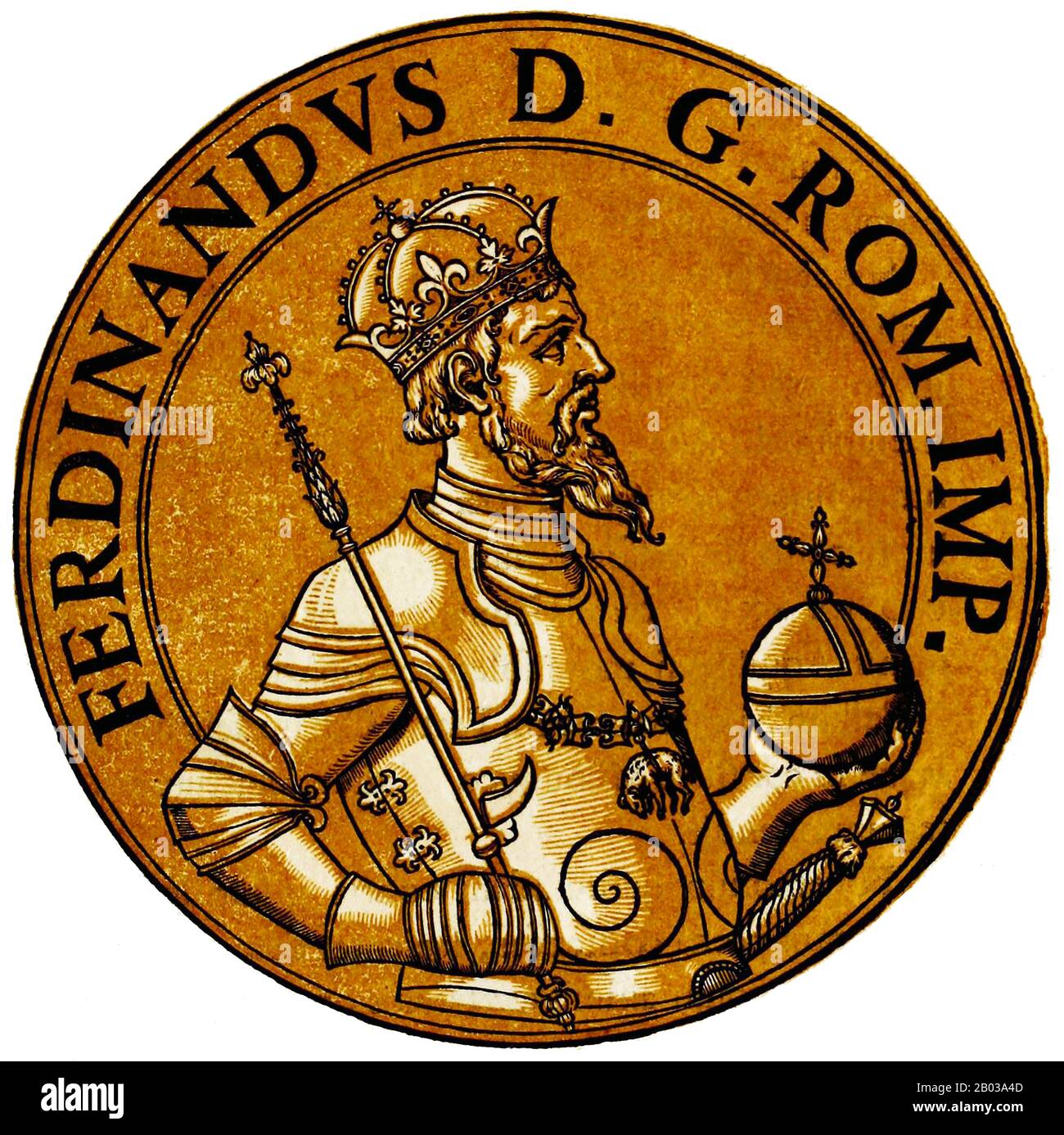 Ferdinand I (1503-1564) was the son of Philip I of Castile and Queen Joanna I of Castile, grandson of Emperor Maximilian I and younger brother of future emperor Charles V. Born and raised in Spain, he was sent to Flanders in 1518. When Charles became Holy Roman emperor in 1519, Ferdinand was entrusted with the governing of their hereditary Austrian lands, becoming Archduke of Austria and adopting the German culture as his own. Ferdinand became King of Bohemia and Hungary in 1526 after the death of his brother-in-law Louis II, and served as his brother Charles' deputy in the Holy Roman Empire Stock Photohttps://www.alamy.com/image-license-details/?v=1https://www.alamy.com/ferdinand-i-1503-1564-was-the-son-of-philip-i-of-castile-and-queen-joanna-i-of-castile-grandson-of-emperor-maximilian-i-and-younger-brother-of-future-emperor-charles-v-born-and-raised-in-spain-he-was-sent-to-flanders-in-1518-when-charles-became-holy-roman-emperor-in-1519-ferdinand-was-entrusted-with-the-governing-of-their-hereditary-austrian-lands-becoming-archduke-of-austria-and-adopting-the-german-culture-as-his-own-ferdinand-became-king-of-bohemia-and-hungary-in-1526-after-the-death-of-his-brother-in-law-louis-ii-and-served-as-his-brother-charles-deputy-in-the-holy-roman-empire-image344281181.html
Ferdinand I (1503-1564) was the son of Philip I of Castile and Queen Joanna I of Castile, grandson of Emperor Maximilian I and younger brother of future emperor Charles V. Born and raised in Spain, he was sent to Flanders in 1518. When Charles became Holy Roman emperor in 1519, Ferdinand was entrusted with the governing of their hereditary Austrian lands, becoming Archduke of Austria and adopting the German culture as his own. Ferdinand became King of Bohemia and Hungary in 1526 after the death of his brother-in-law Louis II, and served as his brother Charles' deputy in the Holy Roman Empire Stock Photohttps://www.alamy.com/image-license-details/?v=1https://www.alamy.com/ferdinand-i-1503-1564-was-the-son-of-philip-i-of-castile-and-queen-joanna-i-of-castile-grandson-of-emperor-maximilian-i-and-younger-brother-of-future-emperor-charles-v-born-and-raised-in-spain-he-was-sent-to-flanders-in-1518-when-charles-became-holy-roman-emperor-in-1519-ferdinand-was-entrusted-with-the-governing-of-their-hereditary-austrian-lands-becoming-archduke-of-austria-and-adopting-the-german-culture-as-his-own-ferdinand-became-king-of-bohemia-and-hungary-in-1526-after-the-death-of-his-brother-in-law-louis-ii-and-served-as-his-brother-charles-deputy-in-the-holy-roman-empire-image344281181.htmlRM2B03A4D–Ferdinand I (1503-1564) was the son of Philip I of Castile and Queen Joanna I of Castile, grandson of Emperor Maximilian I and younger brother of future emperor Charles V. Born and raised in Spain, he was sent to Flanders in 1518. When Charles became Holy Roman emperor in 1519, Ferdinand was entrusted with the governing of their hereditary Austrian lands, becoming Archduke of Austria and adopting the German culture as his own. Ferdinand became King of Bohemia and Hungary in 1526 after the death of his brother-in-law Louis II, and served as his brother Charles' deputy in the Holy Roman Empire
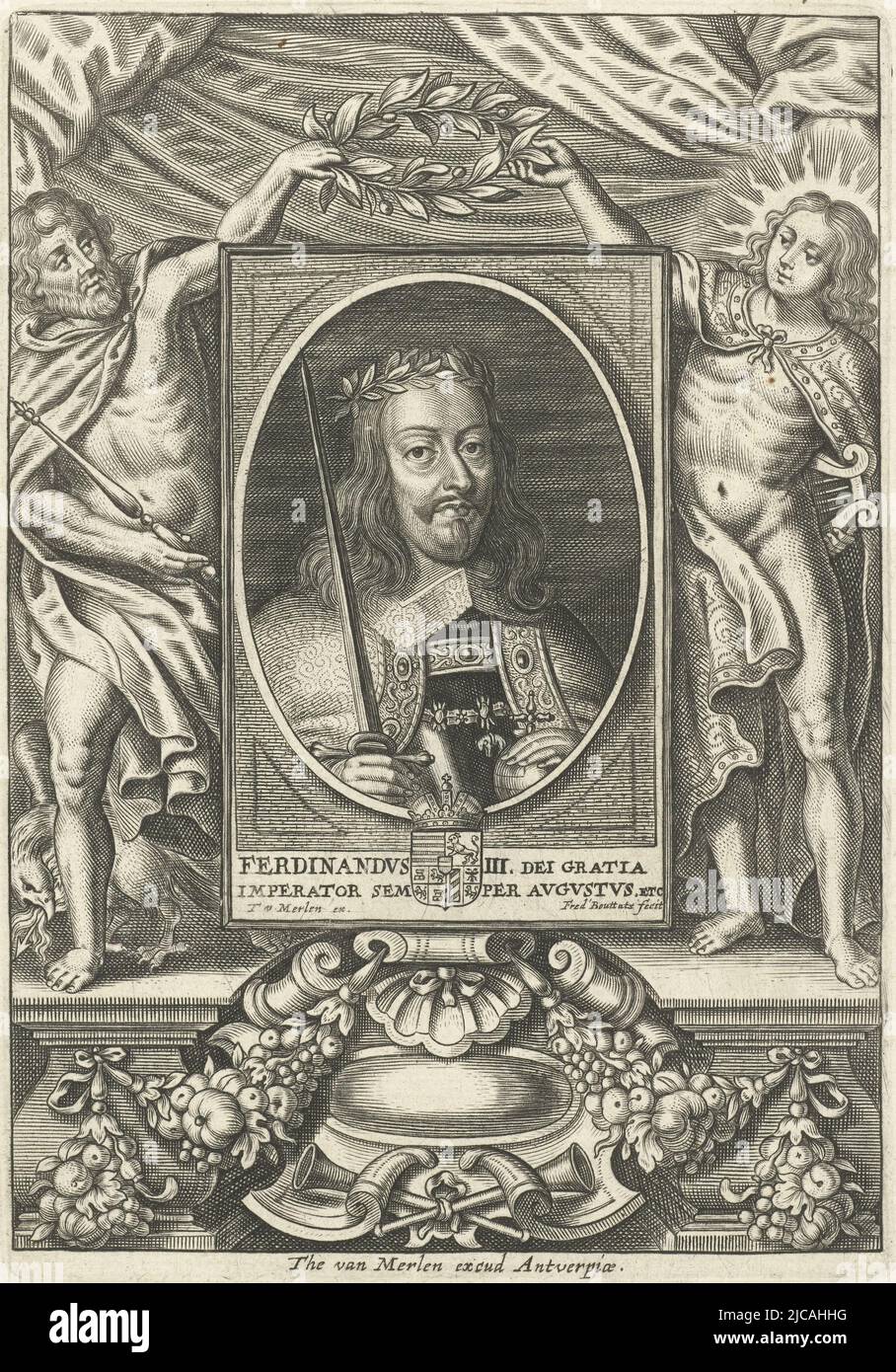 Portrait in an oval frame of Ferdinand III, Archduke of Austria and Emperor of the Holy Roman Empire Bust to right Ferdinand wears the laurel wreath on his head In his hands the Reich's apple and the Reich's sword The portrait is in a rectangular frame between two classical gods, Jupiter and Apollo They hold a laurel wreath above the portrait The print has a Latin caption with the name of the person portrayed, Portrait of Ferdinand III Portraits of Statesmen , print maker: Frederik Bouttats (I), (mentioned on object), publisher: Theodor van Merlen (II), (mentioned on object), Antwerp, 1637 Stock Photohttps://www.alamy.com/image-license-details/?v=1https://www.alamy.com/portrait-in-an-oval-frame-of-ferdinand-iii-archduke-of-austria-and-emperor-of-the-holy-roman-empire-bust-to-right-ferdinand-wears-the-laurel-wreath-on-his-head-in-his-hands-the-reichs-apple-and-the-reichs-sword-the-portrait-is-in-a-rectangular-frame-between-two-classical-gods-jupiter-and-apollo-they-hold-a-laurel-wreath-above-the-portrait-the-print-has-a-latin-caption-with-the-name-of-the-person-portrayed-portrait-of-ferdinand-iii-portraits-of-statesmen-print-maker-frederik-bouttats-i-mentioned-on-object-publisher-theodor-van-merlen-ii-mentioned-on-object-antwerp-1637-image472289148.html
Portrait in an oval frame of Ferdinand III, Archduke of Austria and Emperor of the Holy Roman Empire Bust to right Ferdinand wears the laurel wreath on his head In his hands the Reich's apple and the Reich's sword The portrait is in a rectangular frame between two classical gods, Jupiter and Apollo They hold a laurel wreath above the portrait The print has a Latin caption with the name of the person portrayed, Portrait of Ferdinand III Portraits of Statesmen , print maker: Frederik Bouttats (I), (mentioned on object), publisher: Theodor van Merlen (II), (mentioned on object), Antwerp, 1637 Stock Photohttps://www.alamy.com/image-license-details/?v=1https://www.alamy.com/portrait-in-an-oval-frame-of-ferdinand-iii-archduke-of-austria-and-emperor-of-the-holy-roman-empire-bust-to-right-ferdinand-wears-the-laurel-wreath-on-his-head-in-his-hands-the-reichs-apple-and-the-reichs-sword-the-portrait-is-in-a-rectangular-frame-between-two-classical-gods-jupiter-and-apollo-they-hold-a-laurel-wreath-above-the-portrait-the-print-has-a-latin-caption-with-the-name-of-the-person-portrayed-portrait-of-ferdinand-iii-portraits-of-statesmen-print-maker-frederik-bouttats-i-mentioned-on-object-publisher-theodor-van-merlen-ii-mentioned-on-object-antwerp-1637-image472289148.htmlRM2JCAHHG–Portrait in an oval frame of Ferdinand III, Archduke of Austria and Emperor of the Holy Roman Empire Bust to right Ferdinand wears the laurel wreath on his head In his hands the Reich's apple and the Reich's sword The portrait is in a rectangular frame between two classical gods, Jupiter and Apollo They hold a laurel wreath above the portrait The print has a Latin caption with the name of the person portrayed, Portrait of Ferdinand III Portraits of Statesmen , print maker: Frederik Bouttats (I), (mentioned on object), publisher: Theodor van Merlen (II), (mentioned on object), Antwerp, 1637
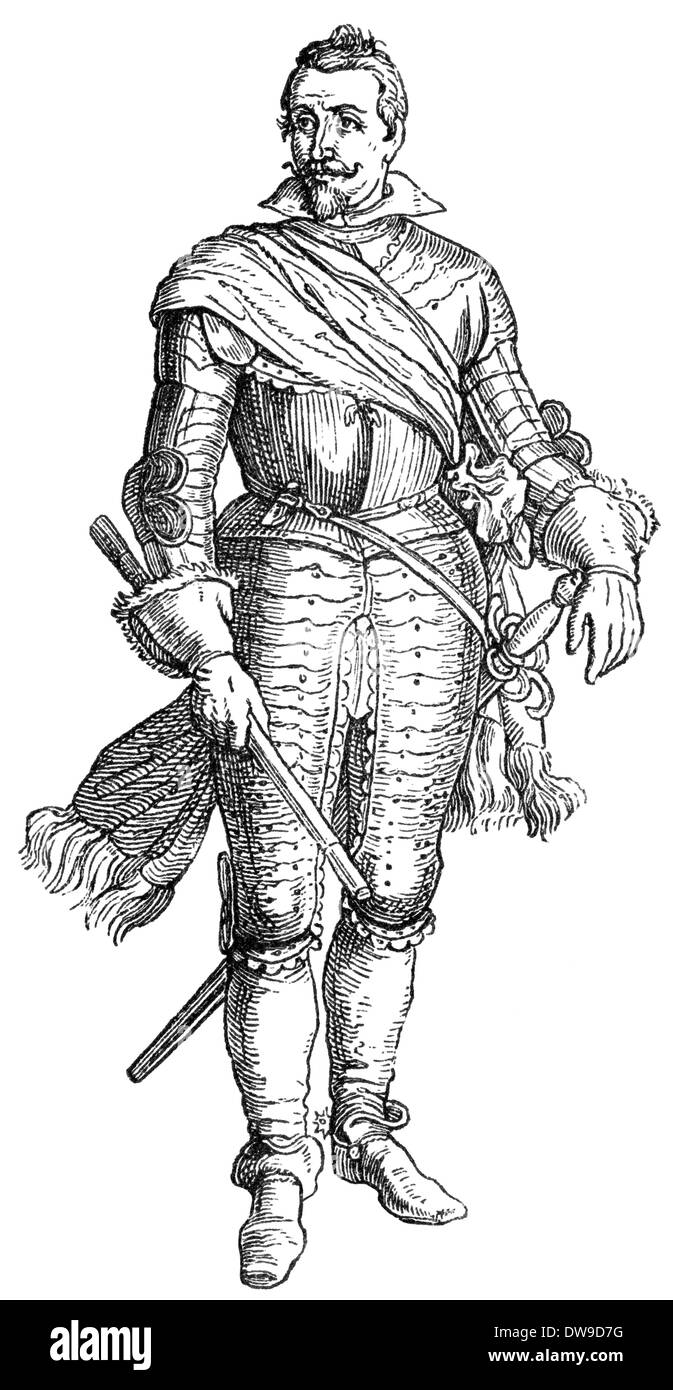 Ferdinand II Stock Photohttps://www.alamy.com/image-license-details/?v=1https://www.alamy.com/ferdinand-ii-image67205476.html
Ferdinand II Stock Photohttps://www.alamy.com/image-license-details/?v=1https://www.alamy.com/ferdinand-ii-image67205476.htmlRMDW9D7G–Ferdinand II
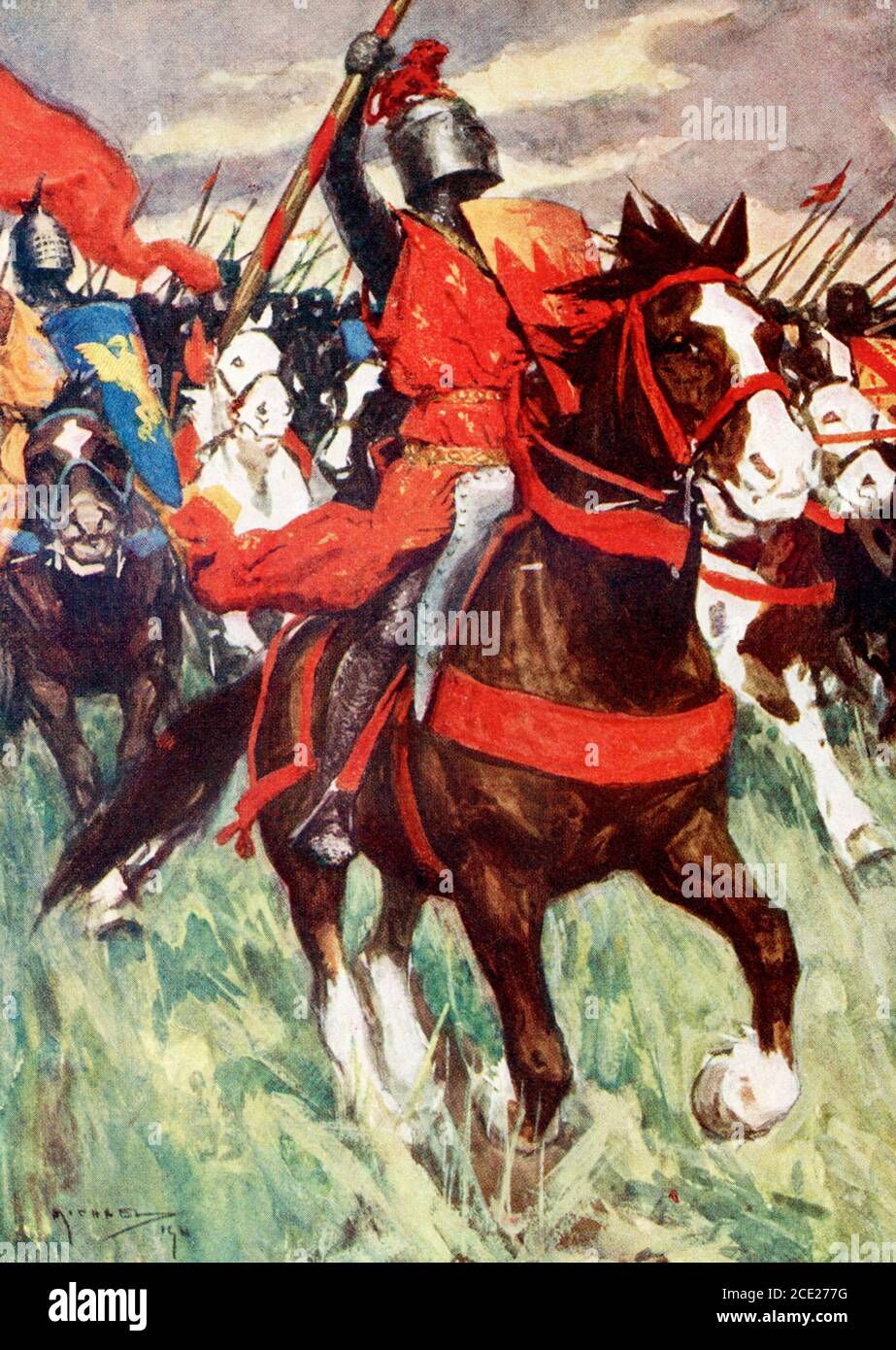 The caption reads: Philip darted forward amid blare of trumpets Philip Augustus and Louis VIII at Battle of Bouvines. The Battle of Bouvines (July 27, 1214) gave a decisive victory to the French king Philip II Augustus over an international coalition of the Holy Roman emperor Otto IV, King John of England, and the French vassals-Ferdinand (Ferrand) of Portugal, count of Flanders, and Renaud (Raynald) of Dammartin, count of Boulogne. The victory enhanced the power and the prestige of the French monarchy in France and in the rest of Europe Stock Photohttps://www.alamy.com/image-license-details/?v=1https://www.alamy.com/the-caption-reads-philip-darted-forward-amid-blare-of-trumpets-philip-augustus-and-louis-viii-at-battle-of-bouvines-the-battle-of-bouvines-july-27-1214-gave-a-decisive-victory-to-the-french-kingphilip-iiaugustus-over-an-international-coalition-of-the-holy-roman-emperorotto-iv-kingjohnofengland-and-the-french-vassals-ferdinand-ferrand-of-portugal-count-offlanders-andrenaudraynald-of-dammartin-count-ofboulogne-the-victoryenhancedthe-power-and-theprestigeof-the-french-monarchy-infranceand-in-the-rest-of-europe-image370072516.html
The caption reads: Philip darted forward amid blare of trumpets Philip Augustus and Louis VIII at Battle of Bouvines. The Battle of Bouvines (July 27, 1214) gave a decisive victory to the French king Philip II Augustus over an international coalition of the Holy Roman emperor Otto IV, King John of England, and the French vassals-Ferdinand (Ferrand) of Portugal, count of Flanders, and Renaud (Raynald) of Dammartin, count of Boulogne. The victory enhanced the power and the prestige of the French monarchy in France and in the rest of Europe Stock Photohttps://www.alamy.com/image-license-details/?v=1https://www.alamy.com/the-caption-reads-philip-darted-forward-amid-blare-of-trumpets-philip-augustus-and-louis-viii-at-battle-of-bouvines-the-battle-of-bouvines-july-27-1214-gave-a-decisive-victory-to-the-french-kingphilip-iiaugustus-over-an-international-coalition-of-the-holy-roman-emperorotto-iv-kingjohnofengland-and-the-french-vassals-ferdinand-ferrand-of-portugal-count-offlanders-andrenaudraynald-of-dammartin-count-ofboulogne-the-victoryenhancedthe-power-and-theprestigeof-the-french-monarchy-infranceand-in-the-rest-of-europe-image370072516.htmlRF2CE277G–The caption reads: Philip darted forward amid blare of trumpets Philip Augustus and Louis VIII at Battle of Bouvines. The Battle of Bouvines (July 27, 1214) gave a decisive victory to the French king Philip II Augustus over an international coalition of the Holy Roman emperor Otto IV, King John of England, and the French vassals-Ferdinand (Ferrand) of Portugal, count of Flanders, and Renaud (Raynald) of Dammartin, count of Boulogne. The victory enhanced the power and the prestige of the French monarchy in France and in the rest of Europe
 Massacre at the Sack of Magdeburg, 20 May 1631 Stock Photohttps://www.alamy.com/image-license-details/?v=1https://www.alamy.com/stock-photo-massacre-at-the-sack-of-magdeburg-20-may-1631-176605185.html
Massacre at the Sack of Magdeburg, 20 May 1631 Stock Photohttps://www.alamy.com/image-license-details/?v=1https://www.alamy.com/stock-photo-massacre-at-the-sack-of-magdeburg-20-may-1631-176605185.htmlRMM791M1–Massacre at the Sack of Magdeburg, 20 May 1631
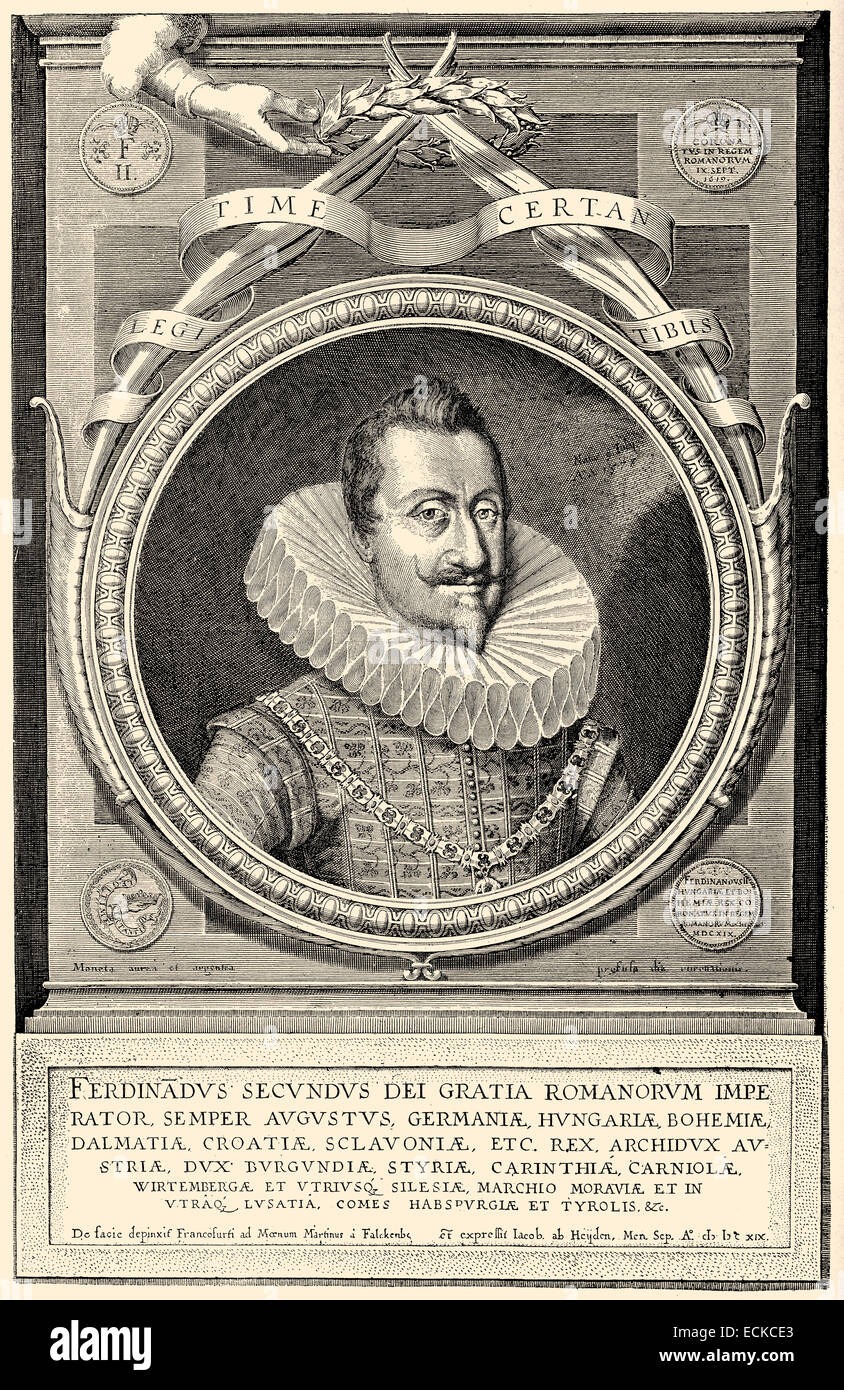 Ferdinand II, 1578 - 1637, Holy Roman Emperor, King of Bohemia and Hungary, House of Habsburg, Ferdinand II. , 1578 - 1637, Kais Stock Photohttps://www.alamy.com/image-license-details/?v=1https://www.alamy.com/stock-photo-ferdinand-ii-1578-1637-holy-roman-emperor-king-of-bohemia-and-hungary-76644235.html
Ferdinand II, 1578 - 1637, Holy Roman Emperor, King of Bohemia and Hungary, House of Habsburg, Ferdinand II. , 1578 - 1637, Kais Stock Photohttps://www.alamy.com/image-license-details/?v=1https://www.alamy.com/stock-photo-ferdinand-ii-1578-1637-holy-roman-emperor-king-of-bohemia-and-hungary-76644235.htmlRMECKCE3–Ferdinand II, 1578 - 1637, Holy Roman Emperor, King of Bohemia and Hungary, House of Habsburg, Ferdinand II. , 1578 - 1637, Kais
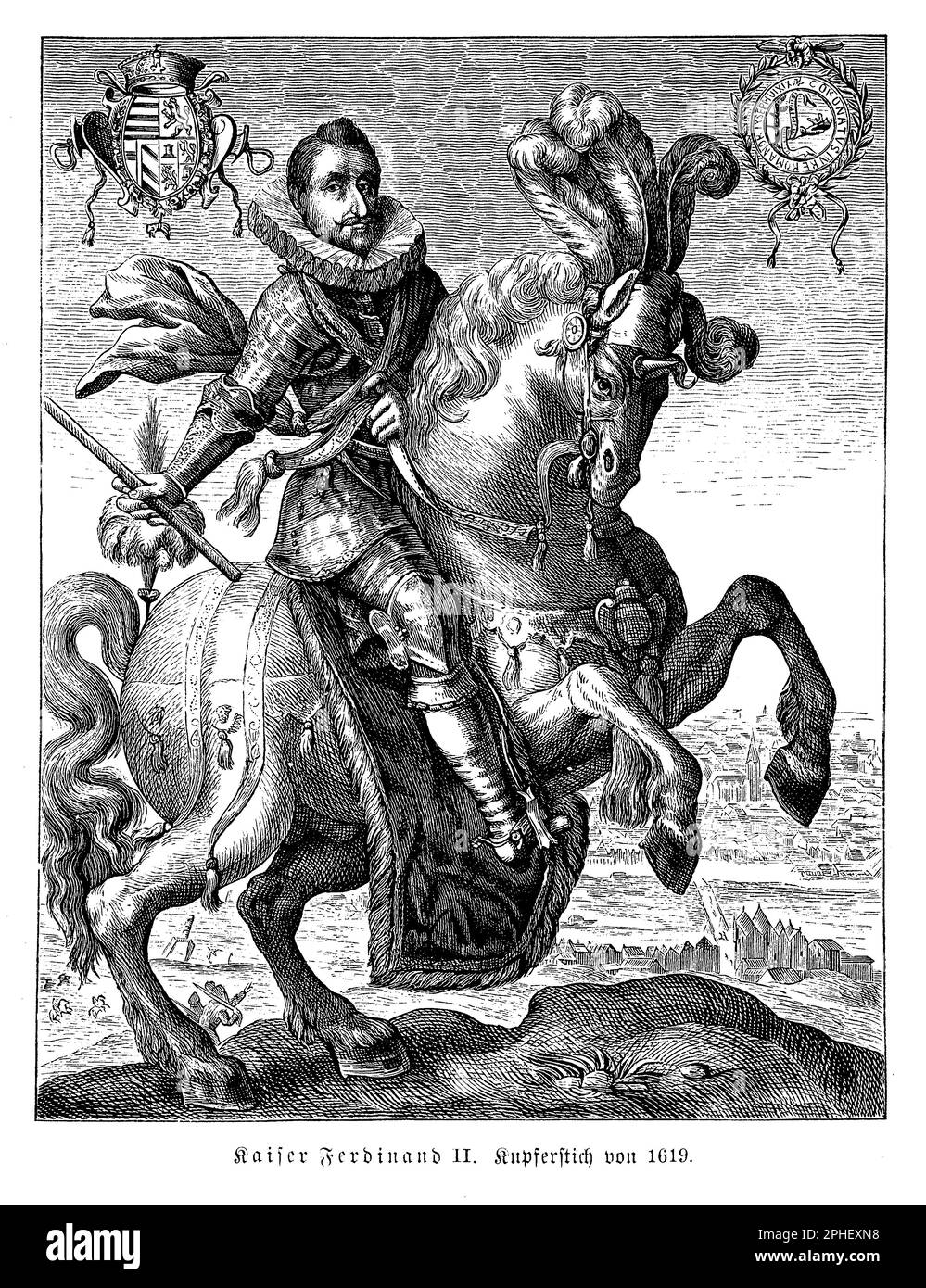 Ferdinand II (1578-1637) was Holy Roman Emperor from 1619 until his death. He was a member of the House of Habsburg and a staunch defender of Catholicism in the face of Protestant opposition. His reign was marked by the Thirty Years' War, a devastating conflict that began with the Bohemian Revolt and spread throughout Europe. Ferdinand was a patron of the arts and sciences, particularly music and architecture, and his reign saw significant achievements in these fields Stock Photohttps://www.alamy.com/image-license-details/?v=1https://www.alamy.com/ferdinand-ii-1578-1637-was-holy-roman-emperor-from-1619-until-his-death-he-was-a-member-of-the-house-of-habsburg-and-a-staunch-defender-of-catholicism-in-the-face-of-protestant-opposition-his-reign-was-marked-by-the-thirty-years-war-a-devastating-conflict-that-began-with-the-bohemian-revolt-and-spread-throughout-europe-ferdinand-was-a-patron-of-the-arts-and-sciences-particularly-music-and-architecture-and-his-reign-saw-significant-achievements-in-these-fields-image544298868.html
Ferdinand II (1578-1637) was Holy Roman Emperor from 1619 until his death. He was a member of the House of Habsburg and a staunch defender of Catholicism in the face of Protestant opposition. His reign was marked by the Thirty Years' War, a devastating conflict that began with the Bohemian Revolt and spread throughout Europe. Ferdinand was a patron of the arts and sciences, particularly music and architecture, and his reign saw significant achievements in these fields Stock Photohttps://www.alamy.com/image-license-details/?v=1https://www.alamy.com/ferdinand-ii-1578-1637-was-holy-roman-emperor-from-1619-until-his-death-he-was-a-member-of-the-house-of-habsburg-and-a-staunch-defender-of-catholicism-in-the-face-of-protestant-opposition-his-reign-was-marked-by-the-thirty-years-war-a-devastating-conflict-that-began-with-the-bohemian-revolt-and-spread-throughout-europe-ferdinand-was-a-patron-of-the-arts-and-sciences-particularly-music-and-architecture-and-his-reign-saw-significant-achievements-in-these-fields-image544298868.htmlRM2PHEXN8–Ferdinand II (1578-1637) was Holy Roman Emperor from 1619 until his death. He was a member of the House of Habsburg and a staunch defender of Catholicism in the face of Protestant opposition. His reign was marked by the Thirty Years' War, a devastating conflict that began with the Bohemian Revolt and spread throughout Europe. Ferdinand was a patron of the arts and sciences, particularly music and architecture, and his reign saw significant achievements in these fields
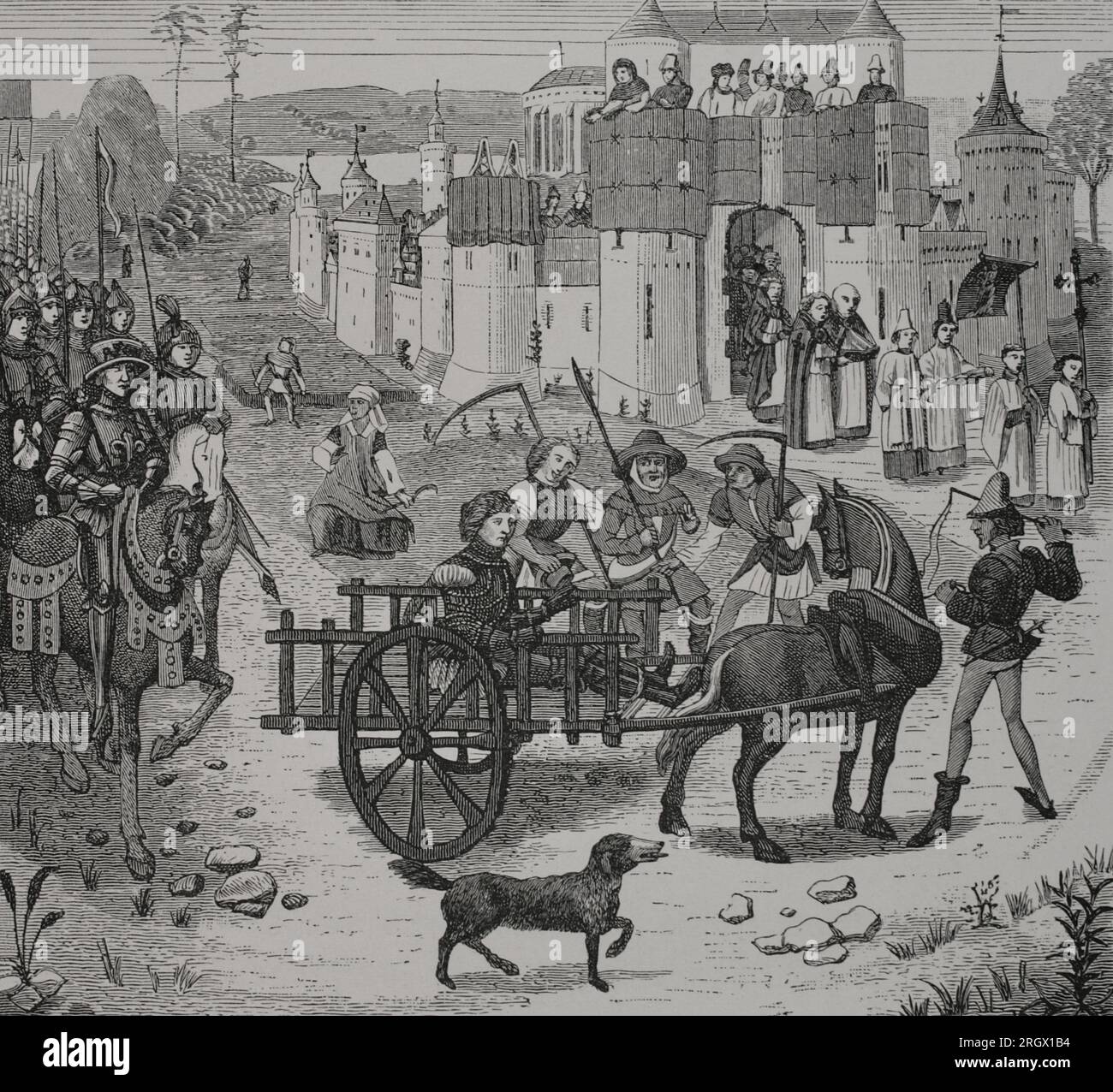 The Infante Ferdinand of Portugal (1188-1233), Count of Flanders (1215-1233), was taken prisoner at the Battle of Bouvines on 27 July 1214. The battle fought between an international coalition formed by troops of the Count of Flanders, Raynald of Dammartin (Count of Boulogne), King John of England and the Holy Roman Emperor Otto IV, against the army of King Philip II Augustus of France. The French army defeated the coalition. Ferdinand of Portugal was captured and taken chained to Paris to be imprisoned in the dungeons of the Louvre, from where he was not released until 6 January 1227. Engravi Stock Photohttps://www.alamy.com/image-license-details/?v=1https://www.alamy.com/the-infante-ferdinand-of-portugal-1188-1233-count-of-flanders-1215-1233-was-taken-prisoner-at-the-battle-of-bouvines-on-27-july-1214-the-battle-fought-between-an-international-coalition-formed-by-troops-of-the-count-of-flanders-raynald-of-dammartin-count-of-boulogne-king-john-of-england-and-the-holy-roman-emperor-otto-iv-against-the-army-of-king-philip-ii-augustus-of-france-the-french-army-defeated-the-coalition-ferdinand-of-portugal-was-captured-and-taken-chained-to-paris-to-be-imprisoned-in-the-dungeons-of-the-louvre-from-where-he-was-not-released-until-6-january-1227-engravi-image561138120.html
The Infante Ferdinand of Portugal (1188-1233), Count of Flanders (1215-1233), was taken prisoner at the Battle of Bouvines on 27 July 1214. The battle fought between an international coalition formed by troops of the Count of Flanders, Raynald of Dammartin (Count of Boulogne), King John of England and the Holy Roman Emperor Otto IV, against the army of King Philip II Augustus of France. The French army defeated the coalition. Ferdinand of Portugal was captured and taken chained to Paris to be imprisoned in the dungeons of the Louvre, from where he was not released until 6 January 1227. Engravi Stock Photohttps://www.alamy.com/image-license-details/?v=1https://www.alamy.com/the-infante-ferdinand-of-portugal-1188-1233-count-of-flanders-1215-1233-was-taken-prisoner-at-the-battle-of-bouvines-on-27-july-1214-the-battle-fought-between-an-international-coalition-formed-by-troops-of-the-count-of-flanders-raynald-of-dammartin-count-of-boulogne-king-john-of-england-and-the-holy-roman-emperor-otto-iv-against-the-army-of-king-philip-ii-augustus-of-france-the-french-army-defeated-the-coalition-ferdinand-of-portugal-was-captured-and-taken-chained-to-paris-to-be-imprisoned-in-the-dungeons-of-the-louvre-from-where-he-was-not-released-until-6-january-1227-engravi-image561138120.htmlRM2RGX1B4–The Infante Ferdinand of Portugal (1188-1233), Count of Flanders (1215-1233), was taken prisoner at the Battle of Bouvines on 27 July 1214. The battle fought between an international coalition formed by troops of the Count of Flanders, Raynald of Dammartin (Count of Boulogne), King John of England and the Holy Roman Emperor Otto IV, against the army of King Philip II Augustus of France. The French army defeated the coalition. Ferdinand of Portugal was captured and taken chained to Paris to be imprisoned in the dungeons of the Louvre, from where he was not released until 6 January 1227. Engravi
 Holy Roman Emperor with costume items Stock Photohttps://www.alamy.com/image-license-details/?v=1https://www.alamy.com/stock-photo-holy-roman-emperor-with-costume-items-105398536.html
Holy Roman Emperor with costume items Stock Photohttps://www.alamy.com/image-license-details/?v=1https://www.alamy.com/stock-photo-holy-roman-emperor-with-costume-items-105398536.htmlRMG3D8WC–Holy Roman Emperor with costume items
 Ferdinand I (19 April 1793 – 29 June 1875) was Emperor of Austria, President of the German Confederation, King of Hungary and Bohemia (as Ferdinand V), as well as associated dominions from the death of his father, Francis II, Holy Roman Emperor, until his abdication after the Revolutions of 1848. Stock Photohttps://www.alamy.com/image-license-details/?v=1https://www.alamy.com/stock-photo-ferdinand-i-19-april-1793-29-june-1875-was-emperor-of-austria-president-57352904.html
Ferdinand I (19 April 1793 – 29 June 1875) was Emperor of Austria, President of the German Confederation, King of Hungary and Bohemia (as Ferdinand V), as well as associated dominions from the death of his father, Francis II, Holy Roman Emperor, until his abdication after the Revolutions of 1848. Stock Photohttps://www.alamy.com/image-license-details/?v=1https://www.alamy.com/stock-photo-ferdinand-i-19-april-1793-29-june-1875-was-emperor-of-austria-president-57352904.htmlRMD98J60–Ferdinand I (19 April 1793 – 29 June 1875) was Emperor of Austria, President of the German Confederation, King of Hungary and Bohemia (as Ferdinand V), as well as associated dominions from the death of his father, Francis II, Holy Roman Emperor, until his abdication after the Revolutions of 1848.
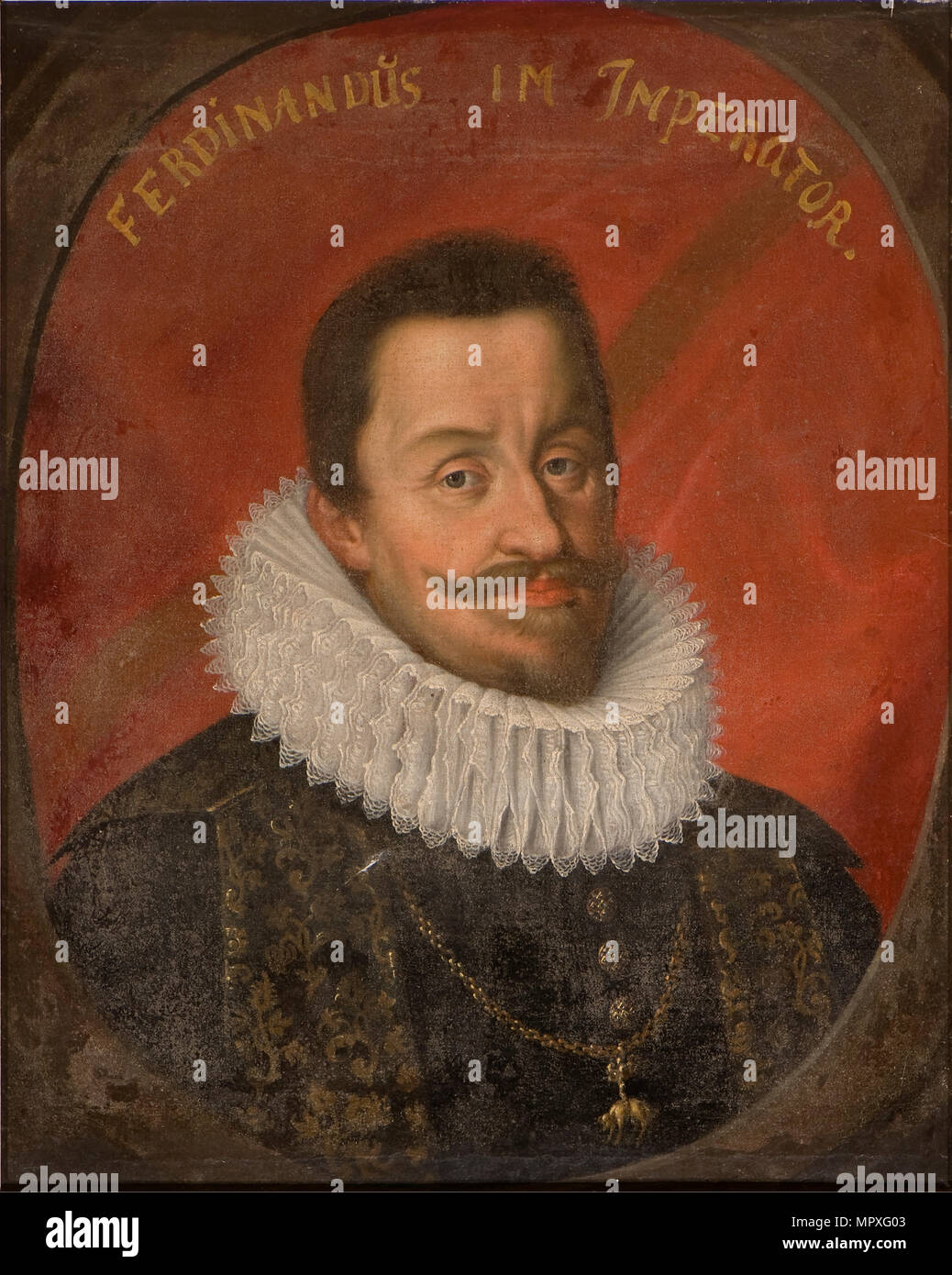 Portrait of Ferdinand II (1578-1637), Holy Roman Emperor. Stock Photohttps://www.alamy.com/image-license-details/?v=1https://www.alamy.com/portrait-of-ferdinand-ii-1578-1637-holy-roman-emperor-image186209411.html
Portrait of Ferdinand II (1578-1637), Holy Roman Emperor. Stock Photohttps://www.alamy.com/image-license-details/?v=1https://www.alamy.com/portrait-of-ferdinand-ii-1578-1637-holy-roman-emperor-image186209411.htmlRMMPXG03–Portrait of Ferdinand II (1578-1637), Holy Roman Emperor.
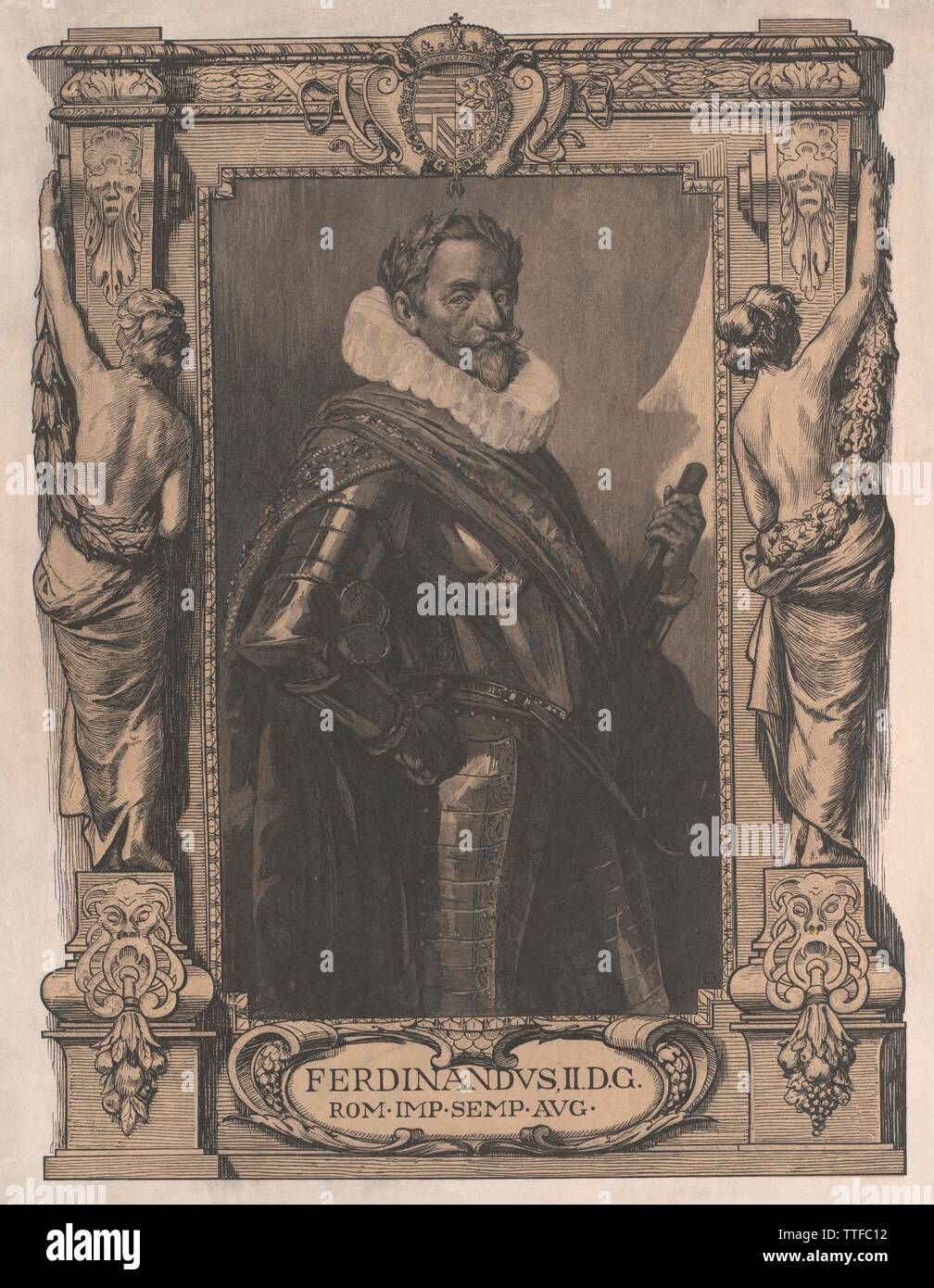 Ferdinand II, Holy Roman Emperor, Additional-Rights-Clearance-Info-Not-Available Stock Photohttps://www.alamy.com/image-license-details/?v=1https://www.alamy.com/ferdinand-ii-holy-roman-emperor-additional-rights-clearance-info-not-available-image256035614.html
Ferdinand II, Holy Roman Emperor, Additional-Rights-Clearance-Info-Not-Available Stock Photohttps://www.alamy.com/image-license-details/?v=1https://www.alamy.com/ferdinand-ii-holy-roman-emperor-additional-rights-clearance-info-not-available-image256035614.htmlRMTTFC12–Ferdinand II, Holy Roman Emperor, Additional-Rights-Clearance-Info-Not-Available
 Portrait of Ferdinand II (1578-1637), Holy Roman Emperor, 1630. Stock Photohttps://www.alamy.com/image-license-details/?v=1https://www.alamy.com/portrait-of-ferdinand-ii-1578-1637-holy-roman-emperor-1630-image228940472.html
Portrait of Ferdinand II (1578-1637), Holy Roman Emperor, 1630. Stock Photohttps://www.alamy.com/image-license-details/?v=1https://www.alamy.com/portrait-of-ferdinand-ii-1578-1637-holy-roman-emperor-1630-image228940472.htmlRMR8D3WC–Portrait of Ferdinand II (1578-1637), Holy Roman Emperor, 1630.
 events, Thirty Years War 1618 - 1648, Swedish Intervention 1630 - 1635, arrival of Gustavus Adolphus and the Swedish in Germany, allegory, protestant flysheet, 1631, Sweden, Holy Roman Empire, Emperor Ferdinand II, Pope Urban VIII, Johann Tsaerclaes count Tilly, catholics, church in chains, Vasa, propaganda, religious wars, soldiers, 17th century, historic, historical, people, Stock Photohttps://www.alamy.com/image-license-details/?v=1https://www.alamy.com/stock-photo-events-thirty-years-war-1618-1648-swedish-intervention-1630-1635-arrival-28127556.html
events, Thirty Years War 1618 - 1648, Swedish Intervention 1630 - 1635, arrival of Gustavus Adolphus and the Swedish in Germany, allegory, protestant flysheet, 1631, Sweden, Holy Roman Empire, Emperor Ferdinand II, Pope Urban VIII, Johann Tsaerclaes count Tilly, catholics, church in chains, Vasa, propaganda, religious wars, soldiers, 17th century, historic, historical, people, Stock Photohttps://www.alamy.com/image-license-details/?v=1https://www.alamy.com/stock-photo-events-thirty-years-war-1618-1648-swedish-intervention-1630-1635-arrival-28127556.htmlRMBHN8YG–events, Thirty Years War 1618 - 1648, Swedish Intervention 1630 - 1635, arrival of Gustavus Adolphus and the Swedish in Germany, allegory, protestant flysheet, 1631, Sweden, Holy Roman Empire, Emperor Ferdinand II, Pope Urban VIII, Johann Tsaerclaes count Tilly, catholics, church in chains, Vasa, propaganda, religious wars, soldiers, 17th century, historic, historical, people,
 Commode (commode à vantaux) (part of a set). Culture: French, Paris. Dimensions: H. 38-3/8 in. (97.5 cm); W. 58-5/8 in. (148.9 cm); D. 22-1/4 in.(56.5 cm). Maker: Adam Weisweiler (French, 1744-1820). Date: ca. 1790. On October 7, 1790, many European royals and aristocrats were gathered in Frankfurt to attend the coronation of Leopold II as Holy Roman Emperor. Ferdinand IV (1751-1825), king of Naples, was among those present for this solemn event. Married to the new emperor's sister, Maria Carolina, Ferdinand was the brother-rin-law of both Leopold and Marie-Antoinette. At this time of social Stock Photohttps://www.alamy.com/image-license-details/?v=1https://www.alamy.com/commode-commode-vantaux-part-of-a-set-culture-french-paris-dimensions-h-38-38-in-975-cm-w-58-58-in-1489-cm-d-22-14-in565-cm-maker-adam-weisweiler-french-1744-1820-date-ca-1790-on-october-7-1790-many-european-royals-and-aristocrats-were-gathered-in-frankfurt-to-attend-the-coronation-of-leopold-ii-as-holy-roman-emperor-ferdinand-iv-1751-1825-king-of-naples-was-among-those-present-for-this-solemn-event-married-to-the-new-emperors-sister-maria-carolina-ferdinand-was-the-brother-rin-law-of-both-leopold-and-marie-antoinette-at-this-time-of-social-image212862991.html
Commode (commode à vantaux) (part of a set). Culture: French, Paris. Dimensions: H. 38-3/8 in. (97.5 cm); W. 58-5/8 in. (148.9 cm); D. 22-1/4 in.(56.5 cm). Maker: Adam Weisweiler (French, 1744-1820). Date: ca. 1790. On October 7, 1790, many European royals and aristocrats were gathered in Frankfurt to attend the coronation of Leopold II as Holy Roman Emperor. Ferdinand IV (1751-1825), king of Naples, was among those present for this solemn event. Married to the new emperor's sister, Maria Carolina, Ferdinand was the brother-rin-law of both Leopold and Marie-Antoinette. At this time of social Stock Photohttps://www.alamy.com/image-license-details/?v=1https://www.alamy.com/commode-commode-vantaux-part-of-a-set-culture-french-paris-dimensions-h-38-38-in-975-cm-w-58-58-in-1489-cm-d-22-14-in565-cm-maker-adam-weisweiler-french-1744-1820-date-ca-1790-on-october-7-1790-many-european-royals-and-aristocrats-were-gathered-in-frankfurt-to-attend-the-coronation-of-leopold-ii-as-holy-roman-emperor-ferdinand-iv-1751-1825-king-of-naples-was-among-those-present-for-this-solemn-event-married-to-the-new-emperors-sister-maria-carolina-ferdinand-was-the-brother-rin-law-of-both-leopold-and-marie-antoinette-at-this-time-of-social-image212862991.htmlRMPA8MWK–Commode (commode à vantaux) (part of a set). Culture: French, Paris. Dimensions: H. 38-3/8 in. (97.5 cm); W. 58-5/8 in. (148.9 cm); D. 22-1/4 in.(56.5 cm). Maker: Adam Weisweiler (French, 1744-1820). Date: ca. 1790. On October 7, 1790, many European royals and aristocrats were gathered in Frankfurt to attend the coronation of Leopold II as Holy Roman Emperor. Ferdinand IV (1751-1825), king of Naples, was among those present for this solemn event. Married to the new emperor's sister, Maria Carolina, Ferdinand was the brother-rin-law of both Leopold and Marie-Antoinette. At this time of social
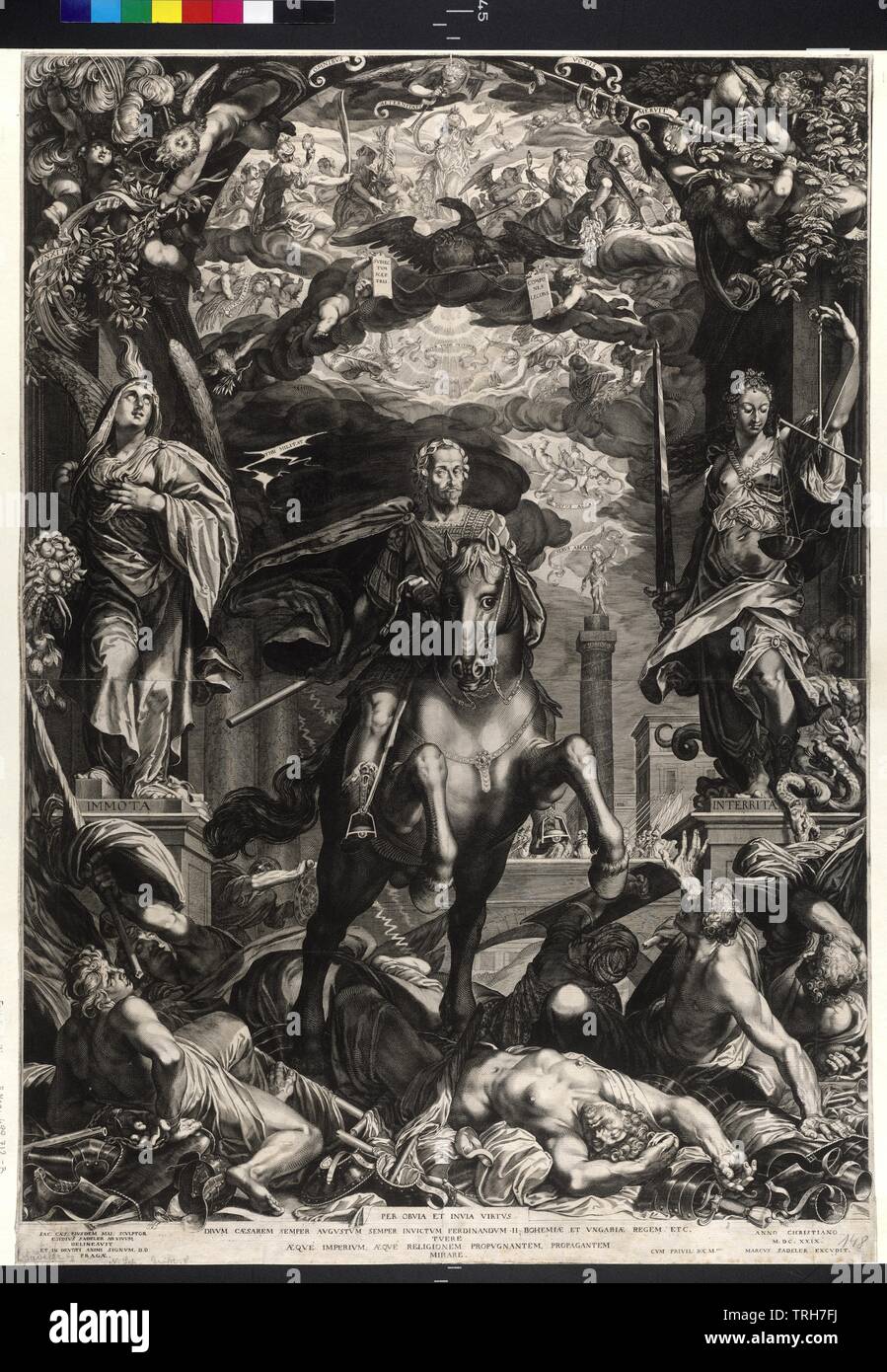 Emperor Ferdinand II glory above its enemy, The Emperor on horse in ancient armament, glory about heretic, disbeliever and Turks. he is riding through a triumphal arch, the allegory of the belief with the inscription 'IMMOTA' (unshaken), as well as the allegory of the justice, with the inscription 'INTERRITA' (undauntedly). above the Emperor imperial eagle and in the apertured sky different allegories (virtues), in the head angle putting with laurel branchs, helmet, of a garlanded pike and banners. insinuation on the ancient world by inscription , Additional-Rights-Clearance-Info-Not-Available Stock Photohttps://www.alamy.com/image-license-details/?v=1https://www.alamy.com/emperor-ferdinand-ii-glory-above-its-enemy-the-emperor-on-horse-in-ancient-armament-glory-about-heretic-disbeliever-and-turks-he-is-riding-through-a-triumphal-arch-the-allegory-of-the-belief-with-the-inscription-immota-unshaken-as-well-as-the-allegory-of-the-justice-with-the-inscription-interrita-undauntedly-above-the-emperor-imperial-eagle-and-in-the-apertured-sky-different-allegories-virtues-in-the-head-angle-putting-with-laurel-branchs-helmet-of-a-garlanded-pike-and-banners-insinuation-on-the-ancient-world-by-inscription-additional-rights-clearance-info-not-available-image255461350.html
Emperor Ferdinand II glory above its enemy, The Emperor on horse in ancient armament, glory about heretic, disbeliever and Turks. he is riding through a triumphal arch, the allegory of the belief with the inscription 'IMMOTA' (unshaken), as well as the allegory of the justice, with the inscription 'INTERRITA' (undauntedly). above the Emperor imperial eagle and in the apertured sky different allegories (virtues), in the head angle putting with laurel branchs, helmet, of a garlanded pike and banners. insinuation on the ancient world by inscription , Additional-Rights-Clearance-Info-Not-Available Stock Photohttps://www.alamy.com/image-license-details/?v=1https://www.alamy.com/emperor-ferdinand-ii-glory-above-its-enemy-the-emperor-on-horse-in-ancient-armament-glory-about-heretic-disbeliever-and-turks-he-is-riding-through-a-triumphal-arch-the-allegory-of-the-belief-with-the-inscription-immota-unshaken-as-well-as-the-allegory-of-the-justice-with-the-inscription-interrita-undauntedly-above-the-emperor-imperial-eagle-and-in-the-apertured-sky-different-allegories-virtues-in-the-head-angle-putting-with-laurel-branchs-helmet-of-a-garlanded-pike-and-banners-insinuation-on-the-ancient-world-by-inscription-additional-rights-clearance-info-not-available-image255461350.htmlRMTRH7FJ–Emperor Ferdinand II glory above its enemy, The Emperor on horse in ancient armament, glory about heretic, disbeliever and Turks. he is riding through a triumphal arch, the allegory of the belief with the inscription 'IMMOTA' (unshaken), as well as the allegory of the justice, with the inscription 'INTERRITA' (undauntedly). above the Emperor imperial eagle and in the apertured sky different allegories (virtues), in the head angle putting with laurel branchs, helmet, of a garlanded pike and banners. insinuation on the ancient world by inscription , Additional-Rights-Clearance-Info-Not-Available
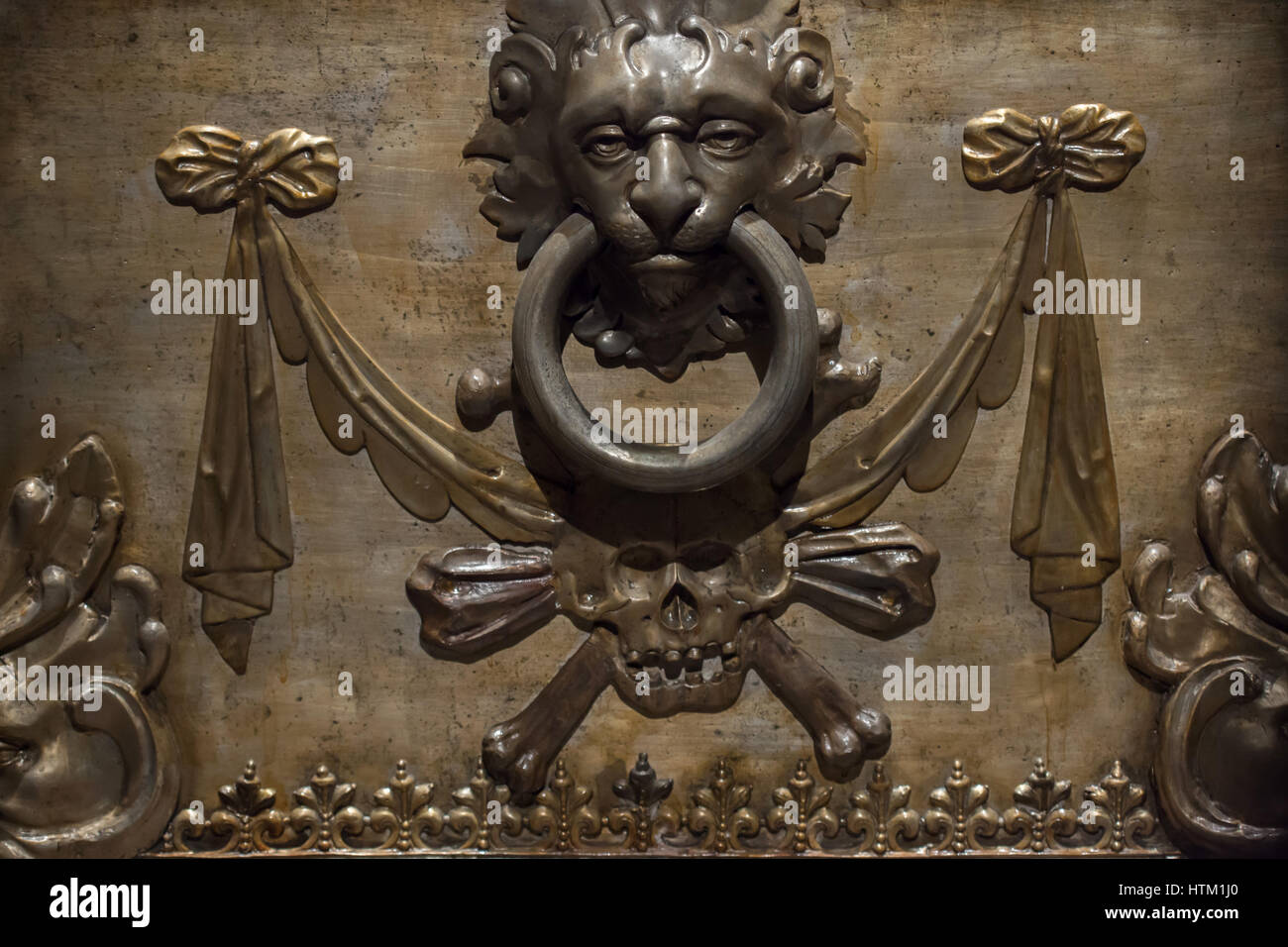 Skull and bones and doorknocker depicted on the sarcophagus of Empress Maria Anna (1606 - 1646) in the Kaisergruft (Imperial Crypt) in Vienna, Austria. Empress Maria Anna was the first wife of Holy Roman Emperor Ferdinand III. She is better known as Infanta Maria Anna of Spain pictured by Spanish painter Diego Velazquez. Stock Photohttps://www.alamy.com/image-license-details/?v=1https://www.alamy.com/stock-photo-skull-and-bones-and-doorknocker-depicted-on-the-sarcophagus-of-empress-135664648.html
Skull and bones and doorknocker depicted on the sarcophagus of Empress Maria Anna (1606 - 1646) in the Kaisergruft (Imperial Crypt) in Vienna, Austria. Empress Maria Anna was the first wife of Holy Roman Emperor Ferdinand III. She is better known as Infanta Maria Anna of Spain pictured by Spanish painter Diego Velazquez. Stock Photohttps://www.alamy.com/image-license-details/?v=1https://www.alamy.com/stock-photo-skull-and-bones-and-doorknocker-depicted-on-the-sarcophagus-of-empress-135664648.htmlRMHTM1J0–Skull and bones and doorknocker depicted on the sarcophagus of Empress Maria Anna (1606 - 1646) in the Kaisergruft (Imperial Crypt) in Vienna, Austria. Empress Maria Anna was the first wife of Holy Roman Emperor Ferdinand III. She is better known as Infanta Maria Anna of Spain pictured by Spanish painter Diego Velazquez.
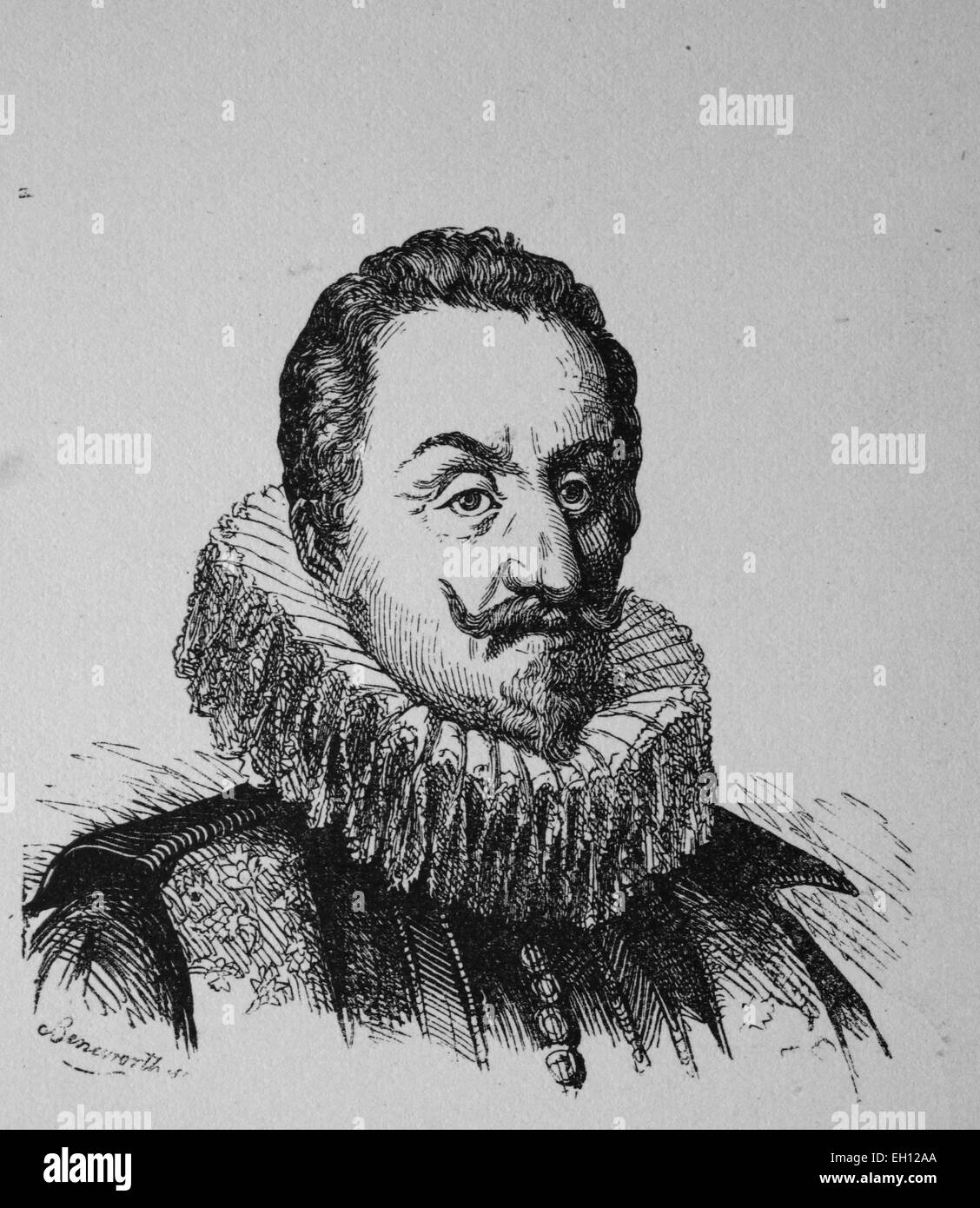 Ferdinand II, 1578 - 1637, King of Bohemia, Hungary, Croatia, Emperor of the Holy Roman Empire, historical woodcut, circa 1880 Stock Photohttps://www.alamy.com/image-license-details/?v=1https://www.alamy.com/stock-photo-ferdinand-ii-1578-1637-king-of-bohemia-hungary-croatia-emperor-of-79314434.html
Ferdinand II, 1578 - 1637, King of Bohemia, Hungary, Croatia, Emperor of the Holy Roman Empire, historical woodcut, circa 1880 Stock Photohttps://www.alamy.com/image-license-details/?v=1https://www.alamy.com/stock-photo-ferdinand-ii-1578-1637-king-of-bohemia-hungary-croatia-emperor-of-79314434.htmlRFEH12AA–Ferdinand II, 1578 - 1637, King of Bohemia, Hungary, Croatia, Emperor of the Holy Roman Empire, historical woodcut, circa 1880
 The coronation of King Ferdinand II as Holy Roman Emperor. Artist: Kieser, Eberhard (1583-1631) Stock Photohttps://www.alamy.com/image-license-details/?v=1https://www.alamy.com/stock-photo-the-coronation-of-king-ferdinand-ii-as-holy-roman-emperor-artist-kieser-74096062.html
The coronation of King Ferdinand II as Holy Roman Emperor. Artist: Kieser, Eberhard (1583-1631) Stock Photohttps://www.alamy.com/image-license-details/?v=1https://www.alamy.com/stock-photo-the-coronation-of-king-ferdinand-ii-as-holy-roman-emperor-artist-kieser-74096062.htmlRME8FA7X–The coronation of King Ferdinand II as Holy Roman Emperor. Artist: Kieser, Eberhard (1583-1631)
 Ferdinand II., July 9, 1578 - February 15, 1637, was Emperor of the Holy Roman Empire from 1619 until his death, at the age of 42 / Ferdinand II. war von 1619 bis zu seinem Tode Kaiser des Heiligen Römischen Reiches, im Alter von 42 Jahren, Historisch, digital improved reproduction of an original from the 19th century / digitale Reproduktion einer Originalvorlage aus dem 19. Jahrhundert, Stock Photohttps://www.alamy.com/image-license-details/?v=1https://www.alamy.com/ferdinand-ii-july-9-1578-february-15-1637-was-emperor-of-the-holy-roman-empire-from-1619-until-his-death-at-the-age-of-42-ferdinand-ii-war-von-1619-bis-zu-seinem-tode-kaiser-des-heiligen-rmischen-reiches-im-alter-von-42-jahren-historisch-digital-improved-reproduction-of-an-original-from-the-19th-century-digitale-reproduktion-einer-originalvorlage-aus-dem-19-jahrhundert-image348384776.html
Ferdinand II., July 9, 1578 - February 15, 1637, was Emperor of the Holy Roman Empire from 1619 until his death, at the age of 42 / Ferdinand II. war von 1619 bis zu seinem Tode Kaiser des Heiligen Römischen Reiches, im Alter von 42 Jahren, Historisch, digital improved reproduction of an original from the 19th century / digitale Reproduktion einer Originalvorlage aus dem 19. Jahrhundert, Stock Photohttps://www.alamy.com/image-license-details/?v=1https://www.alamy.com/ferdinand-ii-july-9-1578-february-15-1637-was-emperor-of-the-holy-roman-empire-from-1619-until-his-death-at-the-age-of-42-ferdinand-ii-war-von-1619-bis-zu-seinem-tode-kaiser-des-heiligen-rmischen-reiches-im-alter-von-42-jahren-historisch-digital-improved-reproduction-of-an-original-from-the-19th-century-digitale-reproduktion-einer-originalvorlage-aus-dem-19-jahrhundert-image348384776.htmlRF2B6P89C–Ferdinand II., July 9, 1578 - February 15, 1637, was Emperor of the Holy Roman Empire from 1619 until his death, at the age of 42 / Ferdinand II. war von 1619 bis zu seinem Tode Kaiser des Heiligen Römischen Reiches, im Alter von 42 Jahren, Historisch, digital improved reproduction of an original from the 19th century / digitale Reproduktion einer Originalvorlage aus dem 19. Jahrhundert,
 Figure in armor with crown and scepter, Ferdinand IV of Austria, Ferdinand IV of Austria, Emperor of the Holy Roman Empire, in armor and with crown and sceptre, with his left foot on a crocodile. In the background an eagle with a lightning bolt and putti under a curtain. Above his portrait is a wreath of thorns and the ideogram of an equilateral triangle as a symbol for the Holy Trinity., print, print maker: Jacobus Harrewijn, (mentioned on object), after design by: Caspar Jacob van Opstal (II), (mentioned on object), Low Countries, 1682 - 1730, paper, etching, engraving, height, 240 mm × widt Stock Photohttps://www.alamy.com/image-license-details/?v=1https://www.alamy.com/figure-in-armor-with-crown-and-scepter-ferdinand-iv-of-austria-ferdinand-iv-of-austria-emperor-of-the-holy-roman-empire-in-armor-and-with-crown-and-sceptre-with-his-left-foot-on-a-crocodile-in-the-background-an-eagle-with-a-lightning-bolt-and-putti-under-a-curtain-above-his-portrait-is-a-wreath-of-thorns-and-the-ideogram-of-an-equilateral-triangle-as-a-symbol-for-the-holy-trinity-print-print-maker-jacobus-harrewijn-mentioned-on-object-after-design-by-caspar-jacob-van-opstal-ii-mentioned-on-object-low-countries-1682-1730-paper-etching-engraving-height-240-mm-widt-image623510032.html
Figure in armor with crown and scepter, Ferdinand IV of Austria, Ferdinand IV of Austria, Emperor of the Holy Roman Empire, in armor and with crown and sceptre, with his left foot on a crocodile. In the background an eagle with a lightning bolt and putti under a curtain. Above his portrait is a wreath of thorns and the ideogram of an equilateral triangle as a symbol for the Holy Trinity., print, print maker: Jacobus Harrewijn, (mentioned on object), after design by: Caspar Jacob van Opstal (II), (mentioned on object), Low Countries, 1682 - 1730, paper, etching, engraving, height, 240 mm × widt Stock Photohttps://www.alamy.com/image-license-details/?v=1https://www.alamy.com/figure-in-armor-with-crown-and-scepter-ferdinand-iv-of-austria-ferdinand-iv-of-austria-emperor-of-the-holy-roman-empire-in-armor-and-with-crown-and-sceptre-with-his-left-foot-on-a-crocodile-in-the-background-an-eagle-with-a-lightning-bolt-and-putti-under-a-curtain-above-his-portrait-is-a-wreath-of-thorns-and-the-ideogram-of-an-equilateral-triangle-as-a-symbol-for-the-holy-trinity-print-print-maker-jacobus-harrewijn-mentioned-on-object-after-design-by-caspar-jacob-van-opstal-ii-mentioned-on-object-low-countries-1682-1730-paper-etching-engraving-height-240-mm-widt-image623510032.htmlRM2Y6B9BC–Figure in armor with crown and scepter, Ferdinand IV of Austria, Ferdinand IV of Austria, Emperor of the Holy Roman Empire, in armor and with crown and sceptre, with his left foot on a crocodile. In the background an eagle with a lightning bolt and putti under a curtain. Above his portrait is a wreath of thorns and the ideogram of an equilateral triangle as a symbol for the Holy Trinity., print, print maker: Jacobus Harrewijn, (mentioned on object), after design by: Caspar Jacob van Opstal (II), (mentioned on object), Low Countries, 1682 - 1730, paper, etching, engraving, height, 240 mm × widt
 Ferdinand I (1503-1564) was the son of Philip I of Castile and Queen Joanna I of Castile, grandson of Emperor Maximilian I and younger brother of future emperor Charles V. Born and raised in Spain, he was sent to Flanders in 1518. When Charles became Holy Roman emperor in 1519, Ferdinand was entrusted with the governing of their hereditary Austrian lands, becoming Archduke of Austria and adopting the German culture as his own. Ferdinand became King of Bohemia and Hungary in 1526 after the death of his brother-in-law Louis II, and served as his brother Charles' deputy in the Holy Roman Empire Stock Photohttps://www.alamy.com/image-license-details/?v=1https://www.alamy.com/ferdinand-i-1503-1564-was-the-son-of-philip-i-of-castile-and-queen-joanna-i-of-castile-grandson-of-emperor-maximilian-i-and-younger-brother-of-future-emperor-charles-v-born-and-raised-in-spain-he-was-sent-to-flanders-in-1518-when-charles-became-holy-roman-emperor-in-1519-ferdinand-was-entrusted-with-the-governing-of-their-hereditary-austrian-lands-becoming-archduke-of-austria-and-adopting-the-german-culture-as-his-own-ferdinand-became-king-of-bohemia-and-hungary-in-1526-after-the-death-of-his-brother-in-law-louis-ii-and-served-as-his-brother-charles-deputy-in-the-holy-roman-empire-image344281182.html
Ferdinand I (1503-1564) was the son of Philip I of Castile and Queen Joanna I of Castile, grandson of Emperor Maximilian I and younger brother of future emperor Charles V. Born and raised in Spain, he was sent to Flanders in 1518. When Charles became Holy Roman emperor in 1519, Ferdinand was entrusted with the governing of their hereditary Austrian lands, becoming Archduke of Austria and adopting the German culture as his own. Ferdinand became King of Bohemia and Hungary in 1526 after the death of his brother-in-law Louis II, and served as his brother Charles' deputy in the Holy Roman Empire Stock Photohttps://www.alamy.com/image-license-details/?v=1https://www.alamy.com/ferdinand-i-1503-1564-was-the-son-of-philip-i-of-castile-and-queen-joanna-i-of-castile-grandson-of-emperor-maximilian-i-and-younger-brother-of-future-emperor-charles-v-born-and-raised-in-spain-he-was-sent-to-flanders-in-1518-when-charles-became-holy-roman-emperor-in-1519-ferdinand-was-entrusted-with-the-governing-of-their-hereditary-austrian-lands-becoming-archduke-of-austria-and-adopting-the-german-culture-as-his-own-ferdinand-became-king-of-bohemia-and-hungary-in-1526-after-the-death-of-his-brother-in-law-louis-ii-and-served-as-his-brother-charles-deputy-in-the-holy-roman-empire-image344281182.htmlRM2B03A4E–Ferdinand I (1503-1564) was the son of Philip I of Castile and Queen Joanna I of Castile, grandson of Emperor Maximilian I and younger brother of future emperor Charles V. Born and raised in Spain, he was sent to Flanders in 1518. When Charles became Holy Roman emperor in 1519, Ferdinand was entrusted with the governing of their hereditary Austrian lands, becoming Archduke of Austria and adopting the German culture as his own. Ferdinand became King of Bohemia and Hungary in 1526 after the death of his brother-in-law Louis II, and served as his brother Charles' deputy in the Holy Roman Empire
 Jaroslav Bořita of Martinice and Vilém Slavata of Chlum thrown from the window of the palace in Prague during the The Defenestration of Prague in 1618. Jaroslav Bořita z Martinic, 1582 – 1649. Czech nobleman and a representative of Ferdinand II, Holy Roman Emperor. Vilém Slavata z Chlumu a Košumberka, 1572 – 1652. Czech nobleman. From Ward and Lock's Illustrated History of the World, published c.1882. Stock Photohttps://www.alamy.com/image-license-details/?v=1https://www.alamy.com/stock-photo-jaroslav-boita-of-martinice-and-vilm-slavata-of-chlum-thrown-from-172035928.html
Jaroslav Bořita of Martinice and Vilém Slavata of Chlum thrown from the window of the palace in Prague during the The Defenestration of Prague in 1618. Jaroslav Bořita z Martinic, 1582 – 1649. Czech nobleman and a representative of Ferdinand II, Holy Roman Emperor. Vilém Slavata z Chlumu a Košumberka, 1572 – 1652. Czech nobleman. From Ward and Lock's Illustrated History of the World, published c.1882. Stock Photohttps://www.alamy.com/image-license-details/?v=1https://www.alamy.com/stock-photo-jaroslav-boita-of-martinice-and-vilm-slavata-of-chlum-thrown-from-172035928.htmlRMKYTWG8–Jaroslav Bořita of Martinice and Vilém Slavata of Chlum thrown from the window of the palace in Prague during the The Defenestration of Prague in 1618. Jaroslav Bořita z Martinic, 1582 – 1649. Czech nobleman and a representative of Ferdinand II, Holy Roman Emperor. Vilém Slavata z Chlumu a Košumberka, 1572 – 1652. Czech nobleman. From Ward and Lock's Illustrated History of the World, published c.1882.
 Ferdinand II (1578-1637) was the son of Charles II, Archduke of Austria, and grandson of Emperor Ferdinand I. Ferdinand was part of a Catholic faction opposed to his cousin, Emperor Matthias, who was more tolerant to Protestantism. He became King of Bohemia in 1617, King of Hungary in 1618, and became Holy Roman Emperor in 1619 after his cousin's death. Stock Photohttps://www.alamy.com/image-license-details/?v=1https://www.alamy.com/ferdinand-ii-1578-1637-was-the-son-of-charles-ii-archduke-of-austria-and-grandson-of-emperor-ferdinand-i-ferdinand-was-part-of-a-catholic-faction-opposed-to-his-cousin-emperor-matthias-who-was-more-tolerant-to-protestantism-he-became-king-of-bohemia-in-1617-king-of-hungary-in-1618-and-became-holy-roman-emperor-in-1619-after-his-cousins-death-image344282316.html
Ferdinand II (1578-1637) was the son of Charles II, Archduke of Austria, and grandson of Emperor Ferdinand I. Ferdinand was part of a Catholic faction opposed to his cousin, Emperor Matthias, who was more tolerant to Protestantism. He became King of Bohemia in 1617, King of Hungary in 1618, and became Holy Roman Emperor in 1619 after his cousin's death. Stock Photohttps://www.alamy.com/image-license-details/?v=1https://www.alamy.com/ferdinand-ii-1578-1637-was-the-son-of-charles-ii-archduke-of-austria-and-grandson-of-emperor-ferdinand-i-ferdinand-was-part-of-a-catholic-faction-opposed-to-his-cousin-emperor-matthias-who-was-more-tolerant-to-protestantism-he-became-king-of-bohemia-in-1617-king-of-hungary-in-1618-and-became-holy-roman-emperor-in-1619-after-his-cousins-death-image344282316.htmlRM2B03BH0–Ferdinand II (1578-1637) was the son of Charles II, Archduke of Austria, and grandson of Emperor Ferdinand I. Ferdinand was part of a Catholic faction opposed to his cousin, Emperor Matthias, who was more tolerant to Protestantism. He became King of Bohemia in 1617, King of Hungary in 1618, and became Holy Roman Emperor in 1619 after his cousin's death.
 Ferdinand II, 1578 - 1637, Holy Roman Emperor, King of Bohemia and Hungary, House of Habsburg, Ferdinand II. , 1578 - 1637, Kais Stock Photohttps://www.alamy.com/image-license-details/?v=1https://www.alamy.com/stock-photo-ferdinand-ii-1578-1637-holy-roman-emperor-king-of-bohemia-and-hungary-75771861.html
Ferdinand II, 1578 - 1637, Holy Roman Emperor, King of Bohemia and Hungary, House of Habsburg, Ferdinand II. , 1578 - 1637, Kais Stock Photohttps://www.alamy.com/image-license-details/?v=1https://www.alamy.com/stock-photo-ferdinand-ii-1578-1637-holy-roman-emperor-king-of-bohemia-and-hungary-75771861.htmlRMEB7KNW–Ferdinand II, 1578 - 1637, Holy Roman Emperor, King of Bohemia and Hungary, House of Habsburg, Ferdinand II. , 1578 - 1637, Kais
 Graz: Denkmalenthüllung Stock Photohttps://www.alamy.com/image-license-details/?v=1https://www.alamy.com/stock-photo-graz-denkmalenthllung-102637147.html
Graz: Denkmalenthüllung Stock Photohttps://www.alamy.com/image-license-details/?v=1https://www.alamy.com/stock-photo-graz-denkmalenthllung-102637147.htmlRMFXYEMB–Graz: Denkmalenthüllung
 Portrait of Holy Roman Emperor Francis II (1768-1835), 1827. Stock Photohttps://www.alamy.com/image-license-details/?v=1https://www.alamy.com/portrait-of-holy-roman-emperor-francis-ii-1768-1835-1827-image186193942.html
Portrait of Holy Roman Emperor Francis II (1768-1835), 1827. Stock Photohttps://www.alamy.com/image-license-details/?v=1https://www.alamy.com/portrait-of-holy-roman-emperor-francis-ii-1768-1835-1827-image186193942.htmlRMMPWT7J–Portrait of Holy Roman Emperor Francis II (1768-1835), 1827.
 Crucifixion (tempera on panel) by Rimini, Pietro da (fl.1309-33); Palazzo Ducale, Urbino, Italy; Italian, out of copyright. Stock Photohttps://www.alamy.com/image-license-details/?v=1https://www.alamy.com/crucifixion-tempera-on-panel-by-rimini-pietro-da-fl1309-33-palazzo-ducale-urbino-italy-italian-out-of-copyright-image469741315.html
Crucifixion (tempera on panel) by Rimini, Pietro da (fl.1309-33); Palazzo Ducale, Urbino, Italy; Italian, out of copyright. Stock Photohttps://www.alamy.com/image-license-details/?v=1https://www.alamy.com/crucifixion-tempera-on-panel-by-rimini-pietro-da-fl1309-33-palazzo-ducale-urbino-italy-italian-out-of-copyright-image469741315.htmlRM2J86FRF–Crucifixion (tempera on panel) by Rimini, Pietro da (fl.1309-33); Palazzo Ducale, Urbino, Italy; Italian, out of copyright.
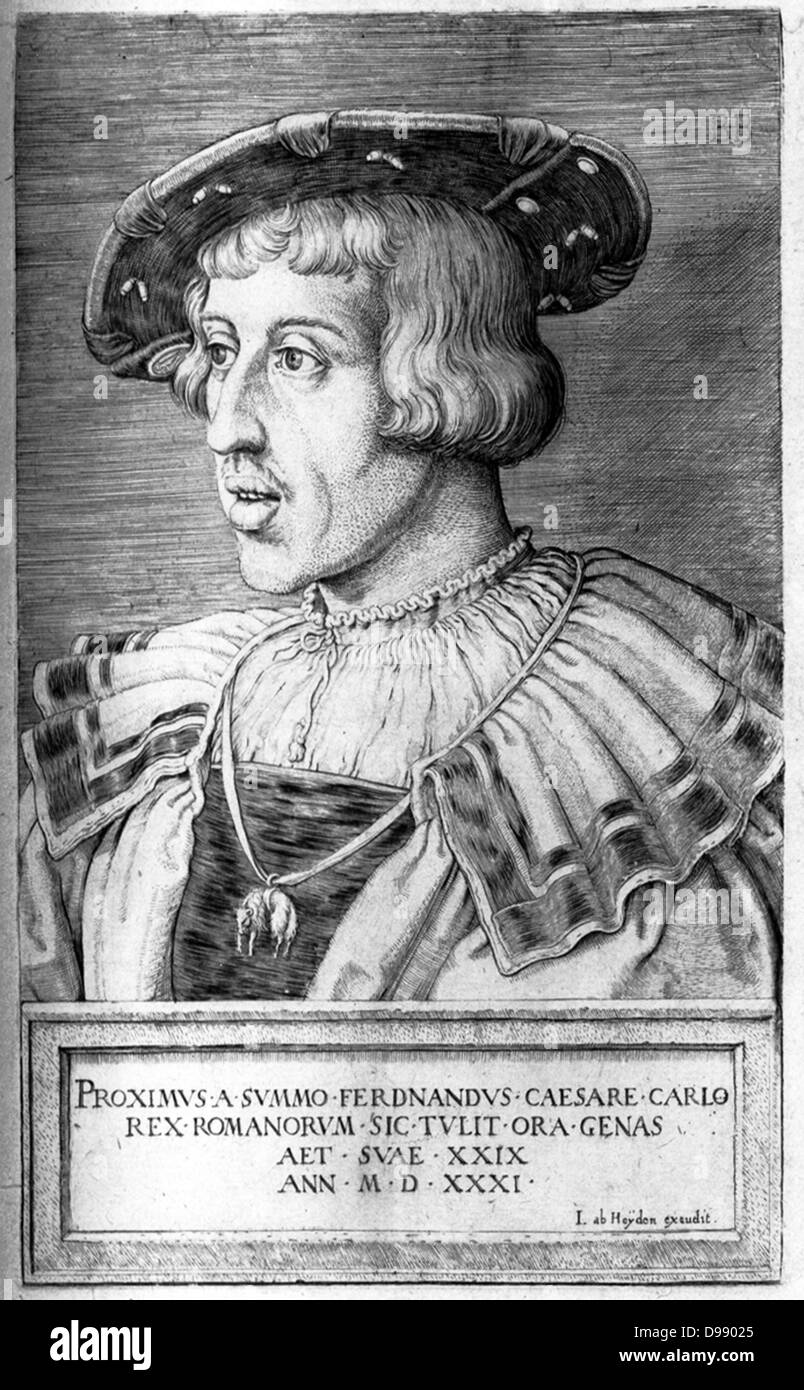 Ferdinand I, Holy Roman Emperor 10 March 1503 – 25 July 1564. Central European monarch from the House of Habsburg. His titles Stock Photohttps://www.alamy.com/image-license-details/?v=1https://www.alamy.com/stock-photo-ferdinand-i-holy-roman-emperor-10-march-1503-25-july-1564-central-57360637.html
Ferdinand I, Holy Roman Emperor 10 March 1503 – 25 July 1564. Central European monarch from the House of Habsburg. His titles Stock Photohttps://www.alamy.com/image-license-details/?v=1https://www.alamy.com/stock-photo-ferdinand-i-holy-roman-emperor-10-march-1503-25-july-1564-central-57360637.htmlRMD99025–Ferdinand I, Holy Roman Emperor 10 March 1503 – 25 July 1564. Central European monarch from the House of Habsburg. His titles
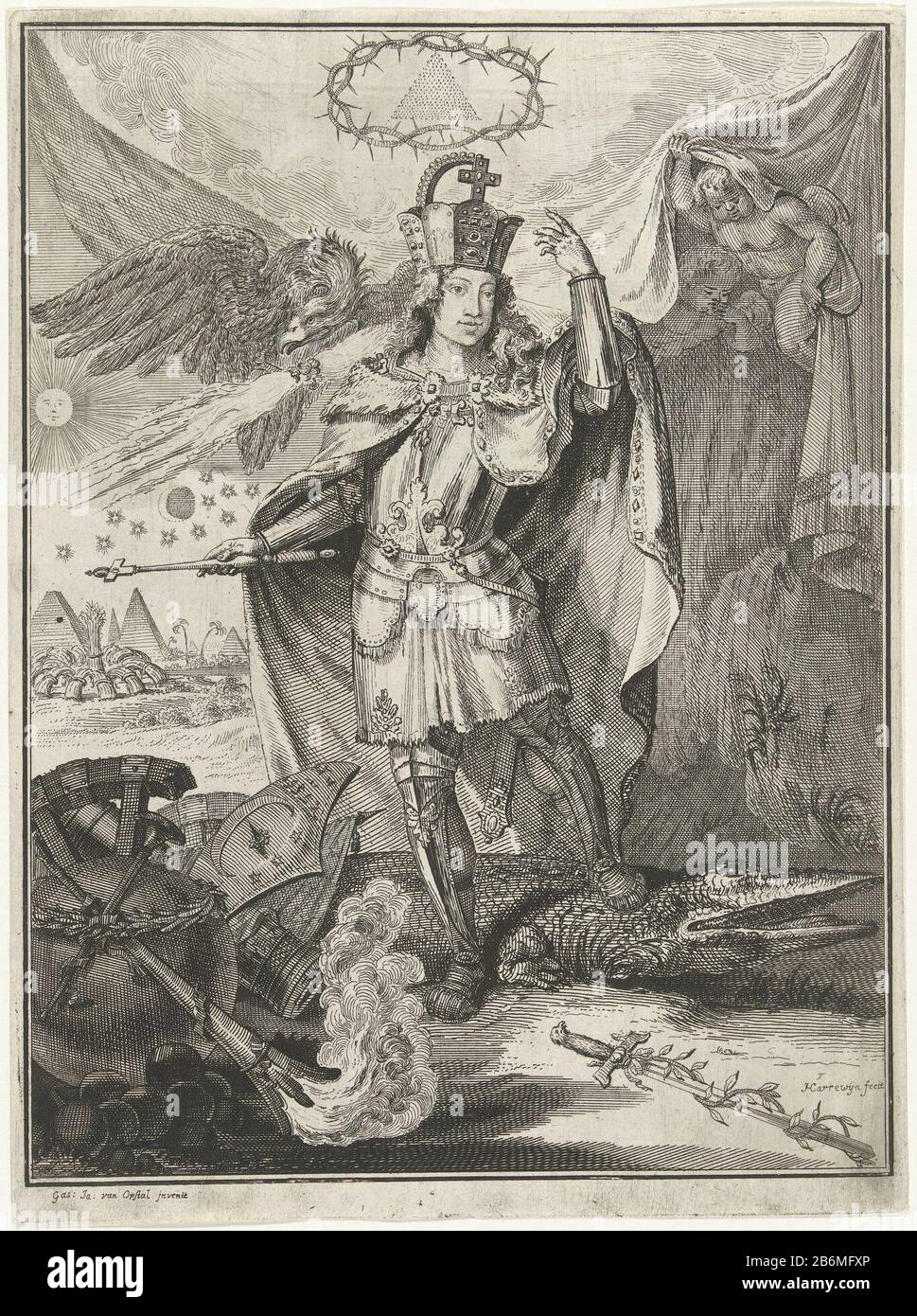 Figuur in harnas met kroon en scepter Ferdinand IV van Oostenrijk Ferdinand IV of Austria, Emperor of the Holy Roman rich in armor and with crown and scepter, and his left foot on a crocodile. In the background, an eagle with a lightning bolt and putti beneath a curtain. Above his portrait a crown of thorns and the ideogram of an equilateral triangle symbolizing the Holy Drieëenheid. Manufacturer : printmaker: James Harrewijn (listed property) designed by Caspar Jacob van Opstal (II) (listed building) Place manufacture: Netherlands Dating 1682 - 1730 Physical features: etching and engra materi Stock Photohttps://www.alamy.com/image-license-details/?v=1https://www.alamy.com/figuur-in-harnas-met-kroon-en-scepter-ferdinand-iv-van-oostenrijk-ferdinand-iv-of-austria-emperor-of-the-holy-roman-rich-in-armor-and-with-crown-and-scepter-and-his-left-foot-on-a-crocodile-in-the-background-an-eagle-with-a-lightning-bolt-and-putti-beneath-a-curtain-above-his-portrait-a-crown-of-thorns-and-the-ideogram-of-an-equilateral-triangle-symbolizing-the-holy-drieenheid-manufacturer-printmaker-james-harrewijn-listed-property-designed-by-caspar-jacob-van-opstal-ii-listed-building-place-manufacture-netherlands-dating-1682-1730-physical-features-etching-and-engra-materi-image348346846.html
Figuur in harnas met kroon en scepter Ferdinand IV van Oostenrijk Ferdinand IV of Austria, Emperor of the Holy Roman rich in armor and with crown and scepter, and his left foot on a crocodile. In the background, an eagle with a lightning bolt and putti beneath a curtain. Above his portrait a crown of thorns and the ideogram of an equilateral triangle symbolizing the Holy Drieëenheid. Manufacturer : printmaker: James Harrewijn (listed property) designed by Caspar Jacob van Opstal (II) (listed building) Place manufacture: Netherlands Dating 1682 - 1730 Physical features: etching and engra materi Stock Photohttps://www.alamy.com/image-license-details/?v=1https://www.alamy.com/figuur-in-harnas-met-kroon-en-scepter-ferdinand-iv-van-oostenrijk-ferdinand-iv-of-austria-emperor-of-the-holy-roman-rich-in-armor-and-with-crown-and-scepter-and-his-left-foot-on-a-crocodile-in-the-background-an-eagle-with-a-lightning-bolt-and-putti-beneath-a-curtain-above-his-portrait-a-crown-of-thorns-and-the-ideogram-of-an-equilateral-triangle-symbolizing-the-holy-drieenheid-manufacturer-printmaker-james-harrewijn-listed-property-designed-by-caspar-jacob-van-opstal-ii-listed-building-place-manufacture-netherlands-dating-1682-1730-physical-features-etching-and-engra-materi-image348346846.htmlRM2B6MFXP–Figuur in harnas met kroon en scepter Ferdinand IV van Oostenrijk Ferdinand IV of Austria, Emperor of the Holy Roman rich in armor and with crown and scepter, and his left foot on a crocodile. In the background, an eagle with a lightning bolt and putti beneath a curtain. Above his portrait a crown of thorns and the ideogram of an equilateral triangle symbolizing the Holy Drieëenheid. Manufacturer : printmaker: James Harrewijn (listed property) designed by Caspar Jacob van Opstal (II) (listed building) Place manufacture: Netherlands Dating 1682 - 1730 Physical features: etching and engra materi
 Maximilian II. Son of the Emperor Ferdinand I.; born d. 1 August 1527; Archduke of Austria, became King of Bohemia in 1562, King of Hungary (...). Maximilian II., Emperor of the Holy Roman Empire. Heinrich (Wilhelm) Schlesinger (1814-1893), Artist, Anton Berka (1765-1838), publisher, Johann Rauh (1803-1863), printer Stock Photohttps://www.alamy.com/image-license-details/?v=1https://www.alamy.com/maximilian-ii-son-of-the-emperor-ferdinand-i-born-d-1-august-1527-archduke-of-austria-became-king-of-bohemia-in-1562-king-of-hungary-maximilian-ii-emperor-of-the-holy-roman-empire-heinrich-wilhelm-schlesinger-1814-1893-artist-anton-berka-1765-1838-publisher-johann-rauh-1803-1863-printer-image471154474.html
Maximilian II. Son of the Emperor Ferdinand I.; born d. 1 August 1527; Archduke of Austria, became King of Bohemia in 1562, King of Hungary (...). Maximilian II., Emperor of the Holy Roman Empire. Heinrich (Wilhelm) Schlesinger (1814-1893), Artist, Anton Berka (1765-1838), publisher, Johann Rauh (1803-1863), printer Stock Photohttps://www.alamy.com/image-license-details/?v=1https://www.alamy.com/maximilian-ii-son-of-the-emperor-ferdinand-i-born-d-1-august-1527-archduke-of-austria-became-king-of-bohemia-in-1562-king-of-hungary-maximilian-ii-emperor-of-the-holy-roman-empire-heinrich-wilhelm-schlesinger-1814-1893-artist-anton-berka-1765-1838-publisher-johann-rauh-1803-1863-printer-image471154474.htmlRM2JAEX9E–Maximilian II. Son of the Emperor Ferdinand I.; born d. 1 August 1527; Archduke of Austria, became King of Bohemia in 1562, King of Hungary (...). Maximilian II., Emperor of the Holy Roman Empire. Heinrich (Wilhelm) Schlesinger (1814-1893), Artist, Anton Berka (1765-1838), publisher, Johann Rauh (1803-1863), printer
 Ferdinand II, Holy Roman Emperor. Stock Photohttps://www.alamy.com/image-license-details/?v=1https://www.alamy.com/ferdinand-ii-holy-roman-emperor-image329601135.html
Ferdinand II, Holy Roman Emperor. Stock Photohttps://www.alamy.com/image-license-details/?v=1https://www.alamy.com/ferdinand-ii-holy-roman-emperor-image329601135.htmlRM2A46HH3–Ferdinand II, Holy Roman Emperor.
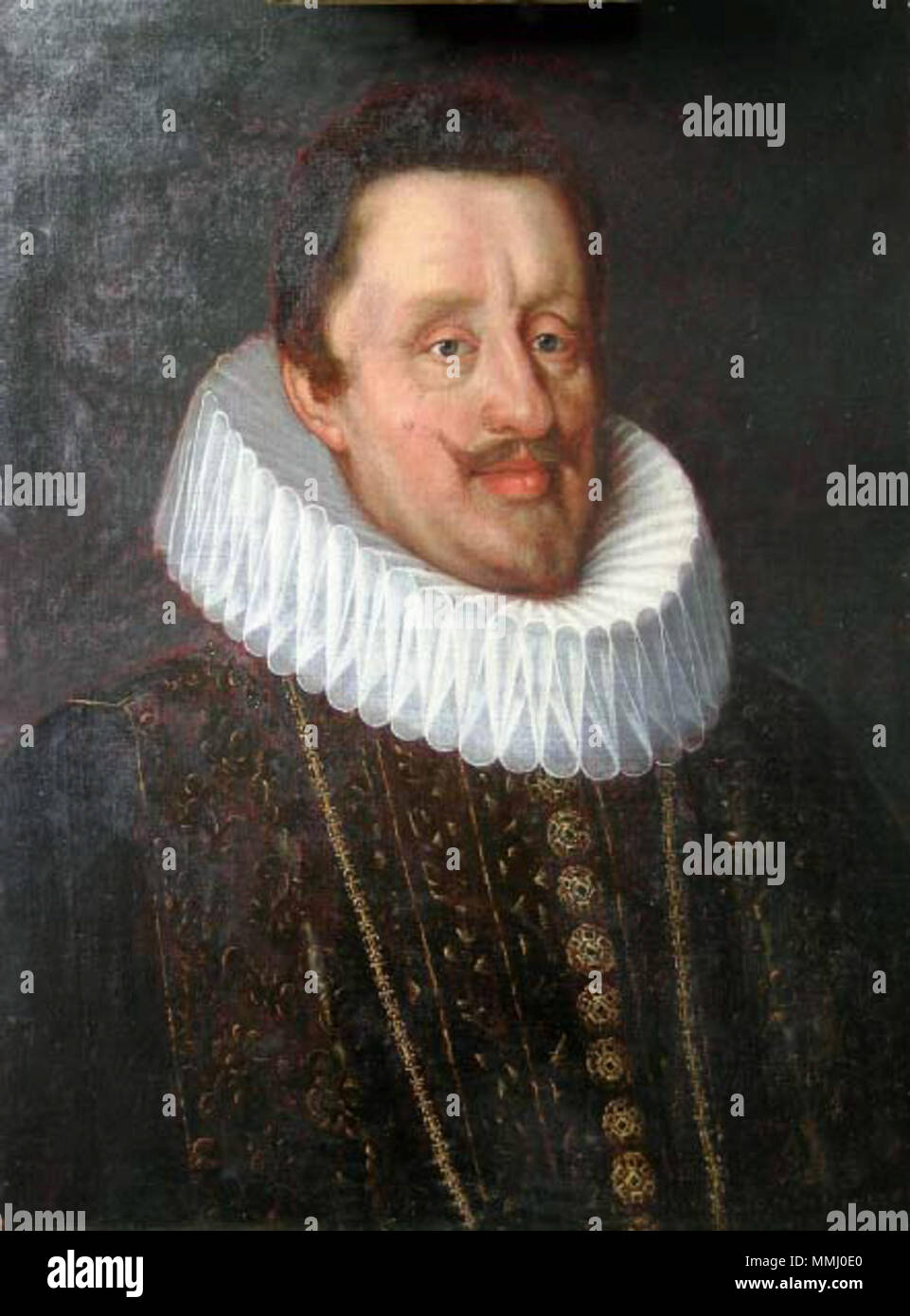 Portrait of Ferdinand II, Holy Roman Emperor.. circa 1624. Sustermans Ferdinand II Stock Photohttps://www.alamy.com/image-license-details/?v=1https://www.alamy.com/portrait-of-ferdinand-ii-holy-roman-emperor-circa-1624-sustermans-ferdinand-ii-image184792328.html
Portrait of Ferdinand II, Holy Roman Emperor.. circa 1624. Sustermans Ferdinand II Stock Photohttps://www.alamy.com/image-license-details/?v=1https://www.alamy.com/portrait-of-ferdinand-ii-holy-roman-emperor-circa-1624-sustermans-ferdinand-ii-image184792328.htmlRMMMJ0E0–Portrait of Ferdinand II, Holy Roman Emperor.. circa 1624. Sustermans Ferdinand II
 Portrait of Holy Roman Emperor Francis II (1768-1835). Museum: PRIVATE COLLECTION. Author: Waldmüller, Ferdinand Georg. Stock Photohttps://www.alamy.com/image-license-details/?v=1https://www.alamy.com/portrait-of-holy-roman-emperor-francis-ii-1768-1835-museum-private-collection-author-waldmller-ferdinand-georg-image231908825.html
Portrait of Holy Roman Emperor Francis II (1768-1835). Museum: PRIVATE COLLECTION. Author: Waldmüller, Ferdinand Georg. Stock Photohttps://www.alamy.com/image-license-details/?v=1https://www.alamy.com/portrait-of-holy-roman-emperor-francis-ii-1768-1835-museum-private-collection-author-waldmller-ferdinand-georg-image231908825.htmlRMRD8A21–Portrait of Holy Roman Emperor Francis II (1768-1835). Museum: PRIVATE COLLECTION. Author: Waldmüller, Ferdinand Georg.
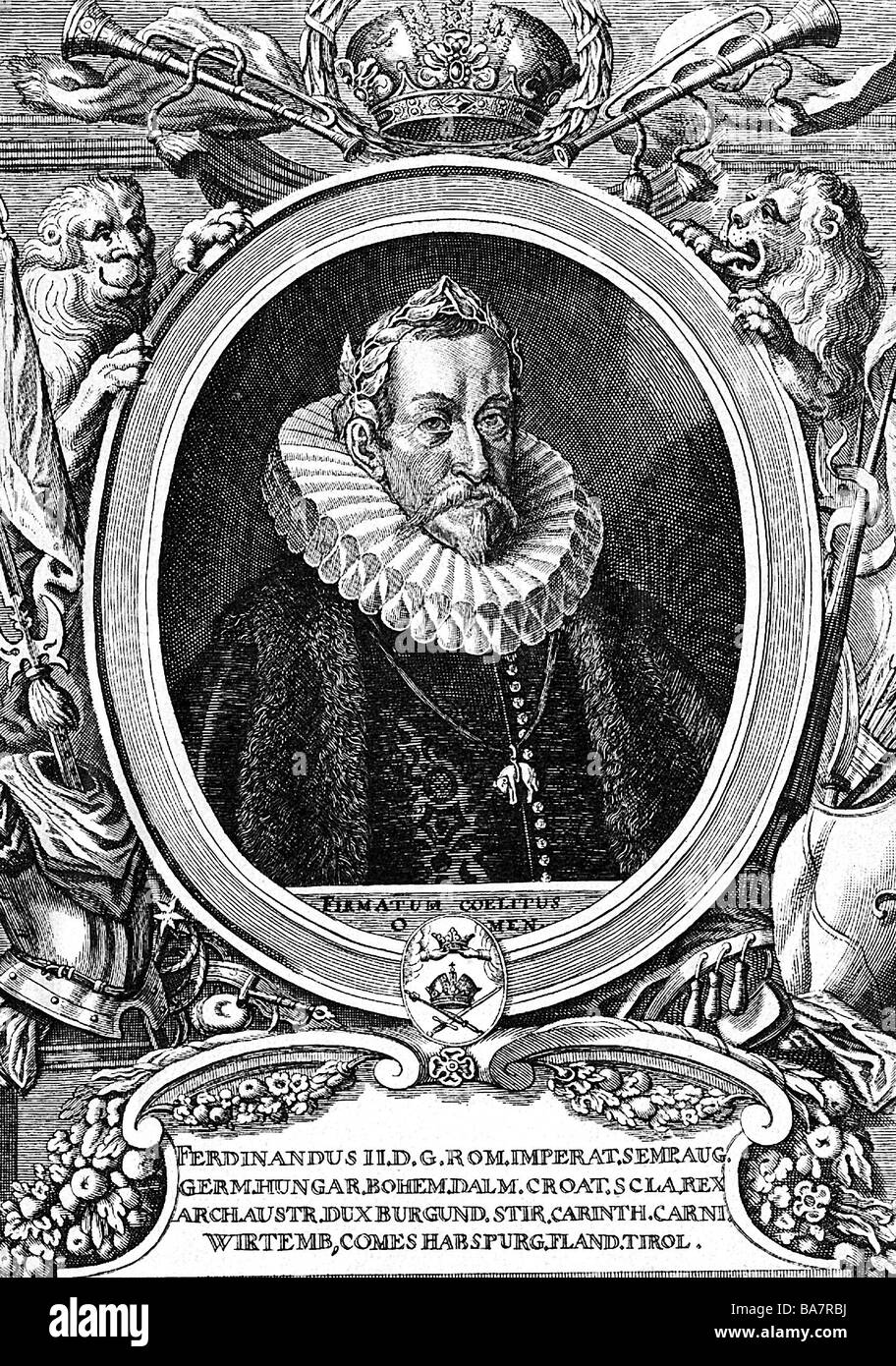 Ferdinand II, 9.9.1578 - 15.2 1637, Holy Roman Emperor, portrait, wood engraving, , Stock Photohttps://www.alamy.com/image-license-details/?v=1https://www.alamy.com/stock-photo-ferdinand-ii-991578-152-1637-holy-roman-emperor-portrait-wood-engraving-23528950.html
Ferdinand II, 9.9.1578 - 15.2 1637, Holy Roman Emperor, portrait, wood engraving, , Stock Photohttps://www.alamy.com/image-license-details/?v=1https://www.alamy.com/stock-photo-ferdinand-ii-991578-152-1637-holy-roman-emperor-portrait-wood-engraving-23528950.htmlRMBA7RBJ–Ferdinand II, 9.9.1578 - 15.2 1637, Holy Roman Emperor, portrait, wood engraving, ,
 Ferdinand II, Holy Roman Emperor Stock Photohttps://www.alamy.com/image-license-details/?v=1https://www.alamy.com/stock-photo-ferdinand-ii-holy-roman-emperor-132689147.html
Ferdinand II, Holy Roman Emperor Stock Photohttps://www.alamy.com/image-license-details/?v=1https://www.alamy.com/stock-photo-ferdinand-ii-holy-roman-emperor-132689147.htmlRMHKTEA3–Ferdinand II, Holy Roman Emperor
 The Defenestration of Prague occurred on May 23, 1618, when a group of Protestant nobles in Bohemia threw two representatives of the Habsburg Emperor out of a window of the Prague Castle. The incident marked the beginning of the Bohemian Revolt and the Thirty Years' War, which engulfed much of Europe in a devastating conflict. The Defenestration symbolized the deep religious and political tensions in the Holy Roman Empire, particularly between the Catholic Habsburgs and the Protestant Bohemians Stock Photohttps://www.alamy.com/image-license-details/?v=1https://www.alamy.com/the-defenestration-of-prague-occurred-on-may-23-1618-when-a-group-of-protestant-nobles-in-bohemia-threw-two-representatives-of-the-habsburg-emperor-out-of-a-window-of-the-prague-castle-the-incident-marked-the-beginning-of-the-bohemian-revolt-and-the-thirty-years-war-which-engulfed-much-of-europe-in-a-devastating-conflict-the-defenestration-symbolized-the-deep-religious-and-political-tensions-in-the-holy-roman-empire-particularly-between-the-catholic-habsburgs-and-the-protestant-bohemians-image543992839.html
The Defenestration of Prague occurred on May 23, 1618, when a group of Protestant nobles in Bohemia threw two representatives of the Habsburg Emperor out of a window of the Prague Castle. The incident marked the beginning of the Bohemian Revolt and the Thirty Years' War, which engulfed much of Europe in a devastating conflict. The Defenestration symbolized the deep religious and political tensions in the Holy Roman Empire, particularly between the Catholic Habsburgs and the Protestant Bohemians Stock Photohttps://www.alamy.com/image-license-details/?v=1https://www.alamy.com/the-defenestration-of-prague-occurred-on-may-23-1618-when-a-group-of-protestant-nobles-in-bohemia-threw-two-representatives-of-the-habsburg-emperor-out-of-a-window-of-the-prague-castle-the-incident-marked-the-beginning-of-the-bohemian-revolt-and-the-thirty-years-war-which-engulfed-much-of-europe-in-a-devastating-conflict-the-defenestration-symbolized-the-deep-religious-and-political-tensions-in-the-holy-roman-empire-particularly-between-the-catholic-habsburgs-and-the-protestant-bohemians-image543992839.htmlRM2PH10BK–The Defenestration of Prague occurred on May 23, 1618, when a group of Protestant nobles in Bohemia threw two representatives of the Habsburg Emperor out of a window of the Prague Castle. The incident marked the beginning of the Bohemian Revolt and the Thirty Years' War, which engulfed much of Europe in a devastating conflict. The Defenestration symbolized the deep religious and political tensions in the Holy Roman Empire, particularly between the Catholic Habsburgs and the Protestant Bohemians
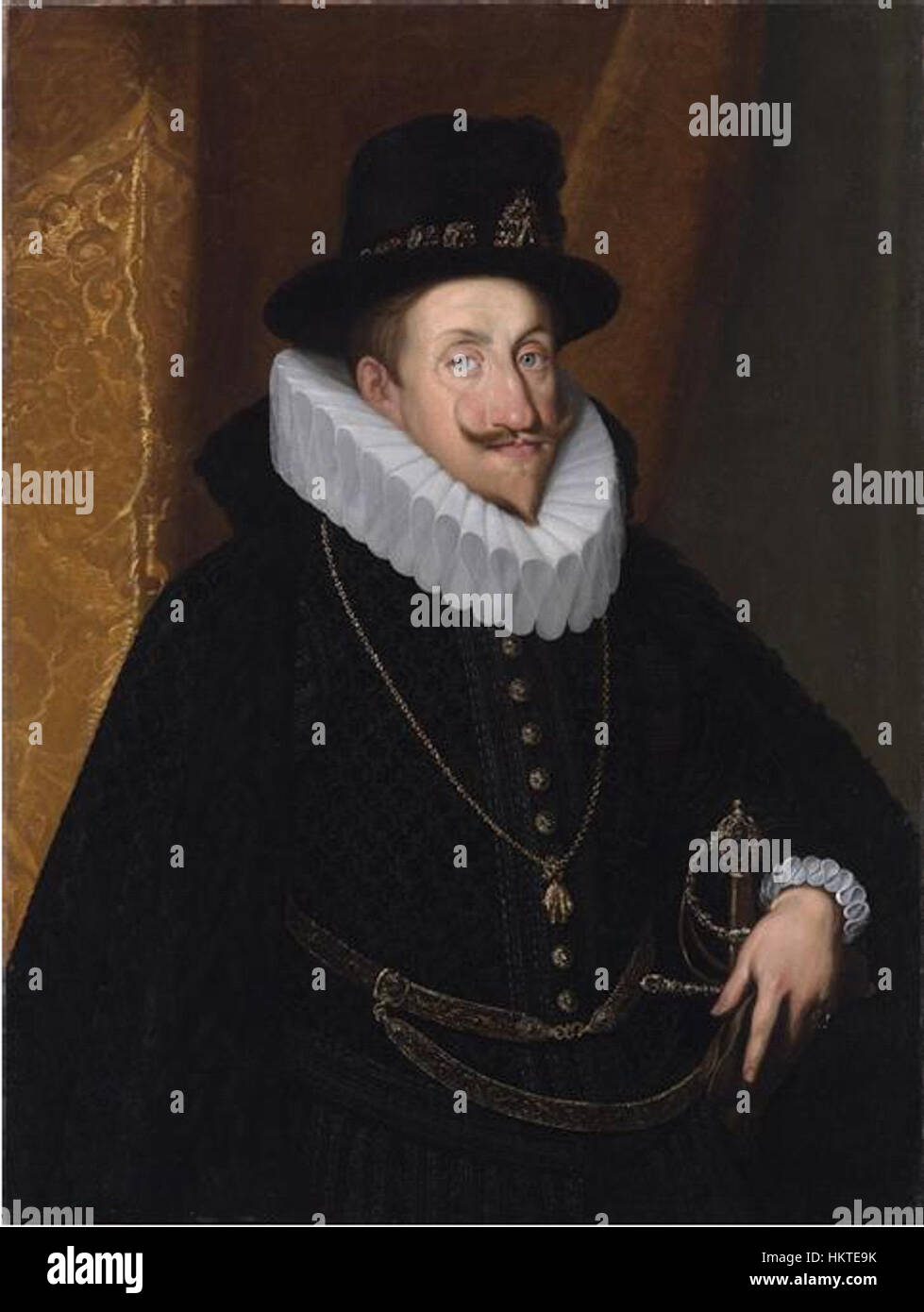 Ferdinand II King of Bohemia Holy Roman Emperor Stock Photohttps://www.alamy.com/image-license-details/?v=1https://www.alamy.com/stock-photo-ferdinand-ii-king-of-bohemia-holy-roman-emperor-132689135.html
Ferdinand II King of Bohemia Holy Roman Emperor Stock Photohttps://www.alamy.com/image-license-details/?v=1https://www.alamy.com/stock-photo-ferdinand-ii-king-of-bohemia-holy-roman-emperor-132689135.htmlRMHKTE9K–Ferdinand II King of Bohemia Holy Roman Emperor
 Ferdinand II, 9 July 1578 - 15 February 1637, was Emperor of the Holy Roman Empire from 1619 until his death / Ferdinand II., 9. Juli 1578 - 15. Februar 1637, war von 1619 bis zu seinem Tode Kaiser des Heiligen Römischen Reiches, Historisch, digital improved reproduction of an original from the 19th century / digitale Reproduktion einer Originalvorlage aus dem 19. Jahrhundert Stock Photohttps://www.alamy.com/image-license-details/?v=1https://www.alamy.com/ferdinand-ii-9-july-1578-15-february-1637-was-emperor-of-the-holy-roman-empire-from-1619-until-his-death-ferdinand-ii-9-juli-1578-15-februar-1637-war-von-1619-bis-zu-seinem-tode-kaiser-des-heiligen-rmischen-reiches-historisch-digital-improved-reproduction-of-an-original-from-the-19th-century-digitale-reproduktion-einer-originalvorlage-aus-dem-19-jahrhundert-image352937704.html
Ferdinand II, 9 July 1578 - 15 February 1637, was Emperor of the Holy Roman Empire from 1619 until his death / Ferdinand II., 9. Juli 1578 - 15. Februar 1637, war von 1619 bis zu seinem Tode Kaiser des Heiligen Römischen Reiches, Historisch, digital improved reproduction of an original from the 19th century / digitale Reproduktion einer Originalvorlage aus dem 19. Jahrhundert Stock Photohttps://www.alamy.com/image-license-details/?v=1https://www.alamy.com/ferdinand-ii-9-july-1578-15-february-1637-was-emperor-of-the-holy-roman-empire-from-1619-until-his-death-ferdinand-ii-9-juli-1578-15-februar-1637-war-von-1619-bis-zu-seinem-tode-kaiser-des-heiligen-rmischen-reiches-historisch-digital-improved-reproduction-of-an-original-from-the-19th-century-digitale-reproduktion-einer-originalvorlage-aus-dem-19-jahrhundert-image352937704.htmlRF2BE5KJ0–Ferdinand II, 9 July 1578 - 15 February 1637, was Emperor of the Holy Roman Empire from 1619 until his death / Ferdinand II., 9. Juli 1578 - 15. Februar 1637, war von 1619 bis zu seinem Tode Kaiser des Heiligen Römischen Reiches, Historisch, digital improved reproduction of an original from the 19th century / digitale Reproduktion einer Originalvorlage aus dem 19. Jahrhundert
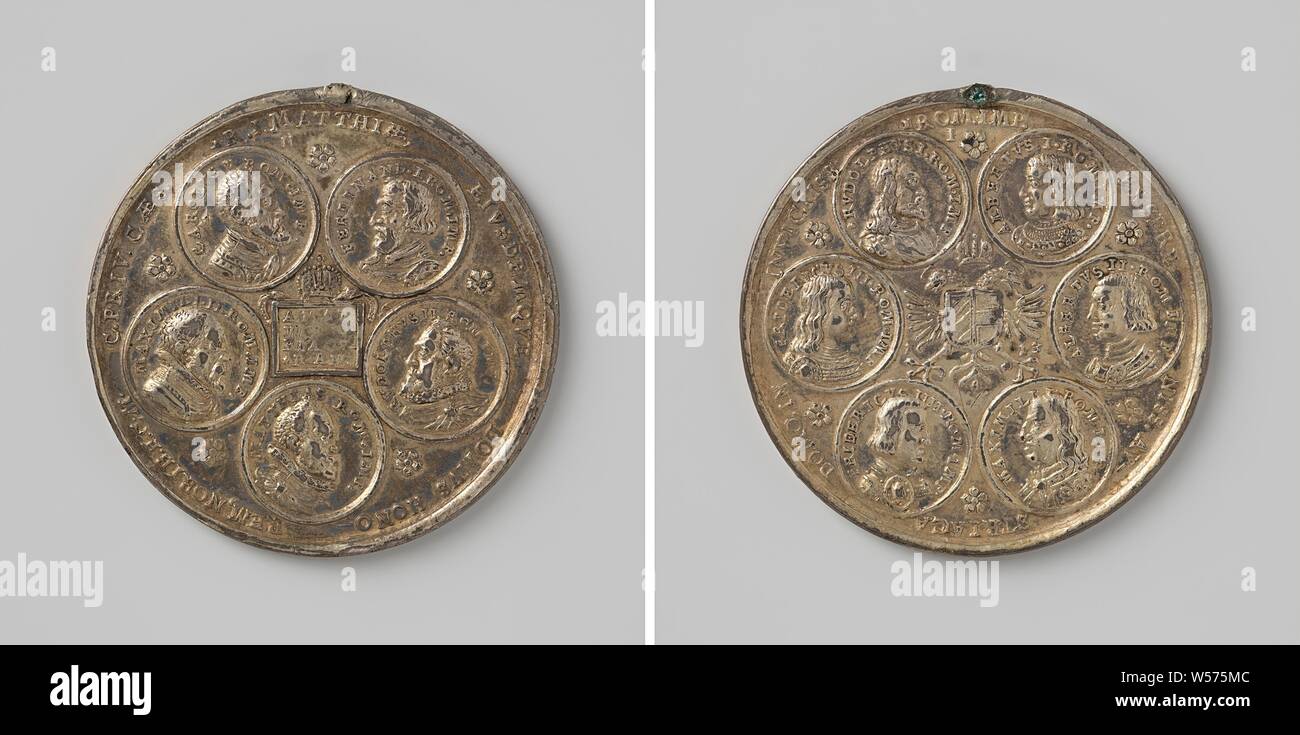 Coronation of Emperor Matthias, from a noble family, Copper Medal. Front: five portrait medals of German emperors (Charles V, Ferdinand I, Rudolf II, Matthias, Maximilian II) within a circular. Reverse: six portet medals of German emperors (Rudolf I, Albert I, Albert II, Maximilian I, Frederick III I, Frederick III) with in between arms of Oosterijk within a circumference., Charles V of Habsburg (German emperor and king of Spain), Ferdinand I of Habsburg (German Emperor), Maximilian II (German Emperor), Rudolf II of Habsburg (German Emperor), Matthias of Austria (Roman-German Emperor), Rudolf Stock Photohttps://www.alamy.com/image-license-details/?v=1https://www.alamy.com/coronation-of-emperor-matthias-from-a-noble-family-copper-medal-front-five-portrait-medals-of-german-emperors-charles-v-ferdinand-i-rudolf-ii-matthias-maximilian-ii-within-a-circular-reverse-six-portet-medals-of-german-emperors-rudolf-i-albert-i-albert-ii-maximilian-i-frederick-iii-i-frederick-iii-with-in-between-arms-of-oosterijk-within-a-circumference-charles-v-of-habsburg-german-emperor-and-king-of-spain-ferdinand-i-of-habsburg-german-emperor-maximilian-ii-german-emperor-rudolf-ii-of-habsburg-german-emperor-matthias-of-austria-roman-german-emperor-rudolf-image261386956.html
Coronation of Emperor Matthias, from a noble family, Copper Medal. Front: five portrait medals of German emperors (Charles V, Ferdinand I, Rudolf II, Matthias, Maximilian II) within a circular. Reverse: six portet medals of German emperors (Rudolf I, Albert I, Albert II, Maximilian I, Frederick III I, Frederick III) with in between arms of Oosterijk within a circumference., Charles V of Habsburg (German emperor and king of Spain), Ferdinand I of Habsburg (German Emperor), Maximilian II (German Emperor), Rudolf II of Habsburg (German Emperor), Matthias of Austria (Roman-German Emperor), Rudolf Stock Photohttps://www.alamy.com/image-license-details/?v=1https://www.alamy.com/coronation-of-emperor-matthias-from-a-noble-family-copper-medal-front-five-portrait-medals-of-german-emperors-charles-v-ferdinand-i-rudolf-ii-matthias-maximilian-ii-within-a-circular-reverse-six-portet-medals-of-german-emperors-rudolf-i-albert-i-albert-ii-maximilian-i-frederick-iii-i-frederick-iii-with-in-between-arms-of-oosterijk-within-a-circumference-charles-v-of-habsburg-german-emperor-and-king-of-spain-ferdinand-i-of-habsburg-german-emperor-maximilian-ii-german-emperor-rudolf-ii-of-habsburg-german-emperor-matthias-of-austria-roman-german-emperor-rudolf-image261386956.htmlRMW575MC–Coronation of Emperor Matthias, from a noble family, Copper Medal. Front: five portrait medals of German emperors (Charles V, Ferdinand I, Rudolf II, Matthias, Maximilian II) within a circular. Reverse: six portet medals of German emperors (Rudolf I, Albert I, Albert II, Maximilian I, Frederick III I, Frederick III) with in between arms of Oosterijk within a circumference., Charles V of Habsburg (German emperor and king of Spain), Ferdinand I of Habsburg (German Emperor), Maximilian II (German Emperor), Rudolf II of Habsburg (German Emperor), Matthias of Austria (Roman-German Emperor), Rudolf
 Ferdinand II (* July 9, 1578; † February 15, 1637) was from 1619 until his death Emperor of the Holy Roman Empire / Ferdinand II. (* 9. Juli 1578; † 15. Februar 1637) war von 1619 bis zu seinem Tode Kaiser des Heiligen Roemischen Reiches, historical, digital improved reproduction of an original from the 19th century / digitale Reproduktion einer Originalvorlage aus dem 19. Jahrhundert Stock Photohttps://www.alamy.com/image-license-details/?v=1https://www.alamy.com/ferdinand-ii-july-9-1578-february-15-1637-was-from-1619-until-his-death-emperor-of-the-holy-roman-empire-ferdinand-ii-9-juli-1578-15-februar-1637-war-von-1619-bis-zu-seinem-tode-kaiser-des-heiligen-roemischen-reiches-historical-digital-improved-reproduction-of-an-original-from-the-19th-century-digitale-reproduktion-einer-originalvorlage-aus-dem-19-jahrhundert-image364457445.html
Ferdinand II (* July 9, 1578; † February 15, 1637) was from 1619 until his death Emperor of the Holy Roman Empire / Ferdinand II. (* 9. Juli 1578; † 15. Februar 1637) war von 1619 bis zu seinem Tode Kaiser des Heiligen Roemischen Reiches, historical, digital improved reproduction of an original from the 19th century / digitale Reproduktion einer Originalvorlage aus dem 19. Jahrhundert Stock Photohttps://www.alamy.com/image-license-details/?v=1https://www.alamy.com/ferdinand-ii-july-9-1578-february-15-1637-was-from-1619-until-his-death-emperor-of-the-holy-roman-empire-ferdinand-ii-9-juli-1578-15-februar-1637-war-von-1619-bis-zu-seinem-tode-kaiser-des-heiligen-roemischen-reiches-historical-digital-improved-reproduction-of-an-original-from-the-19th-century-digitale-reproduktion-einer-originalvorlage-aus-dem-19-jahrhundert-image364457445.htmlRF2C4XD59–Ferdinand II (* July 9, 1578; † February 15, 1637) was from 1619 until his death Emperor of the Holy Roman Empire / Ferdinand II. (* 9. Juli 1578; † 15. Februar 1637) war von 1619 bis zu seinem Tode Kaiser des Heiligen Roemischen Reiches, historical, digital improved reproduction of an original from the 19th century / digitale Reproduktion einer Originalvorlage aus dem 19. Jahrhundert
 Ruler: Ferdinand II, Holy Roman Emperor, Austrian, 1578–1637, ruled 1619–37, Mint: Augsburg, 1/2 Thaler of Ferdinand II, Holy Roman Emperor from Augsburg, Silver, 14.50 g, 12:00, 34.4 mm, Made in Augsburg, Germany, German, 17th century, Numismatics Stock Photohttps://www.alamy.com/image-license-details/?v=1https://www.alamy.com/ruler-ferdinand-ii-holy-roman-emperor-austrian-15781637-ruled-161937-mint-augsburg-12-thaler-of-ferdinand-ii-holy-roman-emperor-fromaugsburg-silver-1450-g-1200-344mm-made-in-augsburg-germany-german-17thcentury-numismatics-image392966423.html
Ruler: Ferdinand II, Holy Roman Emperor, Austrian, 1578–1637, ruled 1619–37, Mint: Augsburg, 1/2 Thaler of Ferdinand II, Holy Roman Emperor from Augsburg, Silver, 14.50 g, 12:00, 34.4 mm, Made in Augsburg, Germany, German, 17th century, Numismatics Stock Photohttps://www.alamy.com/image-license-details/?v=1https://www.alamy.com/ruler-ferdinand-ii-holy-roman-emperor-austrian-15781637-ruled-161937-mint-augsburg-12-thaler-of-ferdinand-ii-holy-roman-emperor-fromaugsburg-silver-1450-g-1200-344mm-made-in-augsburg-germany-german-17thcentury-numismatics-image392966423.htmlRM2DR94K3–Ruler: Ferdinand II, Holy Roman Emperor, Austrian, 1578–1637, ruled 1619–37, Mint: Augsburg, 1/2 Thaler of Ferdinand II, Holy Roman Emperor from Augsburg, Silver, 14.50 g, 12:00, 34.4 mm, Made in Augsburg, Germany, German, 17th century, Numismatics
 Ferdinand II (1578-1637) was the son of Charles II, Archduke of Austria, and grandson of Emperor Ferdinand I. Ferdinand was part of a Catholic faction opposed to his cousin, Emperor Matthias, who was more tolerant to Protestantism. He became King of Bohemia in 1617, King of Hungary in 1618, and became Holy Roman Emperor in 1619 after his cousin's death. Stock Photohttps://www.alamy.com/image-license-details/?v=1https://www.alamy.com/ferdinand-ii-1578-1637-was-the-son-of-charles-ii-archduke-of-austria-and-grandson-of-emperor-ferdinand-i-ferdinand-was-part-of-a-catholic-faction-opposed-to-his-cousin-emperor-matthias-who-was-more-tolerant-to-protestantism-he-became-king-of-bohemia-in-1617-king-of-hungary-in-1618-and-became-holy-roman-emperor-in-1619-after-his-cousins-death-image344282114.html
Ferdinand II (1578-1637) was the son of Charles II, Archduke of Austria, and grandson of Emperor Ferdinand I. Ferdinand was part of a Catholic faction opposed to his cousin, Emperor Matthias, who was more tolerant to Protestantism. He became King of Bohemia in 1617, King of Hungary in 1618, and became Holy Roman Emperor in 1619 after his cousin's death. Stock Photohttps://www.alamy.com/image-license-details/?v=1https://www.alamy.com/ferdinand-ii-1578-1637-was-the-son-of-charles-ii-archduke-of-austria-and-grandson-of-emperor-ferdinand-i-ferdinand-was-part-of-a-catholic-faction-opposed-to-his-cousin-emperor-matthias-who-was-more-tolerant-to-protestantism-he-became-king-of-bohemia-in-1617-king-of-hungary-in-1618-and-became-holy-roman-emperor-in-1619-after-his-cousins-death-image344282114.htmlRM2B03B9P–Ferdinand II (1578-1637) was the son of Charles II, Archduke of Austria, and grandson of Emperor Ferdinand I. Ferdinand was part of a Catholic faction opposed to his cousin, Emperor Matthias, who was more tolerant to Protestantism. He became King of Bohemia in 1617, King of Hungary in 1618, and became Holy Roman Emperor in 1619 after his cousin's death.